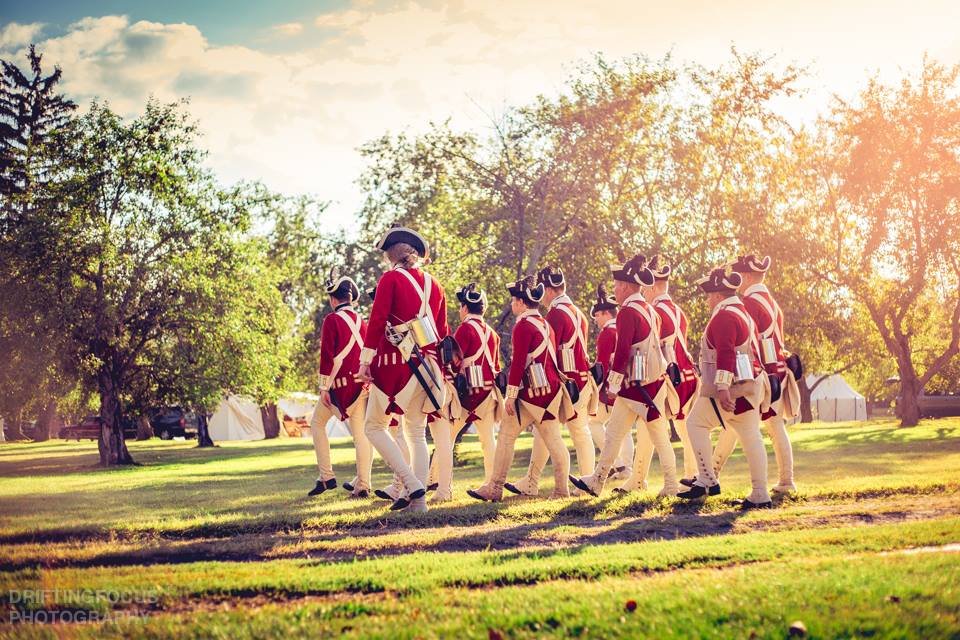
Revisit the best of the blogs from 17th and friends!
Our Officers and Men Behaved Like Men Determined To Be Free
The Battle of Stony Point, Recreated
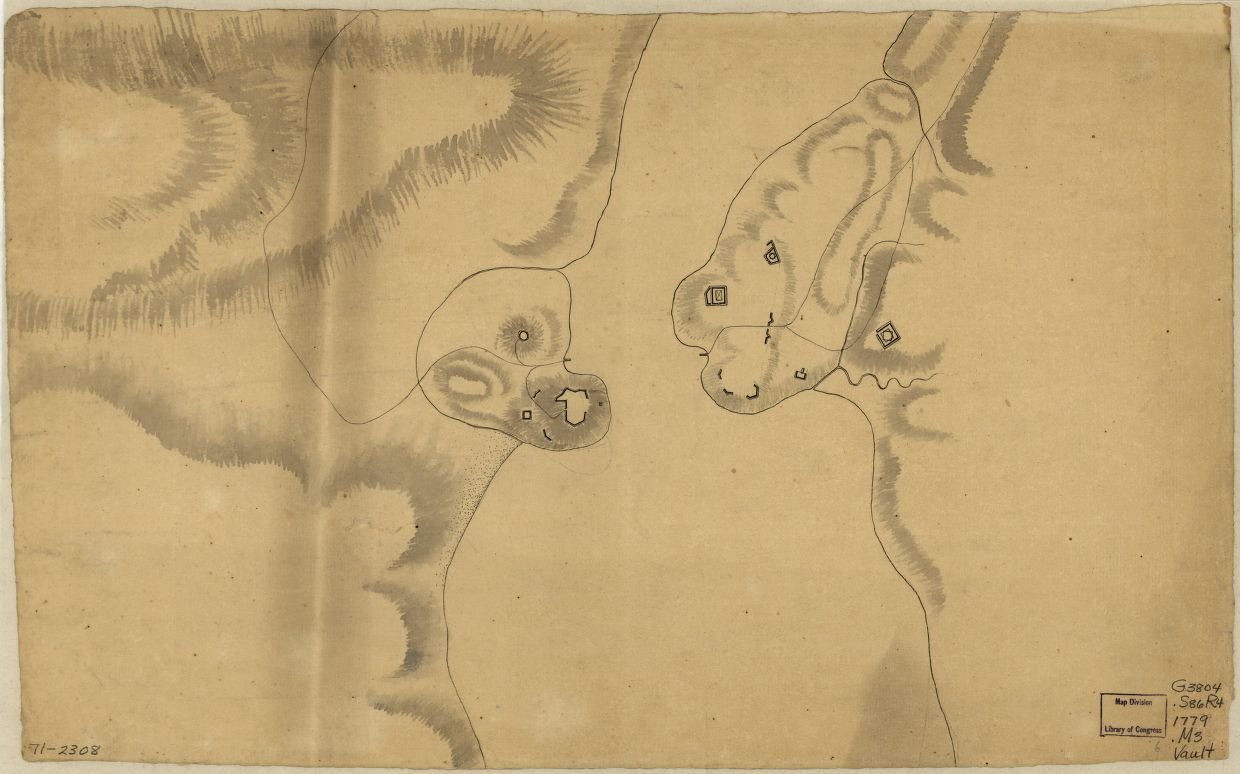
The night of July 15th, 1779 may have started out as a perfectly normal evening for the roughly 500 British soldiers and 70 women and children stationed at Stony Point. It would erupt into musketry and the clash of steel as American troops would surge over the earthworks.
“The works were manned by eight companies of the 17th Regiment of Foot, which had arrived in America in 1775 and were veterans of many of the major battles fought thus far; two companies of grenadiers from the 71st Regiment of Foot (Fraser’s Highlanders), another veteran regiment; sixty-nine men of the Loyal American Regiment, a regiment of Loyalists whose colonel lived twelve miles north of Stony Point; and a number of servants and artisans. In all, the garrison of Stony Point amounted to 564 men.” [2]. These men would be stacked against some of the finest troops the Congressional Army had to throw at them: Anthony Wayne's newly raised Corps of Light Infantry, consisting of four regiments of American troops drawn from all over the States. While the end goal was to secure a vital ferry crossing the Hudson, many consider this battle to be the beginning of the end of the American War of Independence.
The battle was short and brutal. Three columns would carry out the assault: one under the charge of Colonel Butler of Pennsylvania, one with Anthony Wayne, and a third column set out to act as a diversion under the command of Major Hardy Murfree.
Wayne's men set up on the north and south approaches into the post with Murfree in the center with his men. The assault began with Murfree's men firing into the works. The “Forlorn Hope” stormed forth with axes, cleared the abatis, and stormed into the British lines. The columns follow suit, charging forth with bayonets fixed.
As Anthony Wayne led his column up towards the works, he was struck in the head by a musket ball, grazing him but sparing his life. Febiger accepted the surrender on behalf of the American Forces, and the battle is over. [2]
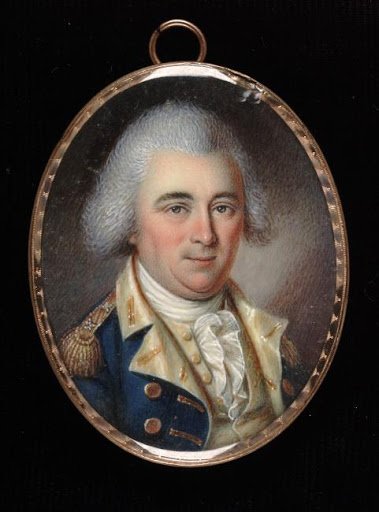
This July we are hoping to recreate what is considered by many to be the “beginning of the end of the American Revolution”. From July 12-14th, American and British reenactors will gather at the Point and try our best to recreate what life might have been like for these men and women.
British forces will have the opportunity to fortify, laying out abatis and wooden fortifications. Women following the army will launder, mend, and ply their trades in the British held position. We hope to recreate what garrison life might have been like for these troops as realistically, accurately, and honorably as possible.
American forces of stout mind and body will be spending Friday a few miles away at Fort Montgomery. They will recreate the night before the assault: mastering the drill, preparing food, and seeing to their laundry and mending rendered by the American followers. Early Saturday morning, the American forces will march along the historical route of march to Stony Point! Fourteen miles through the woods and across the mountains.
The event is shaping up to be one of the best of this year. Reenactors as far west as Iowa, as far north as Maine, and as far south as the Carolinas are coming out to tell the story and bring to life those chaotic days in 1779.
Footnotes:
- Map of Stony and Verplanck Points on the Hudson River as fortified by Sir Henry Clinton June. [?, 1779] Map. https://www.loc.gov/item/gm71002308/.
- Anderson, Eric. ""Our Officers and Men Behaved Like Men Determined To Be Free": The Battle of Stony Point, 15-16 July 1779." The Campaign for the National Museum of the United States Army. July 16, 2018. https://armyhistory.org/our-officers-and-men-behaved-like-men-determined-to-be-free-the-battle-of-stony-point-15-16-july-1779/.
- James Peale, Major-General Anthony Wayne, ca. 1795, watercolor on ivory, Smithsonian American Art Museum, Bequest of Mary Elizabeth Spencer, 1999.27.41
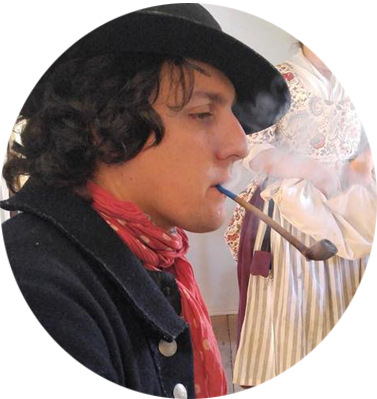 HAYDEN CONLEYJoseph Hayden Conley is currently attending Eastern Michigan University, pursuing a BA in Secondary Education History, He is an avid historian, with a particular love of American Light Infantry during the American Revolution and New Jersey troops during the American Revolution. He has worked for Fort Ticonderoga, as well as Mackinac State Historic Parks in Michigan. He has been apart of the living history community for over 10 years, and is a member of the 3rd New Jersey, Captain Bloomfields Company.
HAYDEN CONLEYJoseph Hayden Conley is currently attending Eastern Michigan University, pursuing a BA in Secondary Education History, He is an avid historian, with a particular love of American Light Infantry during the American Revolution and New Jersey troops during the American Revolution. He has worked for Fort Ticonderoga, as well as Mackinac State Historic Parks in Michigan. He has been apart of the living history community for over 10 years, and is a member of the 3rd New Jersey, Captain Bloomfields Company.
Follow-Up: “Like a Pedlar's Pack.”: Blanket Rolls and Slings
Part 3 to A Hypothesis Regarding British Knapsack Evolution Read Parts 1 & 2.
“Square knapsacks are most convenient …”
While British troops used blanket slings instead of knapsacks during several campaigns, one reason being the “ill Conveniency” of their packs (whatever that might mean), slung blankets had their own inconveniences, one of those being having to undo them every night and re-roll them before marching. Here we have American surgeon Dr. Benjamin Rush’s observations while tending to American wounded after the Battle of Brandywine:
One of the [British] officers, a subaltern, observed to me that his soldiers were infants that required constant attendance, and said as a proof of it that although they had blankets tied to their backs, yet such was their laziness that they would sleep in the dew and cold without them rather than have the trouble of untying and opening them. He said his business every night before he slept was to see that no soldier in his company laid down without a blanket."1
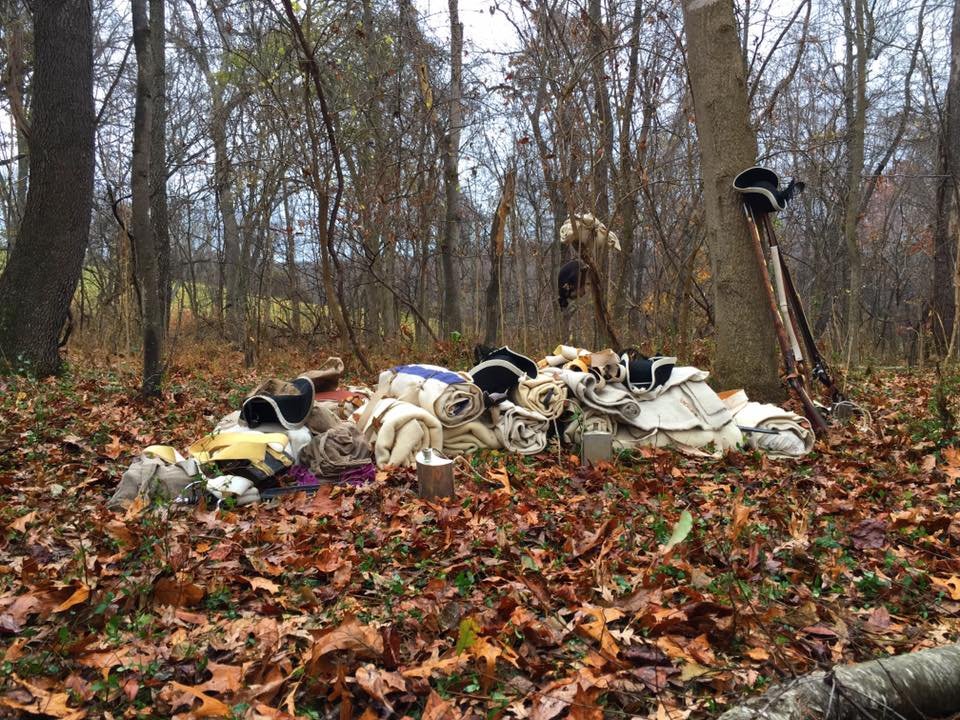
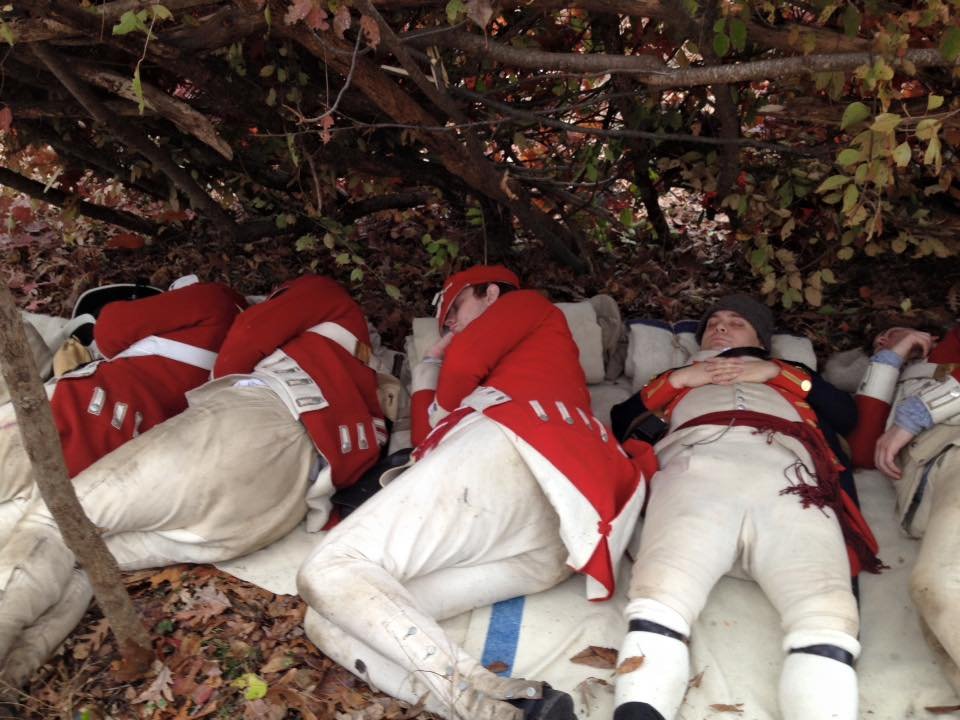 Welbourne Immersion Event 2015
Welbourne Immersion Event 2015
That said, British troops certainly used slings, and likely used rolled blankets slung over the shoulder, as well (see image of 25th Regiment soldier at Minorca, below). Here are a series of British narratives or general orders mentioning blanket slings, or occasions when blankets were to be carried without knapsacks.
84th Regiment, “point au Trimble,” Quebec, 18 August 1776, "Every Man to be pervided With a Topline [tumpline] if Wanted and to prade Opisite the Church, on Thursday Morning With thire Arms Accutements and packs, properly Made up as for a March.”2
Brigade of Guards, orders, 19 August 1776, "When the Brigade disembarks two Gills of Rum at most must be put into each Man's Canteen which must be fill'd up with Water. Every Man is to disembark with a Blanket, in which he is to carry three days provisions, one Shirt, one pair of Socks, & one pair of Shoes. A careful Man to be left on Board each Ship to take care of the Mens Knapsacks, if there are any Convalescents they may be order'd for this.”3
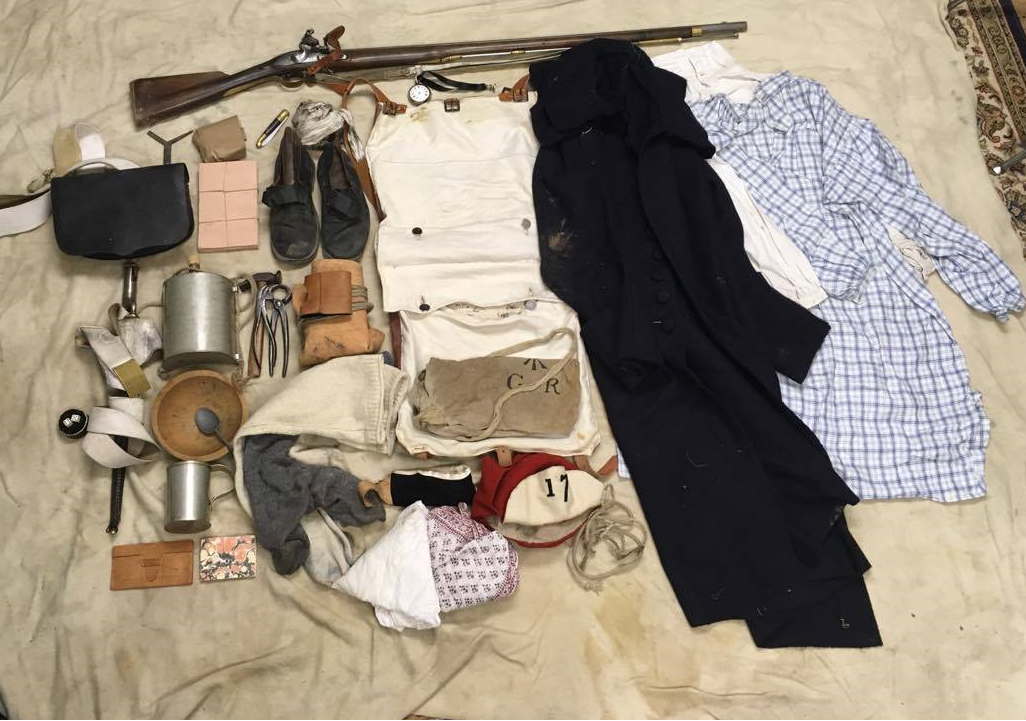
Capt. William Leslie, 17th Regiment of Foot, 2 September 1776, “"Bedford Long Island Sept. 2nd 1776… The Day after their Retreat we had orders to march to the ground we are now encamped upon, near the Village of Bedford: It is now a fortnight we have lain upon the ground wrapt in our Blankets, and thank God who supports us when we stand most in need, I have never enjoyed better health in my Life. My whole stock consists of two shirts 2 pr of shoes, 2 Handkerchiefs half of which I use, the other half I carry in my Blanket, like a Pedlar's Pack."4
Brigade of Guards, orders, 11 March 1777, "The Waistbelts to Carry the Bayonet & to be wore across the Shoulder. The Captains are desired to provide Webbing for Carrying the Mens Blankets according to a pattern to be Seen at the Cantonment of Lt. Colo. Sr. J. Wrottesleys Company. The Serjeants to Observe how they are Sewed. The Officers to Mount Guard with their Fuzees."5
40th Regiment orders regarding blanket slings, wallets, and contents, spring and summer 1777:6 After Regl Orders 7 at Night [10 May 1777]
A Return to be given immediatly from each Company to the Qr. Mr. of the Number of Shoe soles and heels wanting to Compleat each man with a pair to take with him the Ensuing Campaign
The Regt. to parade to morrow Morning at 11 oClock with Arms, Accoutrements & Necessarys in order to be inspected by their Officers -- The Necessarys to be carried in their Wallet and slung over the Right Shoulder --
R[egimental]:O[rders] 14th May 1777
Each Compy. will immediately receive from the Qr. Mr. Serjt. 26 Slings & Wallets to put the quantity of Necesareys Intendd. to be Carrid. to the field Viz 2 shirts 1 pr. of shoes & soles 1 pr. of stockings 1 pr. of socks shoe Brushes, black ball &c Exclusive of the Necessareys they may have on (the[y] must be packd. in the snugest manner & the Blankts. done neatly round very little longer than the Wallets) to be Tyed. very close with the slings and near the end -- the men that are not provided. with A blankett of their own may make use of one [of] the Cleanest Barrick Blanketts for to morrow –
After Regl. Orders 7 at Night [18 May 1777] …
The Regt: to parade to morrow Morning at 11 oClock with Arms, Accoutrements & Necessarys in order to be inspected by their Officers – The Necessarys to be carried in their Wallet and slung over the Right Shoulder … The pipe Clay brought this day from Staten Island to be divided in eight equal parts and each Company to get a dividend it is hoped the Compys: will make better use of this then thay did of the last
[Regimental Orders, 23 May 1777] … The Non Commissd: Offrs: and Men to have their Necessareys Constantly packd: in their Wallets ready to sling in their Blanketts which they are to parade with Every morning at troop beating to Acustom them to do it with Readiness and Dispatch The men of the Qr:Gd: to parade when the taps beat to be properly inspectd: and ready to march of[f] Immediately fter the troop has beat –Morn.g Regl. Orders 2d June 77 …
Black tape to be provided immediately to tie the Mens Hair -- NB It is to be had in Amboy. -- The Mens Hair that is not properly Cut to be done this Day -- Each Company to give in a Return to the Quarr. Masr. of the Number of Wallets & Slings wanting to Compleat each Man as the whole must have them to appear uniform in the slinging on & Carrying their Blankets & Necessarys -- Any of the Wallets or Slings not properly made to be returned to the Masr. Taylor –
R[egimental]:O[rders] [9 June 1777] …
The Commanding Offrs: of Comp[anie]s. are Immediately to settle their Accompts With the Qr: Mr: for the under Mentiond Articles According to the following rates at 4 [shillings]:8d pr Doller
Trowzrs: making &c ....................... £ 4:2 1/2Wallets & Slings. ......................... 2:2 1/2Coats Cuting & Mending when at Hallafax..... 4 1/2Do: Do: at Amboy .......................... 10Diffeichinceis on Breeches clothwhen at Staten Island. ................ 4 1/2 Do: on Leggons ............................. 349th Foot, "Regimental Order on Board the Rochford 21 August 1777 When the Regt. Lands
Every Non Commissd Officer and soldier of the Regiment is to have with him 2 very good Shirts, Stokings, 2 pair Shoes, their Linin drawers, Linnin Leggins, half Gaiters and their Blankets very well Rold. Every thing to be perfectly Clean. Officers Commanding Companies will be answerable to the Commanding Officer that these orders are Strictly Complyed with-“7
Guards, “Brigade Morning Orders 30 August 1779 The Qr. Masters are desir'd to be as expeditious as possible in processing proper Bedding &ca from the Bk. Mr. Genl.-- & Field Blankets from the Qr. Mr. Genl. for the Draughts received from England.-- & to deliver to them from the Regl. Store a proper proportion of Camp Kettles, Canteens & Haversacks.The Companies are desir'd to Compt. their Draughts with proper Straps to Carry their Blankets, & to be as expeditious as possible in Compleating them with Trowsers."8Brigade of Guards, “1st Battn Orders 9 September 1779 The Men lately Joind having received their Field Blankets, the Serjts. are Ordered, to see that they are Mark'd with the Initial Letters of each Mans Name. The Men are to be provided with proper Straps for Carrying them & Shewn how to Roll them up.9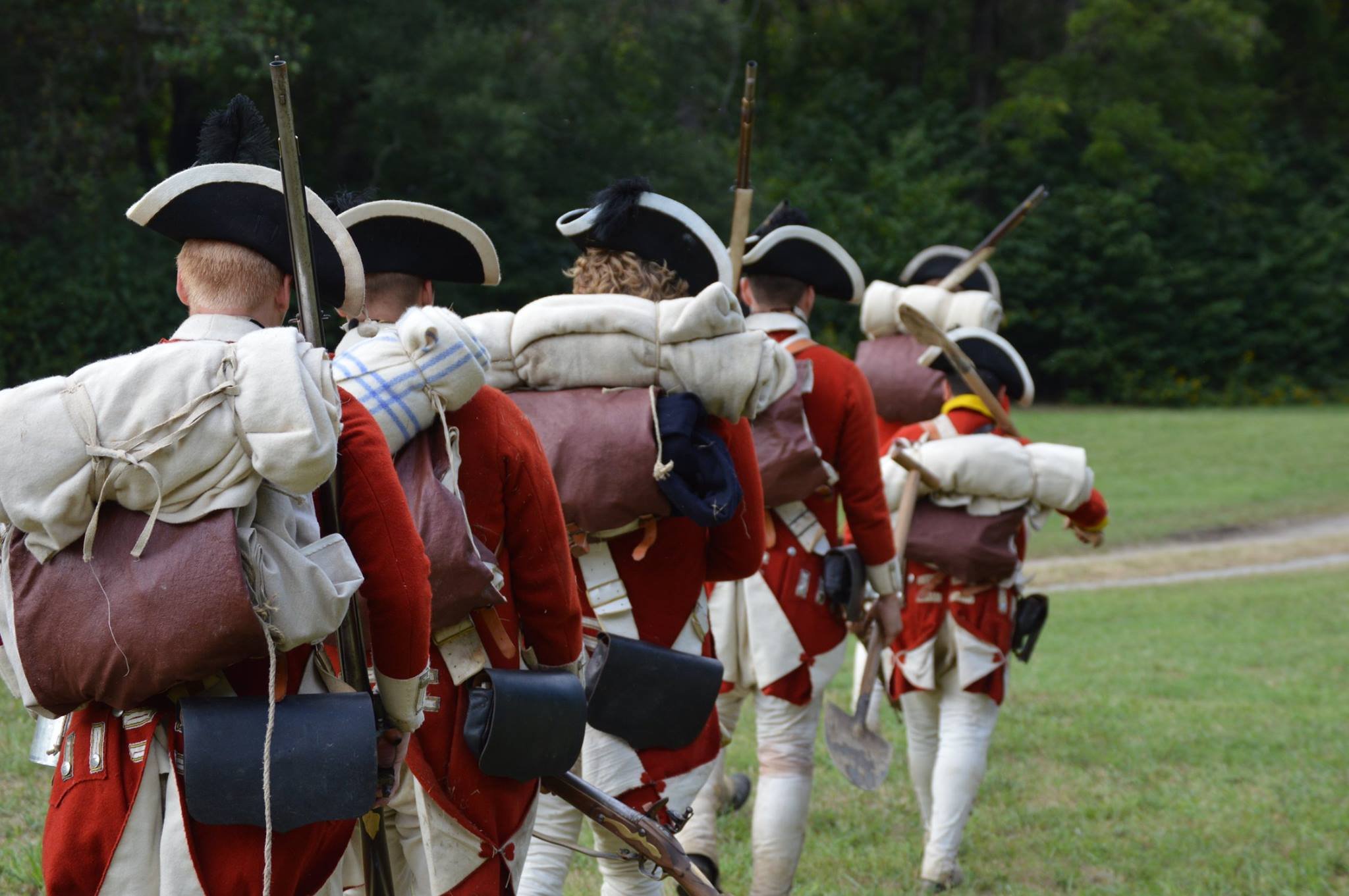
Lt. Gen. Charles Earl Cornwallis’s army, South Carolina, 1780 and 1781:10
On board ship off of Charlestown, South Carolina, 15 December 1780.General orders:
"The Corps to Compt. their Men with Camp Hatchets Canteens, & Kettles ... It is recommended to the Comdg Offrs. of Regts. to provide the Men with Night Caps before they take the Field."
Brigade orders:
"The Necessaries of the Brigde. are to be Imdy. Comptd. to 2 Good pr. Shoes, 2 Shts. & 2 pr. Worsted Stockgs. per Man ... Each Mess to be furnish'd with a Good Camp Kettle, & every Man provided with a Canteen, & Tomahawk - & the Pioneers wth. all kind of Tools. The drumrs. are to carry a good Ax Each & provide themselves with Slings for the Same."
General orders, Ramsour's Mills, 24 January 1781:
"When upon any Occasion the Troops may be Order'd to March without their Packs; it is not intended they Should leave their Camp Kettles and Tomahawks behind them."
Brigade orders, 24 January 1781:
"There being a Sufficient Quantity of Leather to Compleat the Brigade in Shoes ... It is recommended to ... the Commandg. Officers of Companies, see their Mens Shoes immediately Soled & Repaired, & if possible that every Man when they move from this Ground take in his Blankett one pair of Spare Soles ..."
43rd Regiment, Virginia,"Apollo Transport Of[f] Brandon James River 23rd May 1781 …The Quarter Master will issue Canteens Haversacks and Camp Kettles to the Battalion immediately. The Companies to send Returns for their Effectives as this is the only supply the Regiment can possible Receive during the Campaign the Soldiers cannot be to careful to preserve them.Five Regimental Waggons will land with the Regiment. One to each Grand Division the fifth for Major Fergusons Baggage.The Quarter Master will issue an equal proportion of the Trowzers, made since the Embarkation- to each Company to compleat them as near as possible to Two pair per Man.It is positively Ordered that no Soldier lands with more necessaries than his Blanket, Canteen,Haversack, Two pair of Trowzers, Two pair of Stockings, and Two Shirts, and Two pair of good Shoes. The Remaining Necessaries of each Company to be carefully packed up and Orders will be given as soon as possible for its been taken proper care of."11
Footnotes:
- H. Butterfield, ed., Letters of Benjamin Rush, vol. I (Princeton, N.J., 1951), 154-155.
- 84th Regiment order book, Malcolm Fraser Papers, MG 23, K1,Vol 21, Library and Archives Canada.
- "Orderly Book: British Regiment Footguards, New York and New Jersey," a 1st Battalion
Order Book covering August 1776 to January 1777, Early American Orderly Books, 1748-1817, Collections of the New-York Historical Society (Microfilm Edition - Woodbridge, N.J.: Research Publications, Inc.: 1977), reel 3, document 37.
- Sheldon S. Cohen, "Captain William Leslie's 'Paths of Glory,’" New Jersey History, 108 (1990), 63.
- "Howe Orderly Book 1776-1778" (actually a Brigade of Guards Orderly Book from 1st
Battalion beginning 12 March 1776, the day the Brigade for American Service was formed), Manuscript Department, William L. Clements Library, University of Michigan, Ann Arbor.(Courtesy of Linnea Bass.)
- British Orderly Book [40th Regiment of Foot] April 20, 1777 to August 28, 1777, George Washington Papers, Presidential Papers Microfilm (Washington: Library of Congress, 1961), series 6 (Military Papers, 1755-1798), vol. 1, reel 117. See also, John U. Rees, ed., "`Necessarys
… to be Properley Packd: & Slung in their Blanketts’: Selected Transcriptions 40th Regiment ofFoot Order Book,” http://revwar75.com/library/rees/40th.htm
- "Captured British Orderly Book [49th Regiment], 25 June 1777 to 10 September 1777, . George Washington Papers (microfilm), series 6, vol. 1, reel 117.
- "Orderly Book: First Battalion of Guards, British Army, New York" (covers all but a few days of 1779), Early American Orderly Books, N-YHS (microfilm), reel 6, document 77.
- Ibid.
- R. Newsome, ed., "A British Orderly Book, 1780-1781", North Carolina Historical Review, vol. IX (January-October 1932), no. 2, 178-179; no. 3, 286, 287.
- Order book, 43rd Regiment of Foot (British), 23 May 1781 to 25 August 1781, British Museum, London, Mss. 42,449 (transcription by Gilbert V. Riddle).
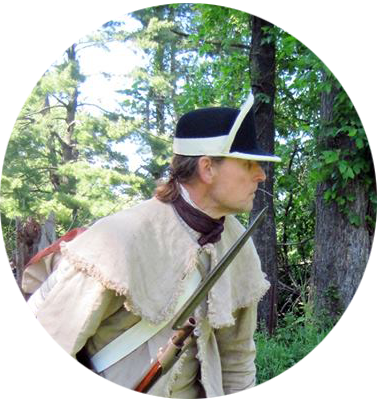 JOHN REESJohn has been involved in American War for Independence living history for 33 years, and began writing on various aspects of the armies in that conflict in 1986. In addition to publishing articles in journals such as Military Collector & Historian and Brigade Dispatch, he was a regular columnist for the quarterly newsletter Food History News for 15 years writing on soldiers’ food, wrote four entries for the Oxford Encyclopedia of American Food and Drink, and thirteen entries for the revised Thomson Gale edition of Boatner’s Encyclopedia of the American Revolution.
JOHN REESJohn has been involved in American War for Independence living history for 33 years, and began writing on various aspects of the armies in that conflict in 1986. In addition to publishing articles in journals such as Military Collector & Historian and Brigade Dispatch, he was a regular columnist for the quarterly newsletter Food History News for 15 years writing on soldiers’ food, wrote four entries for the Oxford Encyclopedia of American Food and Drink, and thirteen entries for the revised Thomson Gale edition of Boatner’s Encyclopedia of the American Revolution.
Many of his works may be accessed online at http://tinyurl.com/jureesarticles .
A Hypothesis Regarding British Knapsack Evolution part 2
While we may never learn the answers to the aforesaid questions, here are several things we do know or think we know. First, we look at a crucial clue in this discussion, but one that is accompanied with some uncertainty and a caveat or two. The first known image of a British double-pouch knapsack (see below) was found in a 71st Regiment manuscript book titled “Standing Regimental Orders in America”; the first half of the volume contains standing orders for 1775 (before the regiment arrived in North America), the second half entries for 1778, beginning 3 June and ending with a 24 August order. The context of the knapsack image is difficult to ascertain but, in my opinion, was likely done in 1778. A caveat – while we can assume it portrays a piece of British equipment, the possibility of the image showing a captured item remains in the realm of possibility. That possibility seems to be lessened by the absence of a descriptor noting such. Added to that, there are indications the British went into the war using single-pouch knapsacks, the 71st order book drawing, likely dating to 1778, being the earliest evidence for the double-pouch variety.

Next, a known item with a supposition attached to it. In February 1776 a contractor sent a proposal to convince the state of Maryland to procure for their troops his “new Invented Napsack and haversack.” In the end numbers of his knapsack were made and issued to several Maryland units, and probably some Pennsylvania and New Jersey troops. Though impossible to prove, an intriguing possibility is that the new British knapsacks were inspired by the American “Napsack and haversack,” a not unreasonable contention given the similarity in design and that the 71st knapsack drawing also shows one pouch designated to carry food.
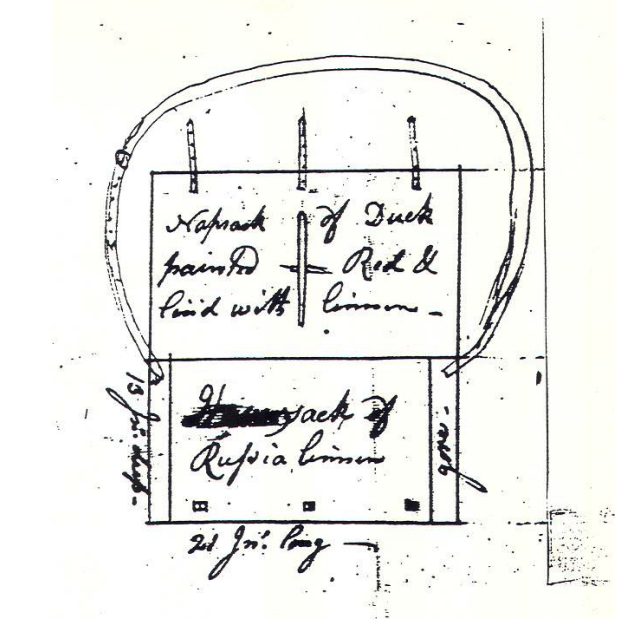
From 1776, we move four years ahead, to Benjamin Warner’s service with Col. John Lamb’s 2d Continental Artillery Regiment. Given that his other tours, from 1775 to 1777, were with state or militia units, and given what we know of America knapsacks during those years, it is most likely his extant knapsack dates from his 1780 stint. Warner’s pack may have been copied from captured British equipment. The practice did occur, perhaps the best known instance being the Continental Army twenty-nine round “New Model” cartridge pouch, copied from British pouches taken with Burgoyne’s troops and first made in Massachusetts in the winter of 1777-78.
(See following page for images of the Warner knapsack.)
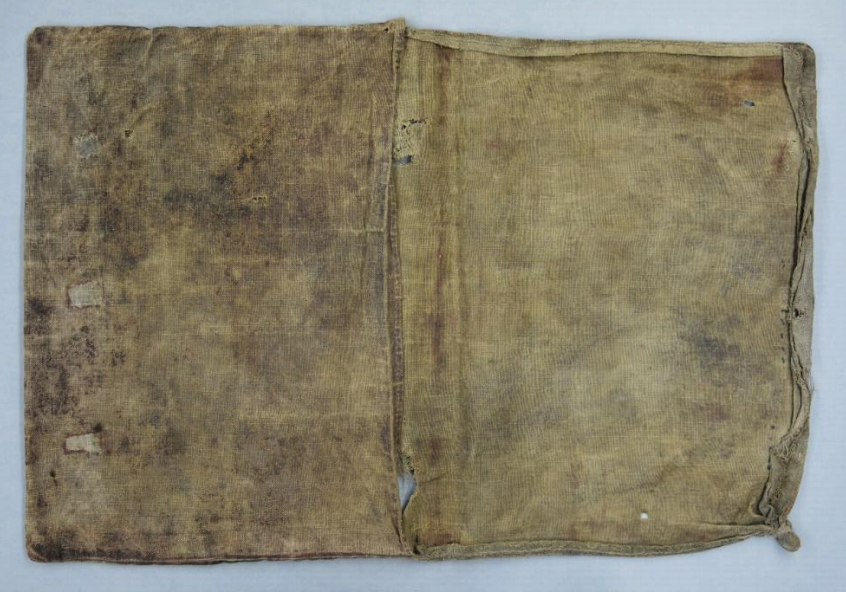 (Above) Benjamin Warner's Revolutionary War knapsack. This artifact has evidence a second pocket on the inside of the outer flap. (Courtesy of Fort Ticonderoga Museum) (Below) Reproduction of Warner knapsack.
(Above) Benjamin Warner's Revolutionary War knapsack. This artifact has evidence a second pocket on the inside of the outer flap. (Courtesy of Fort Ticonderoga Museum) (Below) Reproduction of Warner knapsack.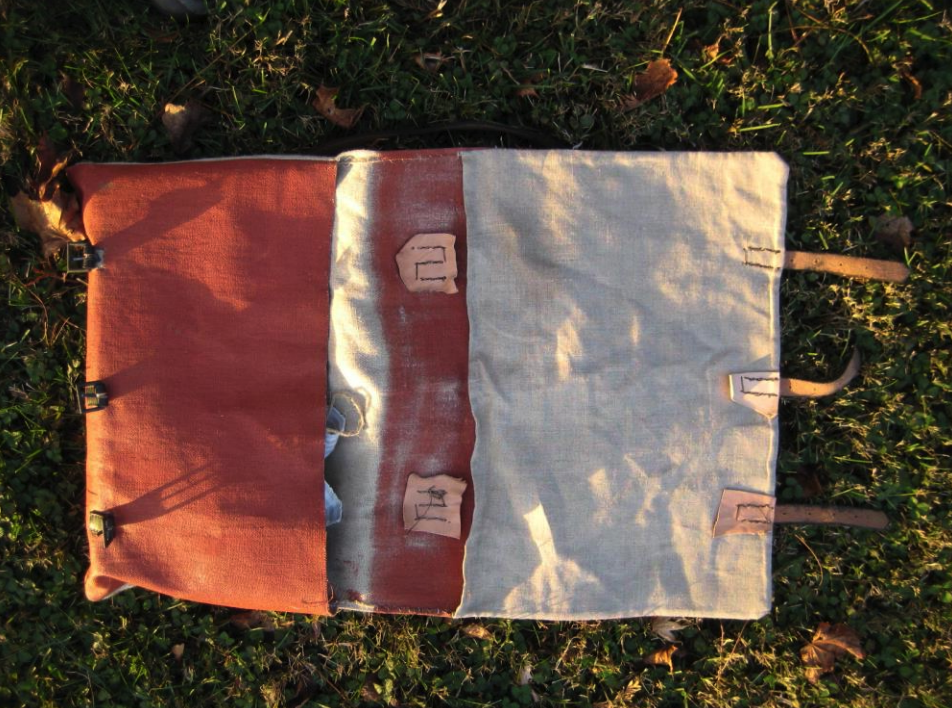 While Benjamin Warner’s existing knapsack is evidence that the Continental Army used doublepouch knapsacks with two shoulder straps by at least 1780, the first documentary mentions date to 1782.Quartermaster General Timothy Pickering to Ralph Pomeroy, D.Q.M., 23 April 1782:
While Benjamin Warner’s existing knapsack is evidence that the Continental Army used doublepouch knapsacks with two shoulder straps by at least 1780, the first documentary mentions date to 1782.Quartermaster General Timothy Pickering to Ralph Pomeroy, D.Q.M., 23 April 1782:
"I observe in your return the mention of upwards of three thousand yards of oznaburghs Tho' this kind of linen is not the best for knapsacks yet they have very commonly been made of it. Of that in your possession I wish you to select immediately the best, & to have one thousand knapsacks made up. They should be made double, & one side painted with the cheapest paints. I will furnish you with Mr. Morris's notes to enable you to pay for this work which cannot cost much. Be pleased to have the knapsacks made with dispatch & forwarded without delay to Colo. Hughes."
Numbered Record Books, National Archives, 1780-July 9, 1787, vol. 26.Timothy Pickering to Peter Anspach, 23 April 1782:
"Desire Mr. [Mery?] to examine the bolts of oznaburghs which came from Virginia, and pick out those fittest for knapsacks, & get as many made as he can: If he would cut out one of a proper shape, he could get some careful woman to cut out the residue, & employ other women to make them up. Let them be made double, & one side painted. Perhaps all the oznaburghs will answer as well as those knapsacks usually made. There are some here which were left or rather contracted for by Col. Mitchel, that are wretched indeed: I think any of our oznaburghs better by far."
Miscellaneous Numbered Records (The Manuscript File) in the War Department Collection of Revolutionary War Records 1775–1790's, National Archives Microfilm Publication M859, (Washington, D.C., 1971), reel 87, item no. 25353.
Also in 1782, Pierre L’Enfant, captain Corps of Engineers, painted a panorama of West Point. To one side are two groups of Continental troops, including several soldiers wearing rolled blankets atop their knapsacks, the first images showing that being done.
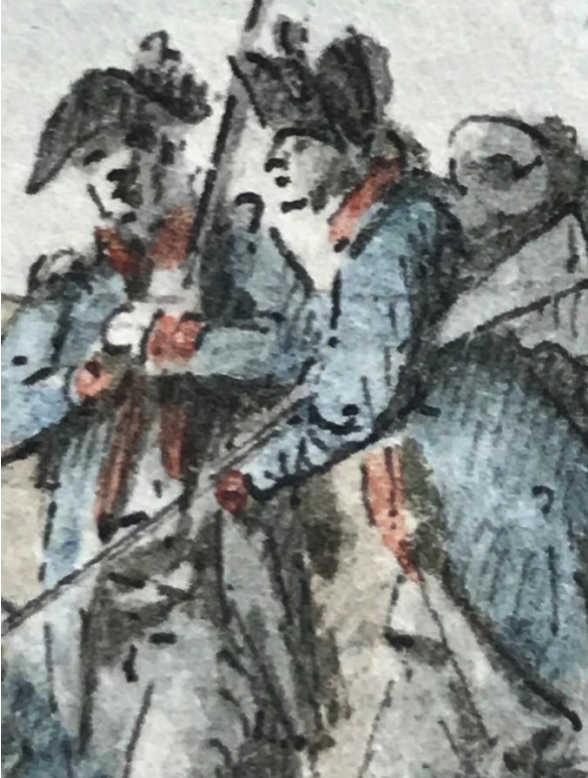 [gallery ids="3826,3825" columns="2" size="full"]
[gallery ids="3826,3825" columns="2" size="full"]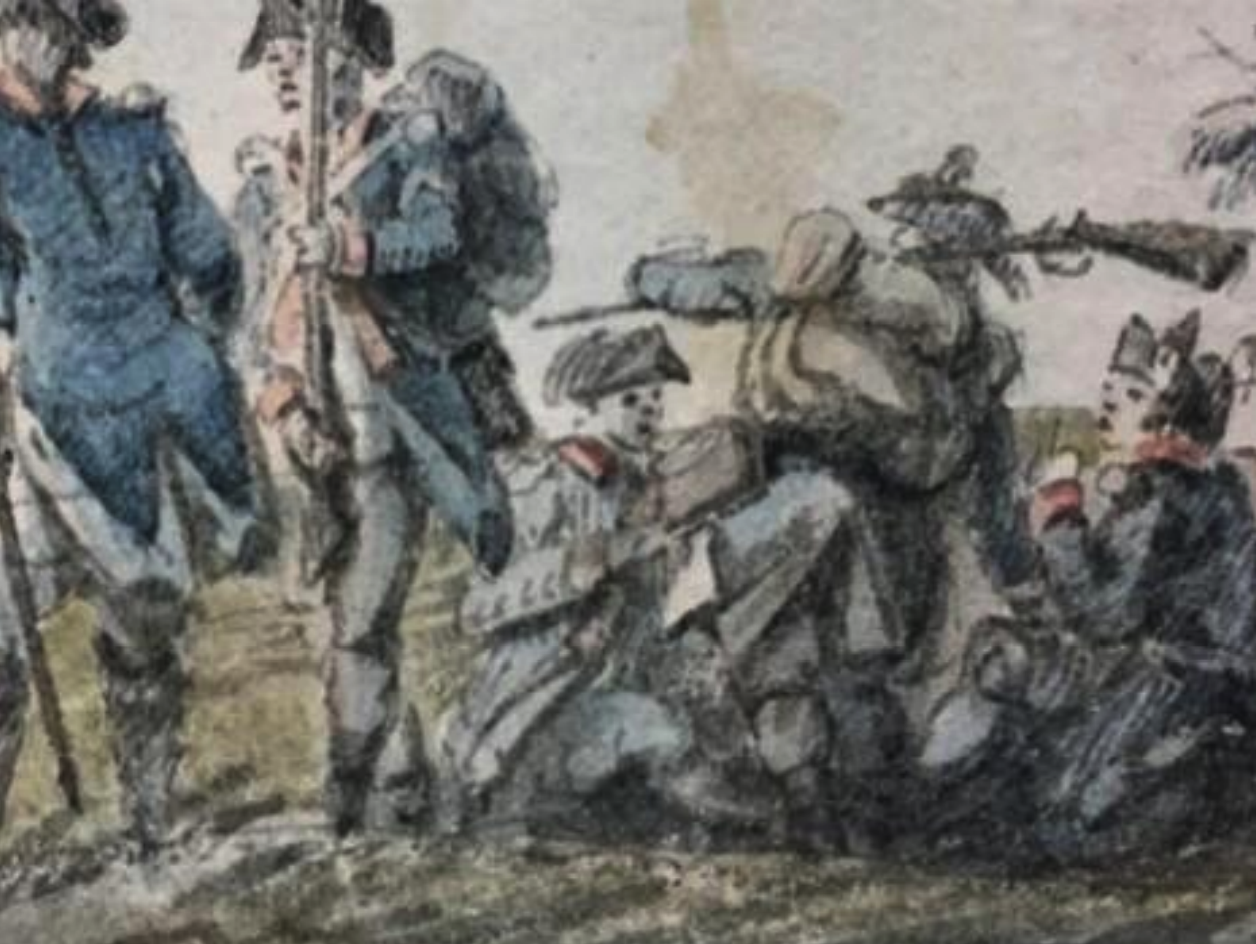 Another painting shows British troops, after their surrender at Saratoga in October 1777, with rolled blankets attached to their knapsacks. Unfortunately, the painter, James Peale, was not an eyewitness, and executed the image in 1799 or 1800.
Another painting shows British troops, after their surrender at Saratoga in October 1777, with rolled blankets attached to their knapsacks. Unfortunately, the painter, James Peale, was not an eyewitness, and executed the image in 1799 or 1800.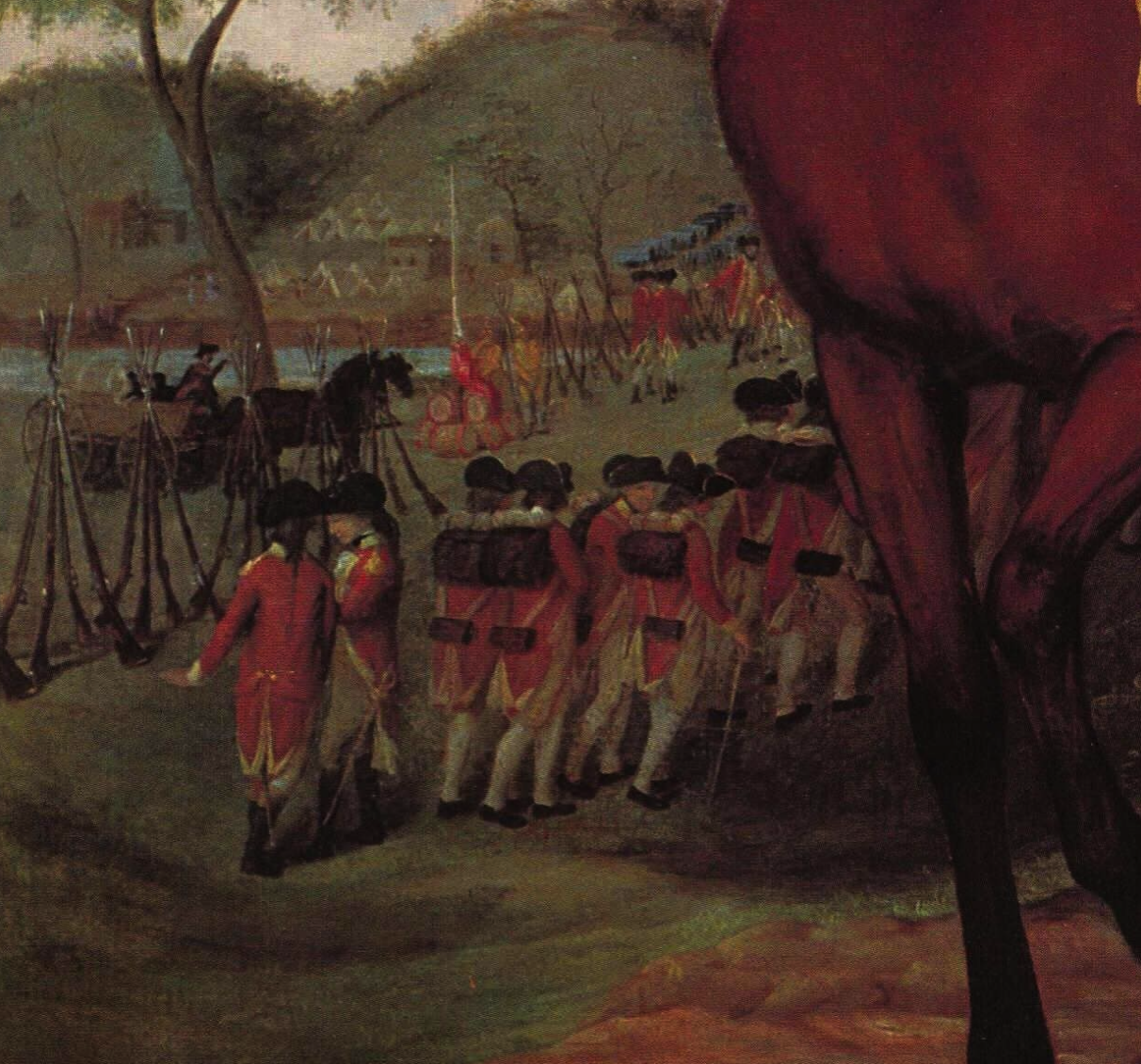
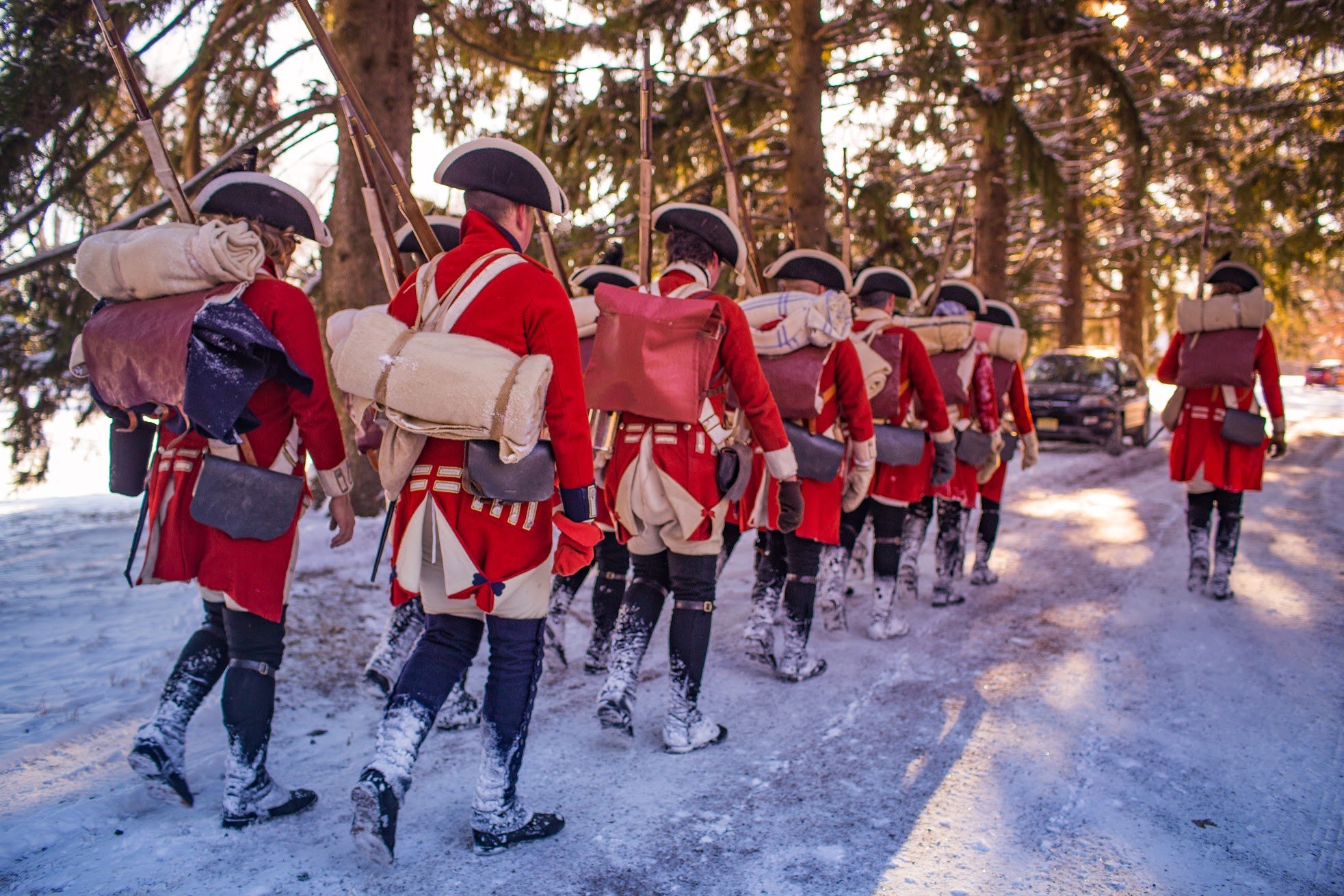 Rounding out this discussion, we close with images of the earliest known surviving British double-pouch knapsack, dated to 1794 and attributed to the 97th Inverness Regiment.
Rounding out this discussion, we close with images of the earliest known surviving British double-pouch knapsack, dated to 1794 and attributed to the 97th Inverness Regiment.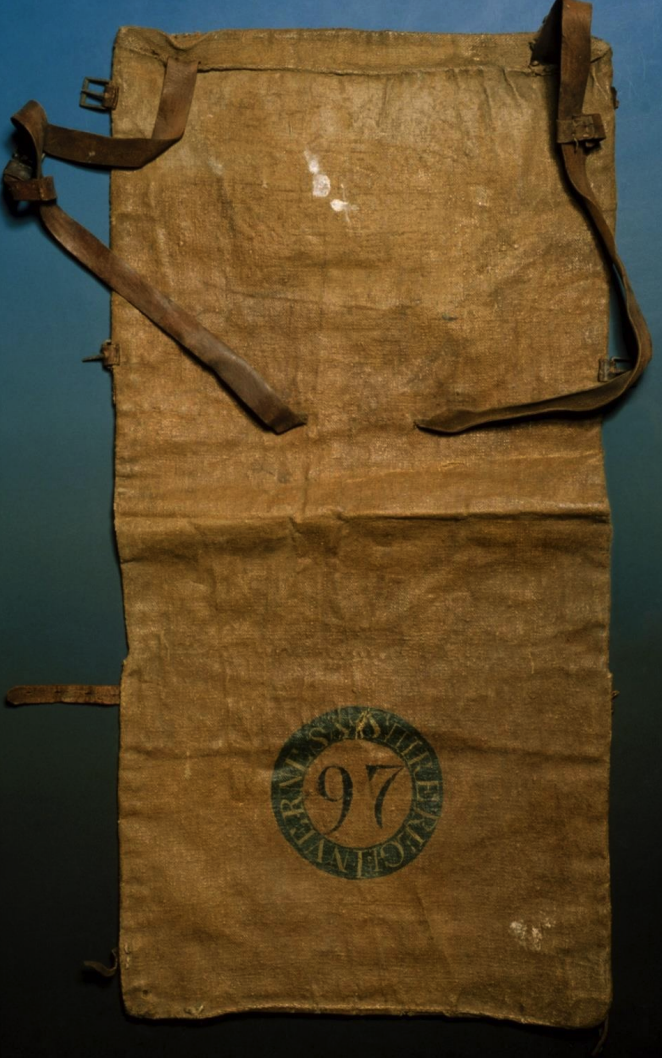
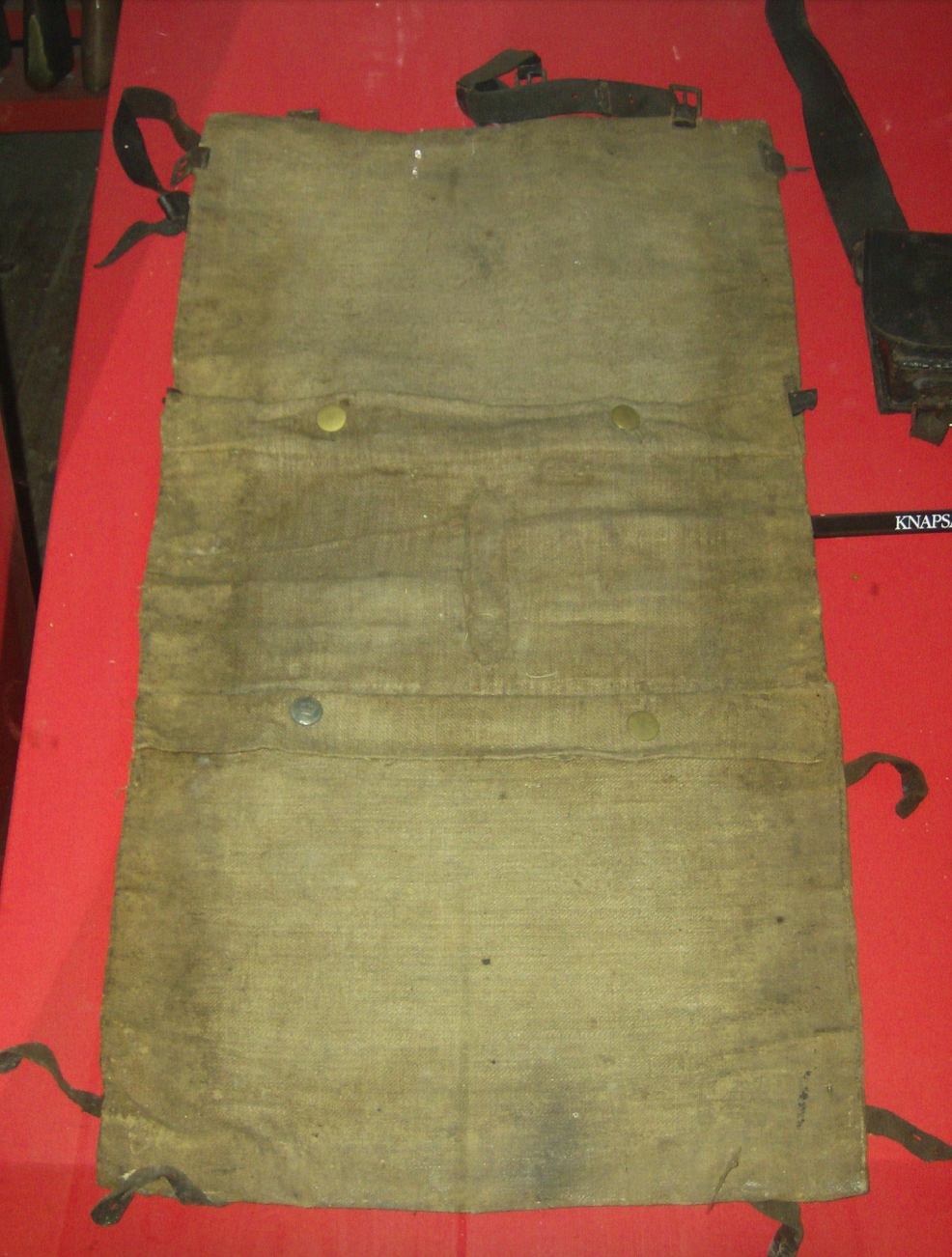
 JOHN REESJohn has been involved in American War for Independence living history for 33 years, and began writing on various aspects of the armies in that conflict in 1986. In addition to publishing articles in journals such as Military Collector & Historian and Brigade Dispatch, he was a regular columnist for the quarterly newsletter Food History News for 15 years writing on soldiers’ food, wrote four entries for the Oxford Encyclopedia of American Food and Drink, and thirteen entries for the revised Thomson Gale edition of Boatner’s Encyclopedia of the American Revolution.
JOHN REESJohn has been involved in American War for Independence living history for 33 years, and began writing on various aspects of the armies in that conflict in 1986. In addition to publishing articles in journals such as Military Collector & Historian and Brigade Dispatch, he was a regular columnist for the quarterly newsletter Food History News for 15 years writing on soldiers’ food, wrote four entries for the Oxford Encyclopedia of American Food and Drink, and thirteen entries for the revised Thomson Gale edition of Boatner’s Encyclopedia of the American Revolution.
Many of his works may be accessed online at http://tinyurl.com/jureesarticles .Read Part 1 of A Hypothesis Regarding British Knapsack Evolution Here !
A Hypothesis Regarding British Knapsack Evolution
“Square knapsacks are most convenient …”
This post began with the vague idea of discussing the 17th Regiment’s recreated knapsack. To my mind it is the only one that comes close to representing the design of the originals likely carried by mid-war (and possibly late-war) British soldiers. But that set me to ruminating on how the double-pouch knapsack (such as the Benjamin Warner pack at Fort Ticonderoga and the one pictured below in the 71st Regiment’s 1778 order book) came to be. The following narrative, based on both primary and, admittedly, circumstantial evidence, attempts to trace that transformation, and (spoiler alert) leads the author to think it very likely the double-pouch pack was a wartime innovation.

Drawing of knapsack from British 71st Regiment 1778 order book. This is likely evidence that double-bag knapsacks, undoubtedly of linen, were being used by British troops at least by 1778. Note that food was to be carried in one bag, and a minimum of necessaries (“1 pair of shoes,” “1 set Brushes,” “1 shirt, “1 Pr. stockings”) in the other. Continental Army twoshoulder-strap double-bag packs were probably copied from British knapsacks. The Warner knapsack (probably issued in 1779) had two storage pouches; orders for American army knapsacks in 1782 stipulated, “Let them be made double, & one side painted.” Standing Orders of the 71st Regiment, 1778, Lt. Col. Archibald Campbell, National Register of Archives for Scotland (NRAS 28 papers), Isle of Canna, Scotland, U.K.(Knapsack drawing courtesy of Alexander John Good.)51
[gallery ids="3610,3619" columns="2" link="file" size="full"]Recreated Knapsacks, 17th Regiment
There are occasions (actually, many occasions) when my understanding runs on a very slow burn. In this vein, researching and writing about knapsacks used before, during and after the American War (1775-1783), eventually led me to the conclusion that British knapsack design took a right turn early in that conflict. Is my conclusion conclusive? No, it isn’t, as there are missing pieces in the records, but the possibility (or probability) is intriguing.
* * * * * *In his 1768 treatise System for the Compleat Interior Management and Oeconomy of a Battalion of Infantry Bennett Cuthbertson wrote,
Square knapsacks are most convenient, for packing up the Soldier’s necessaries, and should be made with a division, to hold the shoes, black-ball and brushes, separate from the linen: a certain size must be determined on for the whole, and it will have a pleasing effect upon a March, if care has been taken, to get them of all white goat-skins, with leather-slings well whitened, to hang over each shoulder; which method makes the carriage of the Knapsack much easier, than across the breast, and by no means so heating.9
Cuthbertson reveals here several notable clues. First, of course, is his statement touting the superiority of “square” knapsacks with two shoulder slings. The 1751 Morier figures and the circa 1765 painting “An Officer Giving Alms to a Sick Soldier” by Edward Penny (1714-1791) show soldiers wearing single-shoulder-strap skin packs, so Cuthbertson’s square knapsack was a relatively recent innovation. Mr. C. also states square packs “should be made with a division, to hold the shoes, black-ball and brushes, separate from the linen” and “a certain size must be determined on for the whole …” ”[M]ade with a division.” That, to me, indicates Cuthbertson is speaking of a single pouch knapsack, like the David Uhl and Elisha Grose packs, while his remark about determining size can only mean no standard design had yet been settled on. And his reference to “all white goat-skins” refers to a knapsack likely made entirely of leather, again like the Grose knapsack. Both pre-war and in the war’s early years leather seems to have been the preferred material for many, perhaps most, knapsacks.
(For references to leather packs see sections titled “Leather and Hair Packs, and Ezra Tilden’s Narrative” and “The Rufus Lincoln and Elisha
Gross Hair Knapsacks” in “’Cost of a Knapsack complete …’: `This Napsack I carryd through the war of the Revolution,” Knapsacks Used by the Soldiers during the War for American Independence’” http://www.scribd.com/doc/210794759/%E2%80%9C-This-Napsack-I-carryd-through-the-war-of-theRevolution-Knapsacks-Used-by-the-Soldiers-during-the-War-for-American-Independence-Part-1-of-
%E2%80%9C-Cos ; see also, Al Saguto, “The Seventeenth Century Snapsack” (January 1989) http://www.scribd.com/doc/212328948/Al-Saguto-The-Seventeenth-Century-Snapsack-January-1989 )
[gallery ids="3628,3638" columns="2" size="full"]Detail from David Morier, “Grenadiers, 46th, 47th and 48th Regiments of Foot, 1751” http://www.royalcollection.org.uk/collection-search/david%2520morier
Based on the writing of Massachusetts militia colonel Timothy Pickering (below), sometime prior to 1774, packs like the one Cuthbertson described seem to have been adopted by at least some British regiments:
A knapsack may be contrived that a man may load and fire, in case of necessity, without throwing down his pack. Let the knapsack lay lengthways upon the back: from each side at the top let a strap come over the shoulders, go under the arms, and be fastened about half way down the knapsack. Secure these shoulder straps in their places by two other straps which are to go across and buckle before the middle of the breast. The mouth of the knapsack is at the top, and is covered by a flap made like the flap of saddlebags.- The outside of the knapsack should be fuller than the other which lies next to your back; and of course must be sewed in gathers at the bottom. Many of the knapsacks used in the army are, I believe, in this fashion, though made of some kind of skins.20
Pickering, too, refers to packs made of leather, infers that they had only a single pouch, and adds that the closing flap resembles those on saddle bags of the time. Period examples have closing flaps similar to those on the Uhl (linen) and Grose (bearskin) knapsacks.


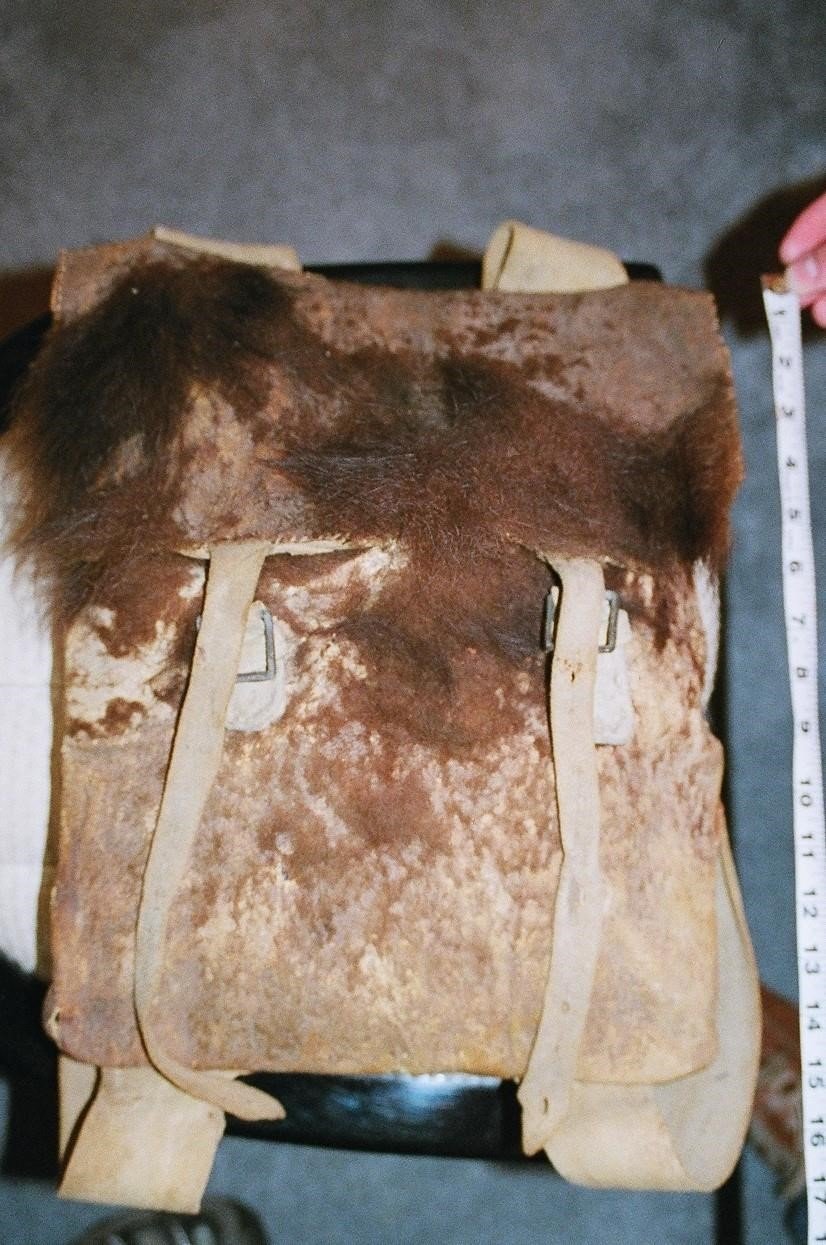
So, just when were double-pouch knapsacks (like Benjamin Warner’s 1780 pack) first introduced to British troops in America? A drawing from a 1778 71st Regiment order book found and shared by Alexander John Good may provide the answer. That image shows a very simple double-pouch knapsack, with food placed in one pouch and “1 pair of shoes,” 1 set Brushes,” “1 shirt,” and “1 pr stockings” in the other. (It is interesting that this apportionment mirrors that of the “new Invented Napsack and haversack” used by some Whig units in 1776, 1778, and possibly 1777, but more on that later).
See the timeline of British Knapsacks at the bottom of this article.
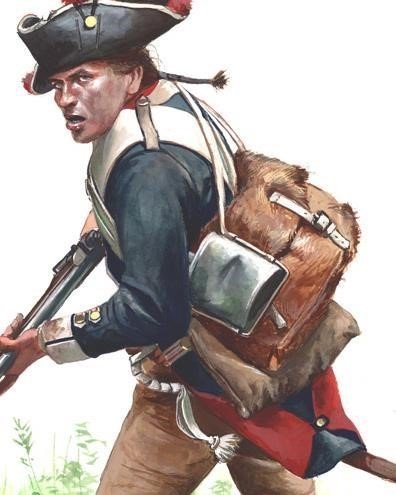
British regiments already in America at the beginning of the war had knapsacks, but we have no idea of their design. At this time, given what we know of pre-war packs from period images and the comments of Cuthbertson and Pickering, I can only surmise that early-war (1775-1777) British knapsacks were leather (goatskin?), possibly linen, “square” models, with a single pouch (possibly with a divider to separate a spare pair of shoes from the other necessaries), and two shoulder straps. They also could not easily accommodate a blanket, an item deemed necessary for service in North America. British, French, and German troops campaigning in Europe did not carry blankets on the march, those coverings being carried in the same wagons as the regimental tentage. The packs (tournisters) German troops carried while serving in the American War still could not carry a blanket, and we are still unsure how, or even if, German troops carried blankets on the march.
Supply documents for the British Brigade of Guards, 1776 to 1778, including numbers of knapsacks issued and the use of blanket slings on campaign, and generate some interesting questions.
[Numbers of knapsacks needed and requested]
List of Waggons, Tents, Camp necessaries &ca for the Detachment from the Three Regiments of Foot Guards, consisting with their Officers of 1097 men destined to Serve in North America.
February 5th 1776 …1062 Haversacks1062 Knapsacks(Loudoun p.213) (see also WO4/96 p.45 7 Feb. 1776 Barrington to Loudoun)[Knapsack pattern]Memo Brig. Gen. Edward Mathew to John Campbell, 4th Earl of Loudoun 16 Feb. 1776 "Memorandum concerning the [Guards] Detachment Fryday Feb 16 1776" "Light Infantry Company. Colo. Mathews applies for the proper Clothing.proposes: To cut the 2nd Clothing of this Year into Jackets. --Caps, Colo. M to produce a pattern --Arms, The Ordnance will deliver them with the others. a fresh Application.Accoutrements, upon the plan of the light Infantry. Colo. M--Bill Hook and Bayonet in the same case. Colo M.-- ""Gaiters and Leggins Knapsack -- Genl. Tayler has a pattern. Nightcaps -- Colo. M to shew one Canteens -- to see a Wooden one."(Loudoun-Hunt. LO 6510)[Altering knapsacks] Memo Mathew to Loudoun 28 Feb. 1776
"Estimate of the Extra expence of the Necessary Equipment of the Detachment from the Brigd. of Foot Guards Intended for Foreign Service"
Alteration of the Mens Knapsacks .6 [pence]To Receive from the Goverment in Lieu of Knapsacks 2.6Allowance from Govermt. to each Man for a Knapsack 2.6(Loudoun-Hunt. LO 6514)[Fitting knapsacks] Regimental Order, London 7 March 1776The 1st Regt. will draught the 15 men "by Lot out of such Men as are in every respect fit for Service."2nd and 3rd Battalion to draught Sat the 9th 1st Battalion on Sun the 10thA return to be sent in of the name, age and service of the men.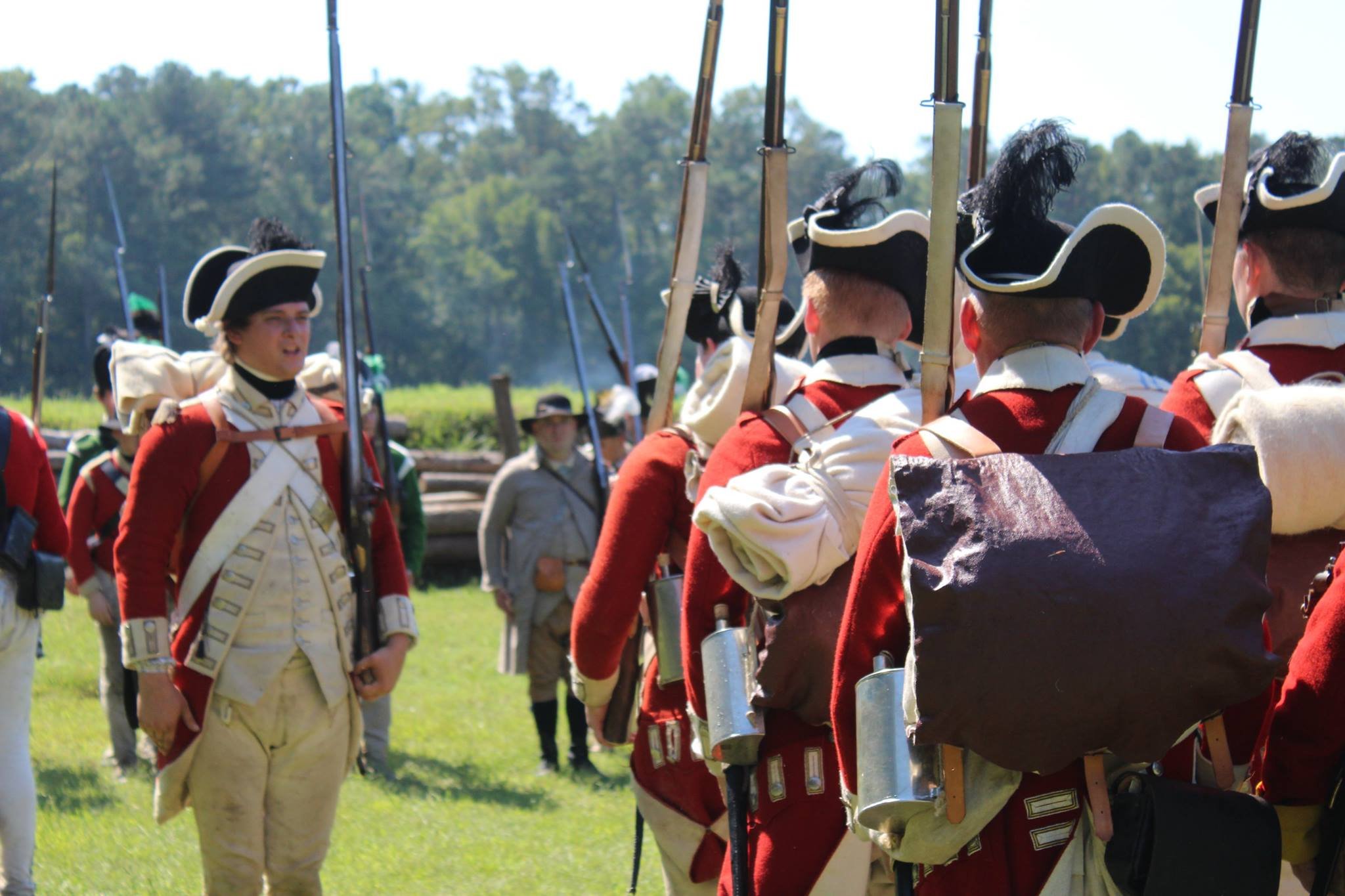 Commanding Officers of companies "will Inspect minutely into the Men's Necessaries who are Draughted, that they may be Compleated according to the List to be seen at the Orderly Room, The Knapsacks to be fitted to each Man, according to a late Regulation, and to be seen that they are perfectly whole and strongly sewed."
Commanding Officers of companies "will Inspect minutely into the Men's Necessaries who are Draughted, that they may be Compleated according to the List to be seen at the Orderly Room, The Knapsacks to be fitted to each Man, according to a late Regulation, and to be seen that they are perfectly whole and strongly sewed."
"The Extraordinary necessaries furnish'd are not to be deliver'd to the Men till they are in their first Cantonments."
(First Guards)[List of soldiers’ necessaries, including knapsacks] Brigade Orders, London 13 March 1776"The Necessarys of the Detachment are to be Compleated to the following Articles -- Three ShirtsThree Pair worsted StockingsTwo pair of Socks 7/ 1/4 pr. PairTwo pair of ShoesThree pair of Heels and Soles 1/2 d pr. pairTwo Black StocksTwo Pair of Half Gaiters 1s/ pr. pairOne Cheque Shirt 3/9 dA Knapsack (2/6 d Allowed by Government)Picker, Worm & TurnscrewA Night Cap"(Scots)
A little over a month later, on 26 April 1776, the three Guards Battalions set sail for North America.
With all the trouble taken to procure knapsacks for the Guards Brigade, those packs seem to have either been left aboard the transports when the Guards went ashore at Long Island, New York or sent back on board after landing. Several 1776 documents mention knapsacks or the lack thereof during the New York campaign.
"[Guards] Brigade Orders August 19th [1776.]When the Brigade disembarks two Gils of Rum to be delivered for each mans Canteen which must be filled with Water, Each Man to disembark with a Blanket & Haversack in which he is to carry one Shirt one pair of Socks and Three Days Provisions a careful Man to be left on board each Ship to take care of the Knapsacks. The Articles of War to be read to the Men by an Officer of each Ship."(Thomas Glyn, "The Journal of Ensign Thomas Glyn, 1st Regiment of Foot Guards on theAmerican Service with the Brigade of Guards 1776-1777," 7. Transcription courtesy of Linnea M. Bass.)General (Army) Orders 20 August 1776"When the Troops land they are to carry nothing with them but their Arms, Ammunition, Blankets, & three Days provisions. The Commandg. Officers of Compys. will take particular care that the Canteens are properly fill'd with Rum & Water & it is most earnestly reecommended to the Men to be as saving as possible of their Grog." (1) (2)Brigade Orders 23 August 1776 [the day after their landing on Long Island]"the Brigade will Assemble with their Arms Accoutrements Blankets & Knapsacks to Morrow Morning at 5 oClock upon the same ground. . ." (2) (1)Brigade Orders 24 August 1776"the Commanding offrs of Battns may send their Knapsacks on board of Ships again if they find any ill Conveniency of them." (2) (1)It seems that many Crown soldiers used only slung blankets during the 1776 campaign, perhaps due to the “ill Conveniency” of their knapsacks, whatever that may mean. Here are two more 1776 references to carrying only blankets and blankets on slings:Orders, 4th Battalion Grenadiers (42nd and 71st Regiments), off Staten Island, 2 August 1776: "When the Men disembark they are to take nothing with them, but 3Shirts 2 prs of hose & their Leggings which are to be put up neatly in their packs, leaving their knapsacks & all their other necessaries on board ship which are carefully to be laid up by the Commanding Officers of Companys in the safest manner they can contrive."Capt. William Leslie, 17th Regiment of Foot, 2 September 1776, “"Bedford Long Island Sept.2nd 1776…
The Day after their Retreat we had orders to march to the ground we are now encamped upon, near the Village of Bedford: It is now a fortnight we have lain upon the ground wrapt in our Blankets, and thank God who supports us when we stand most in need, I have never enjoyed better health in my Life. My whole stock consists of two shirts 2 pr of shoes, 2 Handkerchiefs half of which I use, the other half I carry in my Blanket, like a Pedlar's Pack."61
Preparing for the 1777 campaign the British Guards were slated for another knapsack issue:Secretary at War William Barrington, 2nd Viscount Barrington to Loudoun 7 Sept 1776 His Majesty Orders that for the 1777 Campaign the Detachment is to receive the following CampNecessaries …1062 Haversacks1062 Knapsacks10 Powder Bags(WO4/98 p. 144)Note: Correspondence on pages 150, 157, 171 indicates that only 150 knapsacks per regiment in America were supplied for the 1777 campaign. [That would make 450 total for three battalions.] And in March 1777 the following order was issued:[Guards] Brigade Orders 11 March 1777"The Waistbelts to Carry the Bayonet & to be wore across the Shoulder. The Captains are desired to provide Webbing for Carrying the Mens Blankets according to a pattern to be Seen at the Cantonment of Lt. Colo. Sr. J. Wrottesleys Company. The Serjeants to Observe how they are Sewed."(1) From an original manuscript entitled "Howe Orderly Book 1776-1778" which is actually a Brigade of Guards Orderly Book from 1st Battalion beginning 12 March 1776, the day theBrigade for American Service was formed. Manuscript Dept., William L. Clements Library, Univ. of Michigan, Ann Arbor. (Microfilm available for loan.)
So, were British knapsacks in use up to and including the year 1777 both single-pouch and incapable of accommodating a blanket? Were blanket slings used to carry blankets with knapsacks as well as without? Or were the knapsacks used by Crown forces at the time merely considered cumbersome, and blanket slings thought to be more proper for campaigning soldiers. Added to those questions, we are not at all certain how British soldiers carried their blankets even after double-pouch knapsacks came into use.
To Be Continued...
British Knapsack Timeline, 1758-17941758-1765 (and earlier), Single-pouch purse-like leather knapsack carried by British troops, as pictured in paintings by David Morier (1705-1770) and Edward Penny, R.A. (1714-1791). These knapsacks could not accommodate a blanket.1768, Cuthbertson recommends “square” knapsacks with two shoulder straps.1771, Painting of a private soldier of the 25th Regiment of Foot shows him wearing a hair pack with two shoulder straps. His knapsack seems to be a single-pouch model made of hide covered with hair, and, given the maud slung over his shoulder, could not accommodate a blanket.1774, Timothy Pickering describes a single-pouch, double-shoulder-strap leather knapsack being used in the British Army.1776, An American contractor touts his double-pouch, single-shoulder-strap linen “new InventedNapsack and haversack” to Maryland officials. One pouch was meant for food, the other for soldiers’ necessaries. Some Maryland units are known to have been issued the knapsack, and there is some indication it was used by Pennsylvania troops as well.1776-1777, British regiments are issued knapsacks, but many Crown units use blanket slings instead of packs in these two campaigns. (Possibly because the knapsacks then being used could not accommodate a blanket, which were deemed necessary for American service.)1778, The first known image of a double-pouch British knapsack appears in a 71st Regiment order book. One pouch is shown as holding food, the other, soldiers’ necessaries.1778, On 28 July “1096 Knap & Haversacks” (from the context likely the same as the “new Invented Napsack and haversack”) are sent from Reading, Pennsylvania to supply Continental troops.1780, Benjamin Warner was likely issued his double-pouch double-shoulder-strap linen knapsack while serving with a Continental artillery regiment. `1782, First known documentary references to double-pouch knapsacks.1782, L’Enfant painting of West Point showing soldiers with rolled blankets attached to the top of their knapsacks.1794, The earliest known surviving British double-pouch, double-shoulder-strap linen knapsack, made for the 97th Inverness Regiment, raised in 1794 and disbanded the same year.
Footnotes:
- H. Butterfield, ed., Letters of Benjamin Rush, vol. I (Princeton, N.J., 1951), 154-155.
- 84th Regiment order book, Malcolm Fraser Papers, MG 23, K1,Vol 21, Library and Archives Canada.
- "Orderly Book: British Regiment Footguards, New York and New Jersey," a 1st Battalion
Order Book covering August 1776 to January 1777, Early American Orderly Books, 1748-1817, Collections of the New-York Historical Society (Microfilm Edition - Woodbridge, N.J.: Research Publications, Inc.: 1977), reel 3, document 37.
- Sheldon S. Cohen, "Captain William Leslie's 'Paths of Glory,’" New Jersey History, 108 (1990), 63.
- "Howe Orderly Book 1776-1778" (actually a Brigade of Guards Orderly Book from 1st
Battalion beginning 12 March 1776, the day the Brigade for American Service was formed), Manuscript Department, William L. Clements Library, University of Michigan, Ann Arbor.(Courtesy of Linnea Bass.)
- British Orderly Book [40th Regiment of Foot] April 20, 1777 to August 28, 1777, George Washington Papers, Presidential Papers Microfilm (Washington: Library of Congress, 1961), series 6 (Military Papers, 1755-1798), vol. 1, reel 117. See also, John U. Rees, ed., "`Necessarys
… to be Properley Packd: & Slung in their Blanketts’: Selected Transcriptions 40th Regiment ofFoot Order Book,” http://revwar75.com/library/rees/40th.htm
- "Captured British Orderly Book [49th Regiment], 25 June 1777 to 10 September 1777, . George Washington Papers (microfilm), series 6, vol. 1, reel 117.
- "Orderly Book: First Battalion of Guards, British Army, New York" (covers all but a few days of 1779), Early American Orderly Books, N-YHS (microfilm), reel 6, document 77.
- R. Newsome, ed., "A British Orderly Book, 1780-1781", North Carolina Historical Review, vol. IX (January-October 1932), no. 2, 178-179; no. 3, 286, 287.
- Order book, 43rd Regiment of Foot (British), 23 May 1781 to 25 August 1781, British Museum, London, Mss. 42,449 (transcription by Gilbert V. Riddle).
JOHN REESJohn has been involved in American War for Independence living history for 33 years, and began writing on various aspects of the armies in that conflict in 1986. In addition to publishing articles in journals such as Military Collector & Historian and Brigade Dispatch, he was a regular columnist for the quarterly newsletter Food History News for 15 years writing on soldiers' food, wrote four entries for the Oxford Encyclopedia of American Food and Drink, and thirteen entries for the revised Thomson Gale edition of Boatner’s Encyclopedia of the American Revolution.
Many of his works may be accessed online at http://tinyurl.com/jureesarticles .
The Speaker’s House, Trappe PA
This elegant townhome, which reminds you far more of the elegant 18th century townhomes of Philadelphia rather than a home in the rural countryside 25 miles west of that city, was nearly lost to history thanks to modern development. If it had not been for the tireless efforts of concerned citizens, a CVS would stand on this sight today. When you drive up Ridge Pike, following the path that the Continental Army took multiple times into and away from Philly, you see this huge stone house facing down the small shopping center across the street. The years show on this building. The remains of stucco partially obscure the stonework below the roofline, the ghostly outline of an addition to the house that once connected on the eastern wall is all that remains of the general store erected by Frederick Muhlenberg, Lutheran Minister, First Speaker of the House of Representatives, and one of the early judges in Montgomery County PA, son of the famous Henry Muhlenberg: Patriarch of the Lutheran Church in America, and brother to Peter Muhlenberg: the famous Fighting Parson of Virginia during the American Revolution.
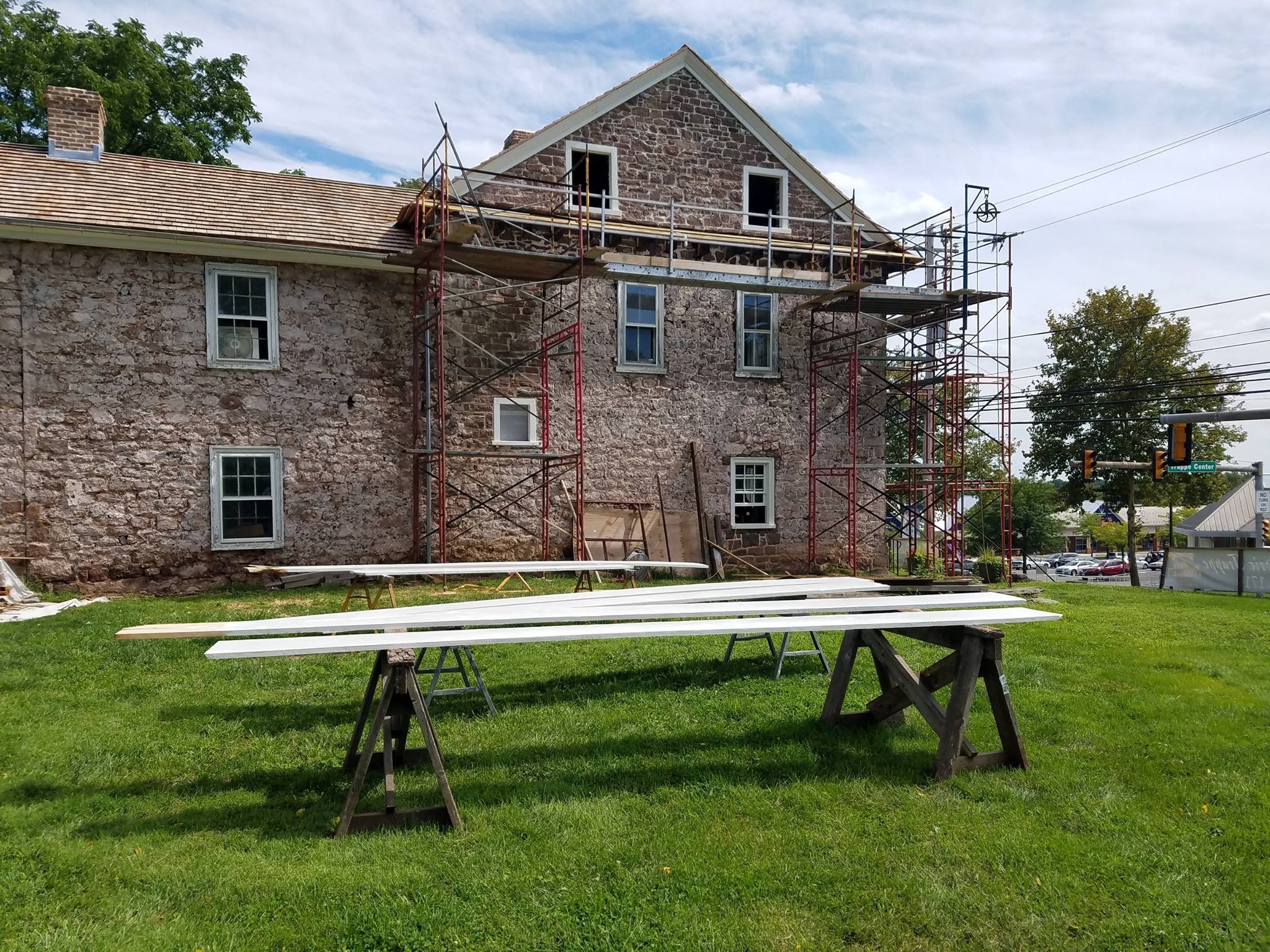
Yet, even with the scaffolding wrapped around the house, you can’t help but be amazed by its simple beauty. 4 corner fireplaces in the main section of the house, 2 on each floor. A brand new roof, replacing the Victorian-era modification, restores the houses 18th century roofline; complete with cedar shingles and crown molding copied from the surviving originals found on the property. Behind the main section of the house are the two additions, the latest dates to the early 19th century, within has been found the outline of the original kitchen hearth and bread oven. This is the next restoration project planned. Directly behind the last addition stands the house’s recreated Pennsylvania German Kitchen Garden. Within the white fence, the style of which was copied from local period examples, are 4 central raised beds and others running around the perimeter.
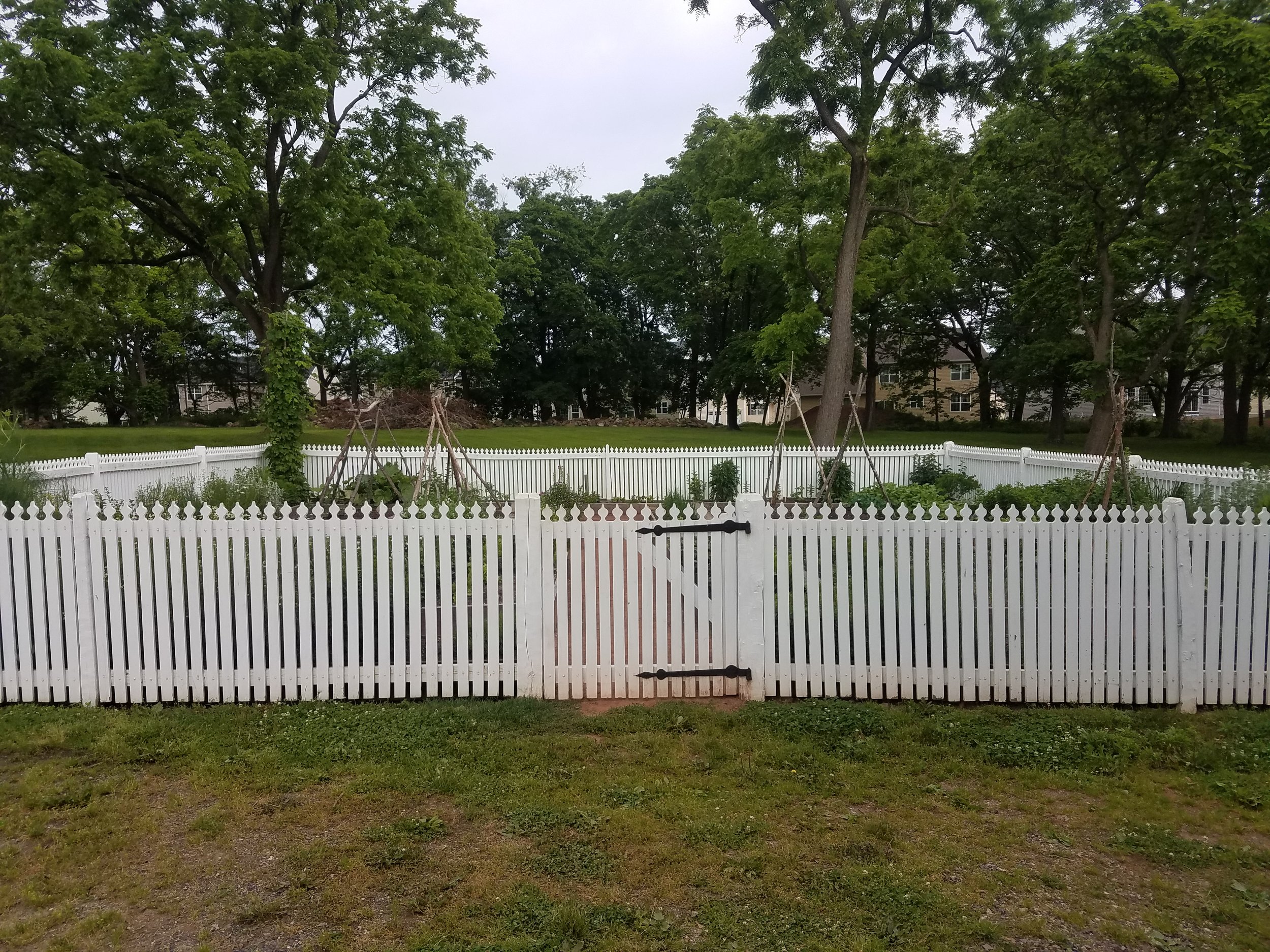 Here, volunteers grow, maintain, and then sell heirloom vegetables, herbs, spices, and flowers that would have been familiar to the people who once called this house home. All of the work, from the masons and carpenters capering on the roof, to the more agriculturally minded watering and pruning plants, everyone working at The Speaker’s House is passionate about bringing the stories that took place in this house and around it alive.
Here, volunteers grow, maintain, and then sell heirloom vegetables, herbs, spices, and flowers that would have been familiar to the people who once called this house home. All of the work, from the masons and carpenters capering on the roof, to the more agriculturally minded watering and pruning plants, everyone working at The Speaker’s House is passionate about bringing the stories that took place in this house and around it alive.
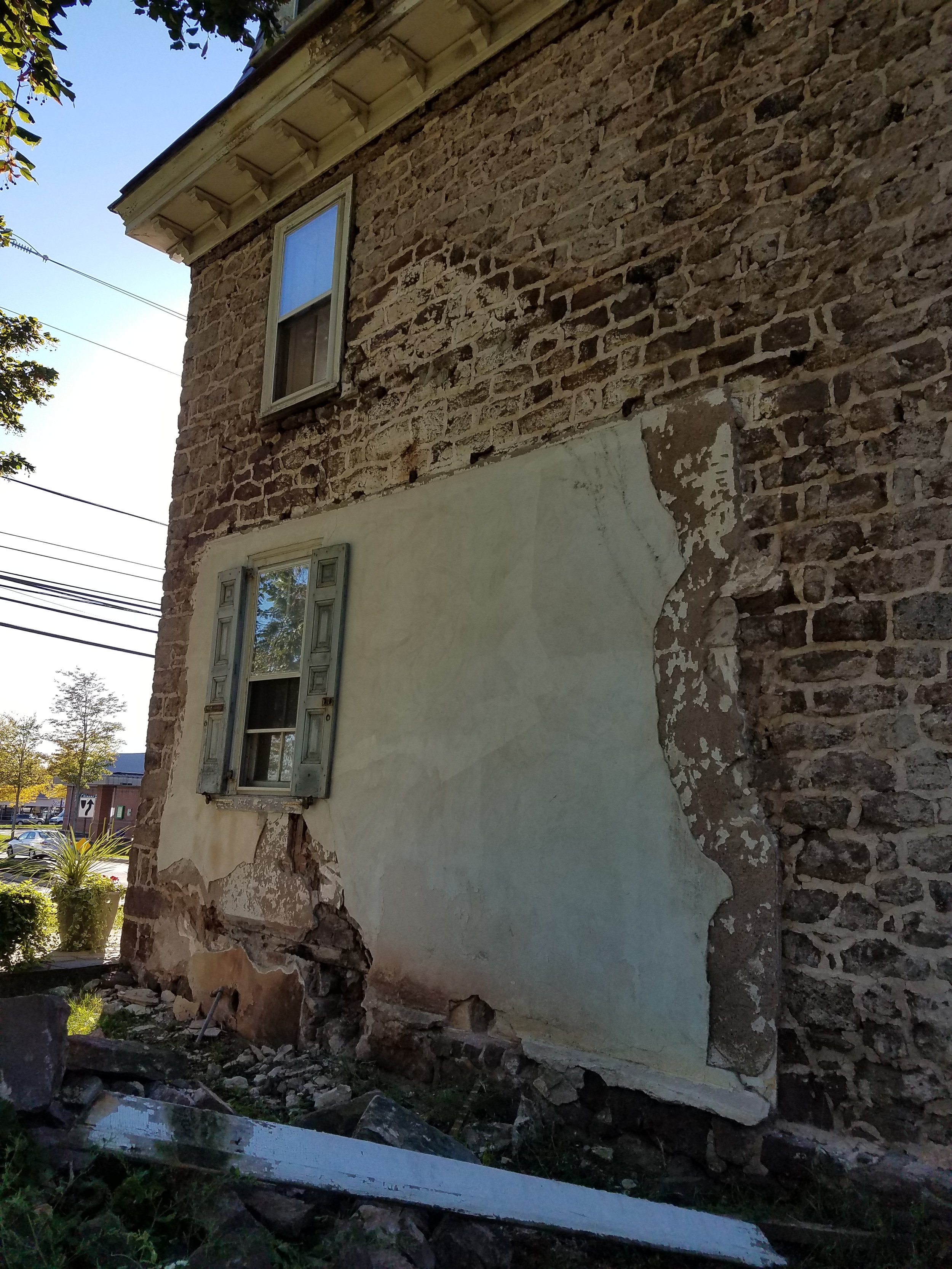 Originally built in 1763 for John Schrack, son of Trappe’s founder, John was the keeper of the original Trappe Tavern, for which the area gets its name. That original tavern stood directly across the street from the house, roughly where a bank is now. After John’s death in 1772 it changed hands multiple times. During the revolution, one of the owners, Johannes Reed, was required to billet soldiers coming from Fort Ticonderoga in New York in his house. Reverend Henry Muhlenberg, who lives just up the road, noted this in his journal. In 1781, Frederick Muhlenberg bought the house and the 50 acres it sat on. This is when he added the 30 ft x 20 ft store, and a further addition on the west side of the house. In 1791, Frederick sold the house sister and his brother in-law Mary and Francis Swaine, who sold the house in 1803 to Charles Albrecht, a musical instrument maker from Philadelphia. Both Frederick and Peter owned Charles Albrecht made pianos in their homes. The house continued to change hands off and on, becoming property of Ursinus College from 1924-1944 and then returning to private ownership again.
Originally built in 1763 for John Schrack, son of Trappe’s founder, John was the keeper of the original Trappe Tavern, for which the area gets its name. That original tavern stood directly across the street from the house, roughly where a bank is now. After John’s death in 1772 it changed hands multiple times. During the revolution, one of the owners, Johannes Reed, was required to billet soldiers coming from Fort Ticonderoga in New York in his house. Reverend Henry Muhlenberg, who lives just up the road, noted this in his journal. In 1781, Frederick Muhlenberg bought the house and the 50 acres it sat on. This is when he added the 30 ft x 20 ft store, and a further addition on the west side of the house. In 1791, Frederick sold the house sister and his brother in-law Mary and Francis Swaine, who sold the house in 1803 to Charles Albrecht, a musical instrument maker from Philadelphia. Both Frederick and Peter owned Charles Albrecht made pianos in their homes. The house continued to change hands off and on, becoming property of Ursinus College from 1924-1944 and then returning to private ownership again.
By the 1990s the house was converted for apartment living and in desperate need of renovation. In 1999 CVS thought about buying the property and demolishing this house. Thankfully, this was not to be, and by 2004 the house was purchased by the non-profit that manages it today.
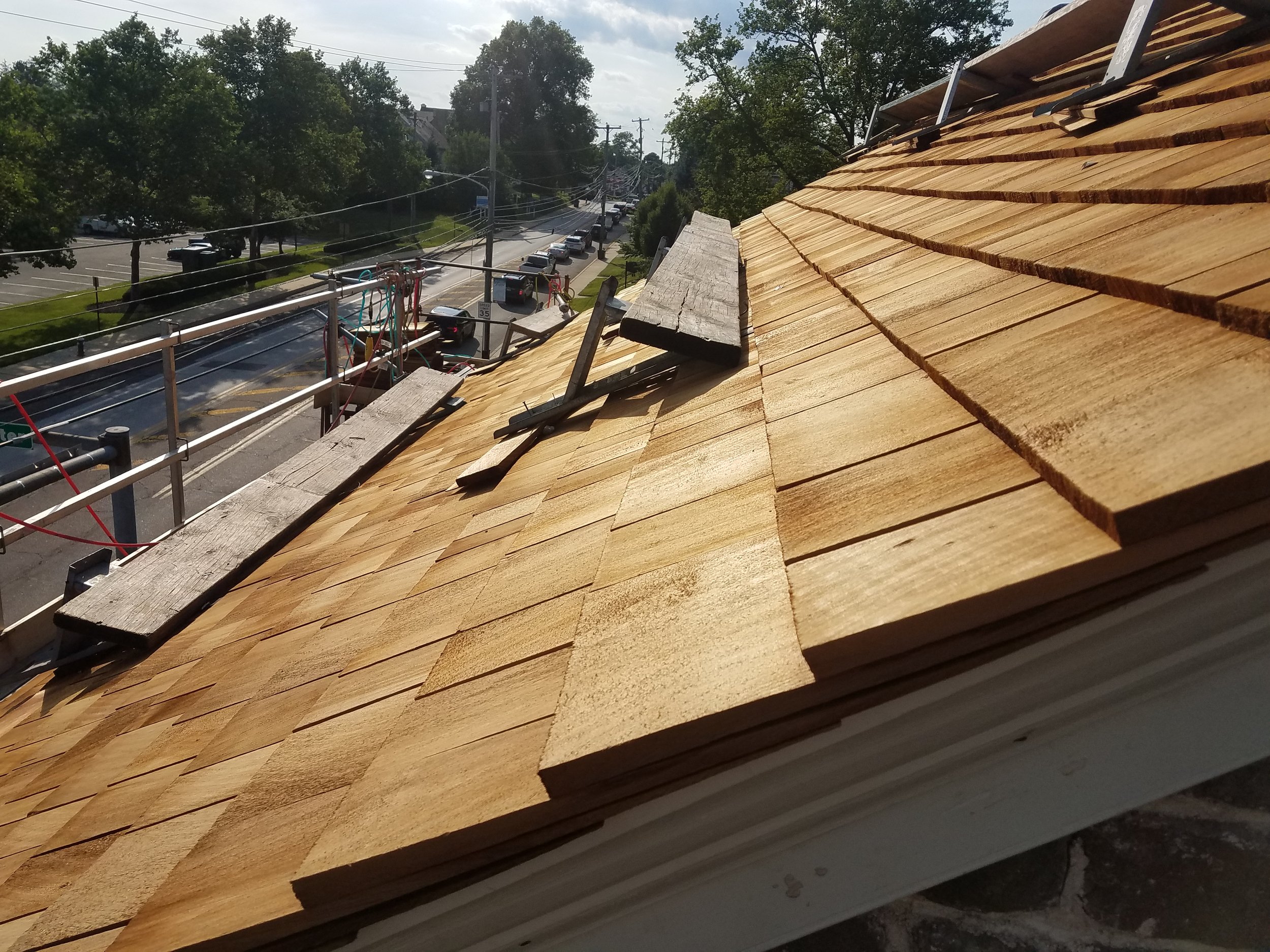
Though there’s still a lot of work left to be done to bring this house back into its former glory, the group of people who take care of it are more than up to the task. Along with the house itself, it is hoped that the Smoke House, Privy, General Store, and Barn can all be rebuilt in the future on the foundations that remain from the original structures. Whenever you make it out to The Speaker’s House, plan on stopping by again in the future. There’ll be something new to see every time!
 KYLE TIMMONSKyle is a long time reenactor, a Combat Medic in the PA National Guard, and currently an employee of the National Park Service. His wife and cat think he’s pretty alright. The Speaker's House is in Trappe Pennsylvania and they are hosting a living history event on September 30th, 2017. It has been under renovation since 2004. Come out and support our local history!If you would like to write a short history of your local public historical home please send emails to hm17thblog@gmail.com
KYLE TIMMONSKyle is a long time reenactor, a Combat Medic in the PA National Guard, and currently an employee of the National Park Service. His wife and cat think he’s pretty alright. The Speaker's House is in Trappe Pennsylvania and they are hosting a living history event on September 30th, 2017. It has been under renovation since 2004. Come out and support our local history!If you would like to write a short history of your local public historical home please send emails to hm17thblog@gmail.com
Half a Year in Review
Hello friends and family of the 17th Regiment of Infantry! Hope you are having a great start to the beginning of the month. As the editor, I wanted to take this opportunity to have a website "meeting" with everyone who reads our blog and participates. I wanted to take thank all of my friends who continue to surprise me with their knowledge of the 18th century civilian and military who have all volunteered to write posts so far:
Katherine Becnel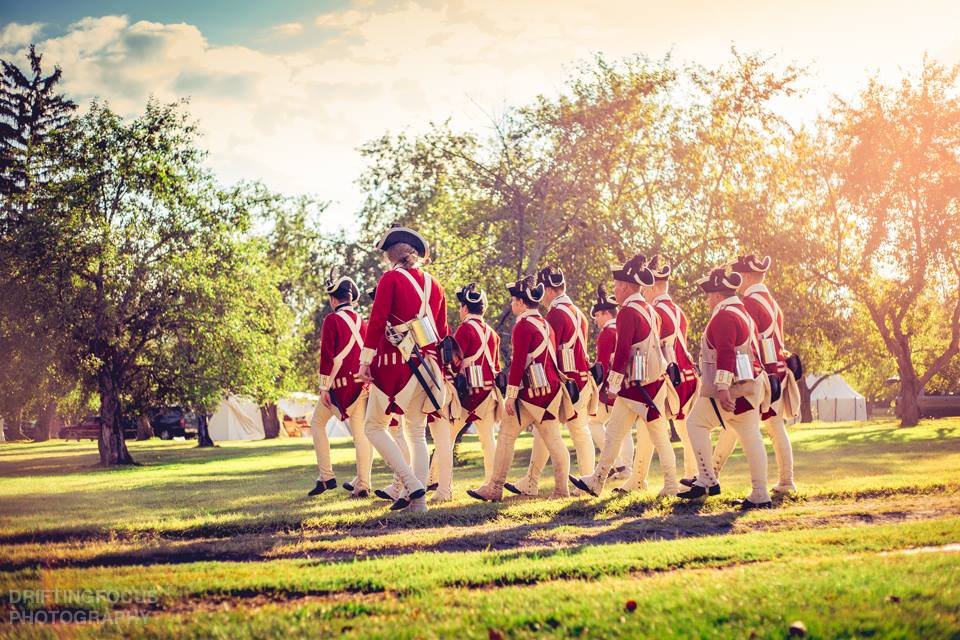 Kyle TimmonsJenna SchintzerMark Odintz PhD.Will Tatum PhD.Don HagistCarrie FellowsDamian NiecsiorTim MacdonaldAndrew KirkWilliam MichelAnna Gruber-KieferBrandyn CharltonThank You so much for participating in the blog since we started, it wouldn't be possible without. (I don't think I missed listing anyone but if I did I meant to list you!) Here is a lengthy list of the post highlights that we've had in the last few months:
Kyle TimmonsJenna SchintzerMark Odintz PhD.Will Tatum PhD.Don HagistCarrie FellowsDamian NiecsiorTim MacdonaldAndrew KirkWilliam MichelAnna Gruber-KieferBrandyn CharltonThank You so much for participating in the blog since we started, it wouldn't be possible without. (I don't think I missed listing anyone but if I did I meant to list you!) Here is a lengthy list of the post highlights that we've had in the last few months:
Funcomfortable - Kat BecnelDescribing reenacting in the bitter cold of From Princeton to Trenton in January 2017Feminism and Following - Kat BecnelA farewell opinion piece describing the difference between gal trooping and following the army from a woman's perspective.Opening a Window to the Past - Jenna SchnitzerA conversational discussion piece on the representation of women impressions.Founding the Recreated 17th - Will Tatum PhD.A two part origin story of how the recreated 17th came to be in America.The Physicality of History - Kyle TimmonsA first person simulated account of what 18th Century Soldiers might have had to deal with.Music Made Easy: A Guide to Period Playing - Tim Macdonald A brief guide on the do's and don'ts to period musick playing. An introduction to material culture, in the mix of military discussion.The Things We Carry - Damian NiesciorA short guide to everything an 18th Century Soldier might be seen carrying on his person.The Things We Carry: On the Strength of the Army - Carry FellowsA short guide to everything an 18th Century Follower might be seen carrying on her person.The Making of a "Massacre" Simcoe's Surprise Attack At Hancock's Bridge -William MichelA brief synopsis of the history of The Hancock House in South Jersey opening the discussion to local history and the importance of saving historic homes from the 18thc.On Portraying a Member of the Religious Society of Friends During the American Revolution - Brandyn CharltonA brief discussion of the representation of religion in reenacting with the focus on the religious society of friends developing an introduction to the discussion of religion during the Revolutionary War on the 17th blog.
Changing topic... As editor it's important to listen to opinions and ideas of what people might want to see. If you can tell I've been trying to get a well rounded group of information with everything from; material culture, military history, opinion, and personal reenacting experiences. I've made it my "job" to figure out what the best balance is to share. Not everyone is an active reenactor who seems to read the blog. So what I would like is for active readers to continuously give opinions on what is being posted, so we know what direction to take the discussion.
If you have any requests or topics you would like us to try and discuss please feel free to email me! If you have a topic that you personally would like to discuss please see the Writers Wanted page for more information if you have any questions or comments please use the email listed on that page.
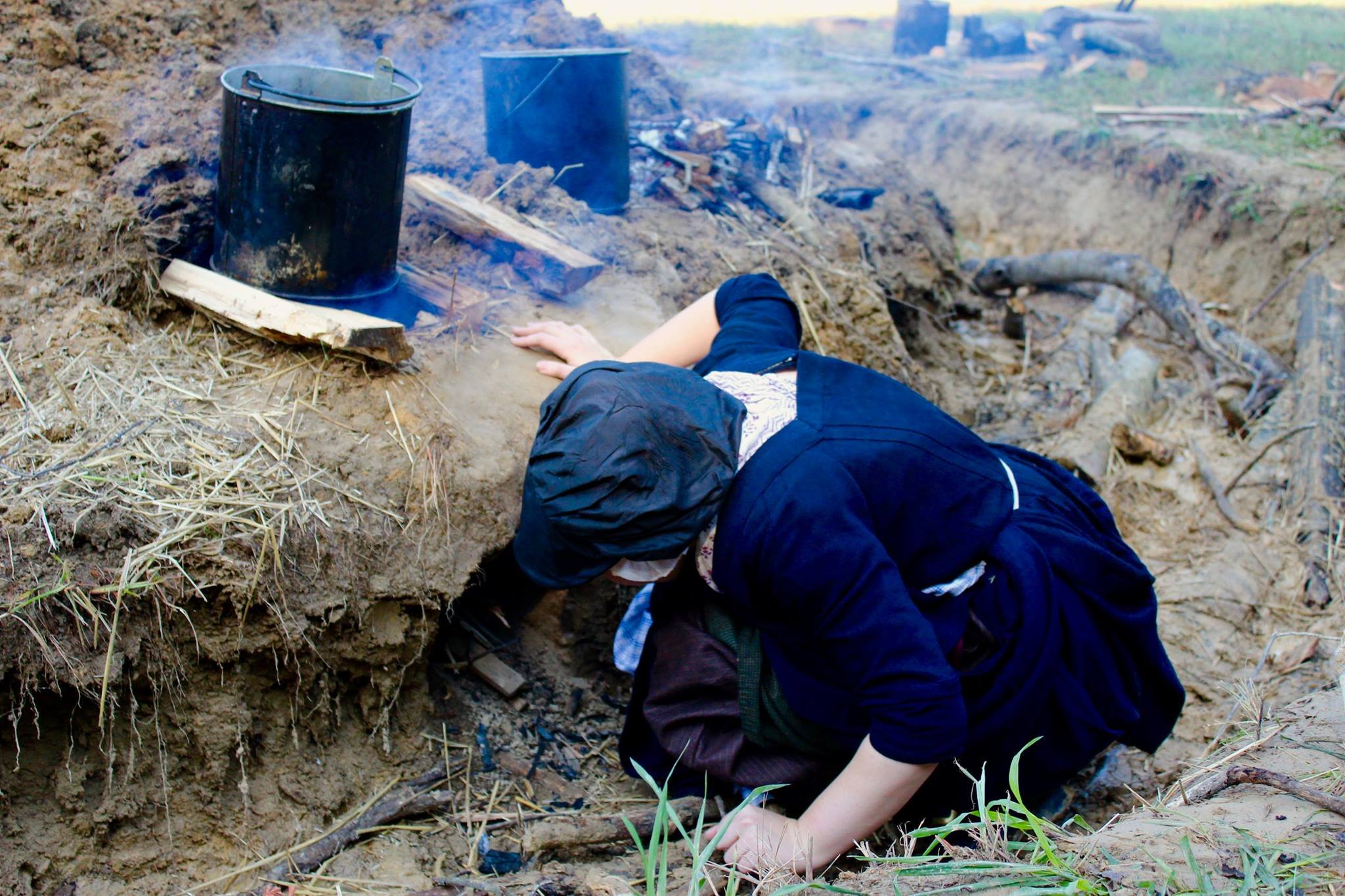 One of my backburner projects for this website has been the 17th Newsletter you see if you open the website for the first time on your browser. Personally it's a process of learning and developing a new skill. As a senior in college you can imagine the lack of time and the ability to spend a good amount of time to learn new programs by myself. Secondly, a long time work in progress has been updating the 17th Gallery. As a film major I am constantly being reminded of the importance of images in making an impression on an audience. With so many great photographers who come to events and share their work with us it is only fair that I have one place to appreciate each of the photographers per event and where their work can be viewed in one place on our website. This project being delayed is another issue of not having enough time. It is just me working on the website so I appreciate everyone's patience.
One of my backburner projects for this website has been the 17th Newsletter you see if you open the website for the first time on your browser. Personally it's a process of learning and developing a new skill. As a senior in college you can imagine the lack of time and the ability to spend a good amount of time to learn new programs by myself. Secondly, a long time work in progress has been updating the 17th Gallery. As a film major I am constantly being reminded of the importance of images in making an impression on an audience. With so many great photographers who come to events and share their work with us it is only fair that I have one place to appreciate each of the photographers per event and where their work can be viewed in one place on our website. This project being delayed is another issue of not having enough time. It is just me working on the website so I appreciate everyone's patience.
That's all for this post! Thanks for participating in the discussion of history, see you at the next event.
Remaining 17th Events 2017
Sept 15 – 17Brandywine, PA / Sandy HollowSept 30Living History at the Speaker's House, Trappe, PAOct 14 - 15Occupied Philadelphia with The Museum of the American RevolutionDec 1 - 3Garrison event at the Old Barracks Museum Trenton, NJ
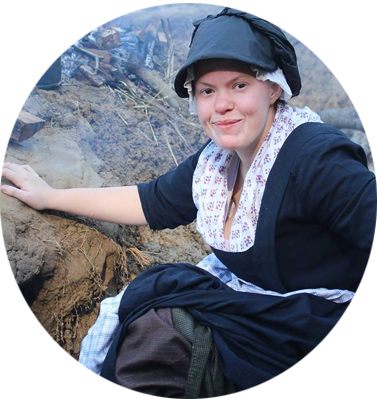 MARY SHERLOCKMary is a full time Film and Media Arts Student at Temple University, in Philadelphia, Pennsylvania and the 'head' follower for the 17th Regiment of Infantry. She has been reenacting the Revolutionary War for seven years and is continuing to do so. Mary has been the moderator of the 17th website since 2015 and has been teaching herself html code and css since 2009.
MARY SHERLOCKMary is a full time Film and Media Arts Student at Temple University, in Philadelphia, Pennsylvania and the 'head' follower for the 17th Regiment of Infantry. She has been reenacting the Revolutionary War for seven years and is continuing to do so. Mary has been the moderator of the 17th website since 2015 and has been teaching herself html code and css since 2009.
On Portraying a Member of the Religious Society of Friends During the American Revolution
My personal re-enacting story is not unlike many, I have always loved history! From an early age, in fact as far back as I can recall my family were taking vacations that always included an historic site in our plans. My mother tells the story that we would visit these places and I would have so many questions but when she didn’t have an answer I would get upset. She soon resorted to purchasing a guide book at every site we would visit. My first taste of the 18th century was Colonial Williamsburg, as time passed my obsession with history was fueled by my family who would buy me books for every occasion, mostly Civil War at this time. The 18th century interest came after seeing the film Last of the Mohicans (I know but we all had to start somewhere) and instantly knew I had to get into the re-enacting somehow… but that would have to wait.
After my Bachelor’s Degree then Graduate School I finally was at a point that I could think about a hobby. The next several years I participated as much as I could attending events with the Maryland Forces, the 3rd Battalion Pennsylvania Provincial Regiment or Augusta Regiment, then Muskets of the Crown, which was my gateway into the Revolutionary War. Then came the ultimate opportunity, at least for me at that time, I met the Augusta Co. Militia, my re-enacting family and friends for life. I fell in with the ACM after being invited to attend an immersion event at Fort Frederick MD. I finally felt like I “fit”! This group of likeminded people with a laser like focus on accuracy, research and authenticity were just the group I was looking for. I have mostly moved my impression(s) away from the military life and more towards the civilian side of things, however I occasionally field with the ACM for militia company or rifle company events but for the most part my uniforms are retired, replaced by civilian clothing.
[gallery ids="3126,3127" columns="2" size="medium"]
So, with that said when, where, and why the Quaker impression? It goes back to an event at Monmouth Battlefield where I knew I could not march nor did I have military gear correct for the impression, so civilian it was and lucky for me there was a need for civilians. There were several impressions available and I chose a New Jersey slave owner so my good friend Anna Gruber-Keifer would have someone to play off her Quaker impression with. It was a good thinking moment and I began to research the Quakers (opens HUGE can of worms) …
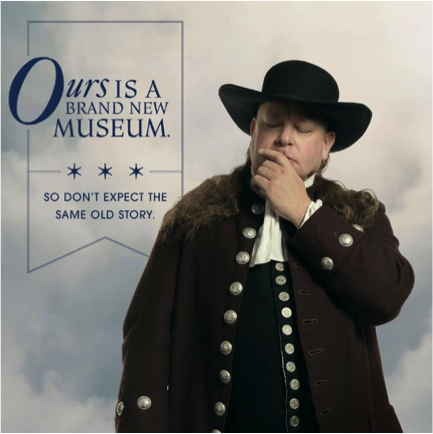
The next event was the “With Peal to Princeton” march and again the civilian contingent came out but accompanied with that was the AMAZING opportunity to be involved with a promotional shoot for the Museum of the American Revolution. I was asked if I could portray a Quaker, I said yes and knew to do it right I would have to do my homework. I as many had the vision of the Quaker Oats Man in my head as the essential costume of a colonial Quaker. Well I needed to start digging for a better basis than that.
One of the few images available for Quakers of the time is found in the Museum of Fine Arts Boston, by an Unidentified Artist. It depicts a Quaker Meeting with what appears one individual standing to give a Testimony. Here was my start, the “plain” attire consistent with the Testimony of Simplicity showed that my brown coat and black waistcoat could work. I would need to construct some breeches for the shoot. Additional research on Quaker dress of the period soon enlightened me further. Although plain dress alone does not make one a Quaker, it was simply an outward expression of faith and adherence to the tenants of the faith.
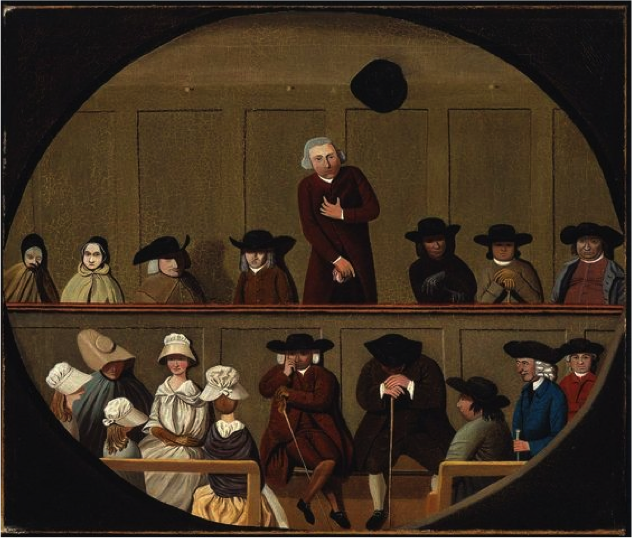 So profound was the dress that several 18th century authors made mention of it. One example comes from John Wesley (1703-1791) in The Sermons of John Wesley, Sermon 88, On Dress when he encourages his congregation to dress like the Quakers:
So profound was the dress that several 18th century authors made mention of it. One example comes from John Wesley (1703-1791) in The Sermons of John Wesley, Sermon 88, On Dress when he encourages his congregation to dress like the Quakers:
"I conjure you all who have any regard for me, show me before I go hence, that I have not laboured, even in this respect, in vain, for near half a century. Let me see, before I die, a Methodist congregation, full as plain dressed as a Quaker congregation. Only be more consistent with yourselves. Let your dress be cheap as well as plain; otherwise you do but trifle with God, and me, and your own souls. I pray, let there be no costly silks among you, how grave soever they may be. Let there be no Quaker-linen, -- proverbially so called, for their exquisite fineness; no Brussels lace, no elephantine hats or bonnets, -- those scandals of female modesty. Be all of a piece, dressed from head to foot as persons professing godliness; professing to do everything, small and great, with the single view of pleasing God"
(emphasis mine)
In his text “Letters From An American Farmer”, J. Hector St. John De Crevecoeur (1735-1813) writes: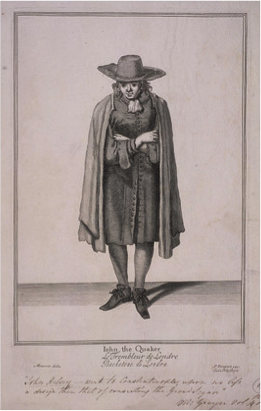
The manners of the Friends are entirely founded on that simplicity which is their boast, and their most distinguished characteristic; and those manners have acquired the authority of laws. Here they are strongly attached to plainness of dress, as well as to that of language;
Additionally I found this description of Quakers from Thomas Clarkson (1760-1846) In his book “A Portraiture of Quakerism, Volume 2 published in 1806.
"Peculiar Customs" begins with dress.
"The dress of the Quakers is the first custom of this nature, that I purpose to notice. They stand distinguished by means of it from all other religious bodies. . . . Both sexes are also particular in the choice of the colour of their clothes. All gay colours such as red, blue, green, and yellow, are exploded. Dressing in this manner, a Quaker is known by his apparel through the whole kingdom. This is not the case with any other individuals of the island, except the clergy . . ."
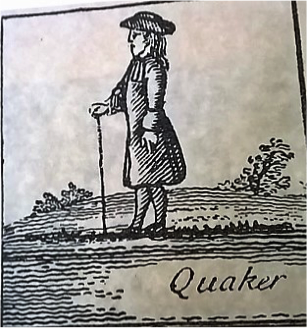
The Quaker impression went over well at Princeton, and the photos were used in a promotional campaign for the new museum. At Princeton, we had some great crowd interaction on the streets and even had the headmistress of the Friends School adjacent to the battlefield come up and engage me and others in some very meaningful conversation. With fuel for the fire I began reading more and researching the Quaker belief system, its origins, its impact on the Revolution etc.
To talk about all aspects of the Quaker religion, its impact on the social and political environment of the American Revolution is well beyond the scope of this post or my limited knowledge. I have, however over the past year begun to dig more deeply, not only on the Quaker faith but its history and impact on history. Some notable Quakers from this period were Thomas Paine author of Common Sense and American General Nathanael Greene. There are examples of Quakers participating on both sides of the conflict. As well as Quaker persecution by both sides. The most common reference to this I have found so far was regarding the “taking of oaths” which is against Quaker teachings. This led many in the faith to be branded as Loyalists and vice versa. I believe this is a good example of the difficulties many Quakers may have faced in keeping strong in faith while living in a “world turned upside down”. Recollections of the war were recorded by the likes of Phebe Mendenhall Thomas, Joseph Townsend, and Daniel Byrnes all of whom were present at the battle of Brandywine. Their stories shed some light into the thoughts and feelings of Quakers before during and after the battle.
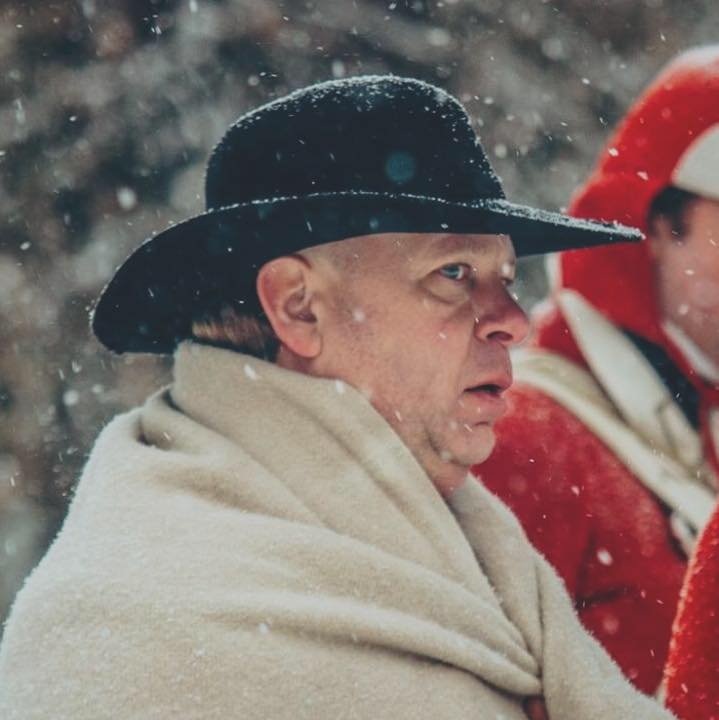
I have always been fascinated by religion from an historical perspective so digging into the Quaker belief system was only natural for me. Although not a practicing Quaker in any stretch of the imagination, the idea of attending meeting now and again if for nothing else but to sit quietly and reflect seems a very inviting opportunity. I'll report back if there is interest in my experience.
There are always common questions from the public that arise when I put on my “Quaker” kit. I get a lot of “who are you?” or “what are you doing here?” this one is especially true when at military specific re-enactments. Through trial and error, I have learned it is a good idea if one is going to represent a religion or its members, you had better know as much as you can about that religion. This is one aspect of portraying a Quaker that is an even bigger challenge for reenacting and public interactions. Here in Pennsylvania I have noticed that more often than not, you will come in contact with someone who is either a Quaker or has been exposed to the Quaker religion via a friends’ school etc. So, knowing what you are talking about IS VERY IMPORTANT.
One of the most common question that came up on a trip to the Museum of the American Revolution opening weekend was; “are you Ben Franklin?” As I don’t think myself looking much like this founding father except my generous size, I would explain “no I am portraying a member of the Religious Society of Friends or a Quaker”. Many times, this would be the end of the conversation, but I try to engage the public whenever possible throwing out the bait as to just how did the revolution impact this social, religious and political group of people and vice versa. The individual stories aside, one of the primary areas of conversation I try to engage the public in is the idea of being true to one's beliefs in a world of political change and upheaval? To me this presents a huge talking point and draws some direct relationships between the world of Revolutionary America and the America we are experiencing today.
I take re-enacting not so much as a hobby to be enjoyed on the weekends but more of a calling. I put time and effort not only into my clothing, and elements of material culture, but into my interpretation to the public. I try NOT to perpetuate falsehoods or keep the stereotypes going. I am always trying to learn, expand my knowledge and engage people in the subject I have such passion about. I know I am no expert, I am no classically trained historian I am an amateur at best but I respect the people, places, and things that constitute our collective narrative and strive to present that to those who are willing to listen.
 BRANDYN CHARLTONBrandyn is a father of three Cora, Clare and Liam, he and his wife Danielle reside in Northumberland Pennsylvania on the Susquehanna River. He has a Bachelor’s degree from Ohio University and a Master’s degree from Edinboro University of PA. He has been a Certified Athletic Trainer for the past 21 years working in the clinical, high school, and collegiate practice settings.
BRANDYN CHARLTONBrandyn is a father of three Cora, Clare and Liam, he and his wife Danielle reside in Northumberland Pennsylvania on the Susquehanna River. He has a Bachelor’s degree from Ohio University and a Master’s degree from Edinboro University of PA. He has been a Certified Athletic Trainer for the past 21 years working in the clinical, high school, and collegiate practice settings.
He currently works in the occupational/industrial setting providing ergonomic services to clients in the Harrisburg area.
The Making of a “Massacre” Simcoe’s Surprise Attack at Hancock’s Bridge
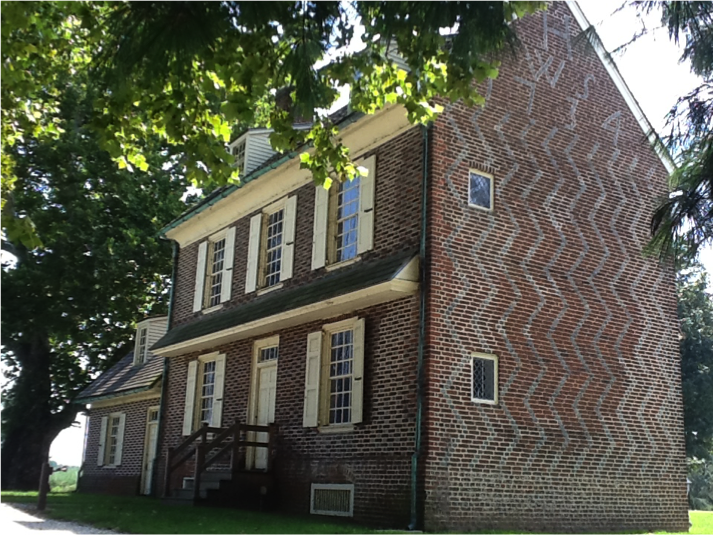
While the British army was quartered in Philadelphia for the winter of 1777-78 foraging parties were frequently sent out to gather supplies. One such expedition was sent to Salem County, New Jersey in March of 1778. British engineer, Captain John Montressor, recorded in his journal on March 11th:
“The Roebuck removed from the wharves into the stream and the Camilla fell down the river and in the afternoon followed her a detachment of 1,000 men under the command of Col. Mawhood, 17th, 27th, and 46th Regiments, Simcoe’s Rangers.” [1]
Upon arrival to Salem on the 17th of March, Mawhood had all intentions of keeping peace with the local population and to pay for all provisions taken. Major Simcoe writes: “Colonel Mawhood had given the strictest charge against plundering…” [2] but before the expedition was over, the Queen’s Rangers would spark outrage and distain by their treatment of the local rebel militia at Quinton’s Bridge, on the 18th and at Hancock’s Bridge on the 21st. The later would be called a “massacre”.
When the British arrived and took control of the town of Salem, the local militias formed to try and impede Mawhood’s movements. The Alloway, a tidal creek of the Delaware River south of Salem, was chosen as a natural defensive line by the militia to stop the British from moving towards Bridgeton. There were three crossings over the creek: Hancock’s Bridge (closest to the Delaware), Quinton’s Bridge (in the middle) and Thompson’s bridge (furthest east), and each would be guarded.
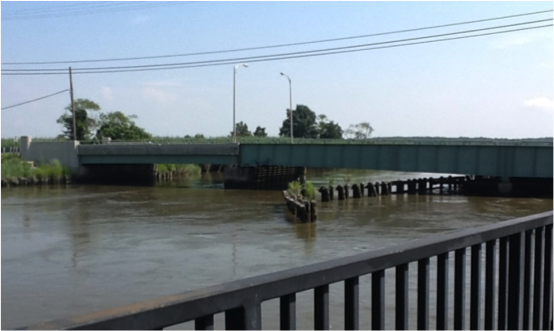
The first skirmish between Mawhood’s force and the militia occurred on the 18th of March and involved a foraging party of the 17th Regiment of Foot and the Queen’s Rangers. The rebels were bloodied and many were killed or captured, but the defenses held because of timely reinforcements from Bridgeton. Frustrated by the resistance of the locals, Mawhood determined to attack Hancock’s Bridge and gave the task to Major Simcoe and his Rangers, with support from the 27th Regiment of Foot. Simcoe gives his account of the action:
“Colonel Mawhood determined to attack them at [Hancock’s Bridge], where, from all reports, they were assembled to near four hundred men… [The Queen’s Rangers] embarked on the 20th, at night, on board flat bottom boats… everything depended upon surprise. The enemy were nearly double his numbers... [The Rangers] land[ed] in the marshes, at the mouth the Aloes creek… after a march of two miles through marshes… they at length arrived… upon dry land. Here the corps was formed to attack… On approaching the place [Hancock’s Bridge], two sentries were discovered: two men of the light infantry followed them, and as they turned about, bayoneted them…the light infantry… reached Hancock’s house by the road and forced the front door, at the same time that Captain Dunlop… entered the back door; as it was very dark, these companies nearly attacked each other… The surprise was complete, and would have been so, had the whole of the enemy’s force been present, but, fortunately for them, they had quitted it the evening before, leaving a detachment of twenty or thirty men, all of whom were killed… Some very unfortunate circumstances happened here. Among the killed was a friend of the government… old Hancock, the owner of the house… events like these are the real miseries of war.” [3]
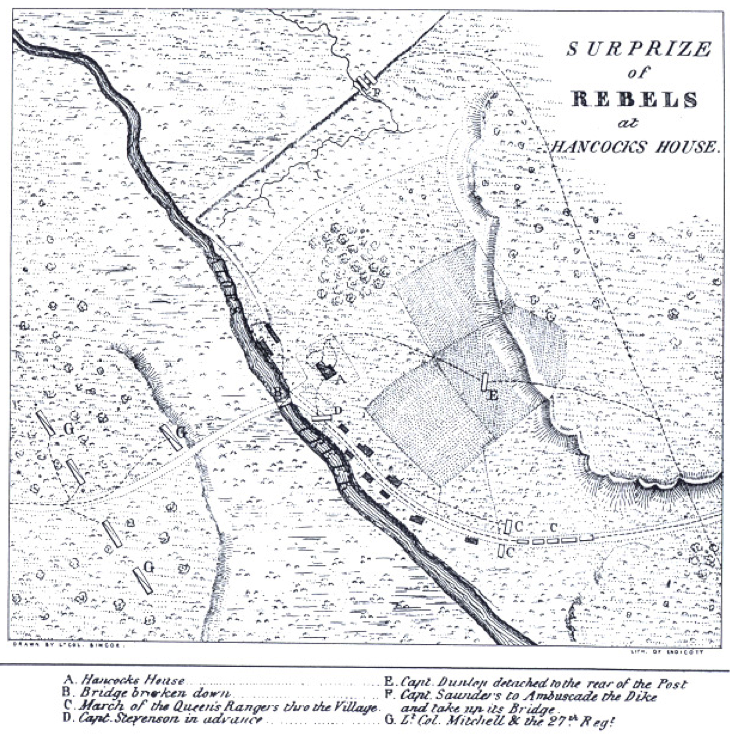 Though with somewhat inflated militia numbers, another defense of the Ranger’s actions comes from author James Hannay’s book History of the Queen’s Rangers:
Though with somewhat inflated militia numbers, another defense of the Ranger’s actions comes from author James Hannay’s book History of the Queen’s Rangers:
“Capt. Dunlop's and Stephenson's companies attacked those in the house with such fury that every man in it was killed. This was a lamentable occurrence and has enabled American writers to assert that these men were massacred, but it must be remembered that it was a night attack and that Simcoe's Rangers, instead of this insignificant detachment, expected to meet a force of at least 700 or 800 men, and, of course, a desperate resistance was expected.” [4]
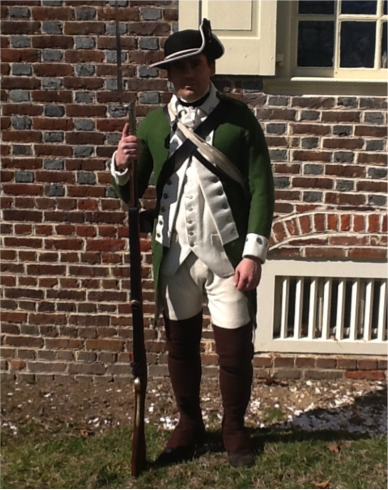
There is still a cloud of confusion surrounding the number of militia actually present that night and how many men, including civilians, were killed. Simcoe states that “all were killed”, but other accounts maintain that there were prisoners taken. British Military Engineer, Archibald Robertson was on the expedition to Salem and recorded in his journal:
“This night [20th of March] Simcoe’s Rangers embarked in the flat boats and went round to the south side of Alloes Creek to surprise the Rebel post at Hancock’s Bridge. The Rangers got behind the Rebels. Killed 16 and took 11 prisoners.” [5]
Lt. Reuel Sayre, one of the militia members attacked at Hancock’s Bridge, recalled later:
“…they came upon us by surprise… All were killed, left for dead or taken prisoners but myself… I had one brother killed and one taken prisoner in this night affair.” [6]
The main purpose of the attack was to gain the south side of the bridge, not to put all to death and quarter was given to some. Simcoe was surprised at the lack of resistance and did not know the Rangers were attacking so few. He expected only the officers to be quartered in the Hancock House, not the entire guard. Captain Carlton Sheppard’s company militia was the only one stationed at the bridge, and was quickly overpowered. When the attack was finished, Simcoe laid the planks down over the bridge in order to confer with Lt. Col. Mitchell of the 27th Regiment, waiting on the other side of the creek, as what to do next:
“Major Simcoe communicated to Colonel Mitchell, that the enemy were at Quinton’s Bridge; that he had good guides to conduct them thither by a private road, that the possession of Hancock’s house secured a retreat. Lieutenant-Colonel Mitchell said, that his regiment was much fatigued by the cold, and that he would return to Salem as soon as the troops joined. The ambuscades were of course withdrawn, and the Queen’s Rangers were forming to pass the bridge, when a rebel patrol passed where an ambuscade had been, and discovering the corps, galloped back. Lieutenant-Colonel Mitchell… being informed of the enemy’s patrol, it was thought best to return [to Salem].” [7]
Though the Queen’s Rangers were successful, they again gave up the south side of the Alloway Creek. The outcome of the attack had a demoralizing effect on the militia. When word spread of the affair at Hancock’s Bridge, the resolve to continue a defense at the Alloway dissolved. Colonels Hand and Holme of the militia wrote Governor Livingston:
“We have made our stand on Alloways Creek… but last night the enemy landed out of their boats… and surrounded our guard at Hancock’s Bridge and took and killed almost all of them… we fear they will advance over all these lower counties… we find our numbers at present are not large enough to make a proper stand against them…” [8]
The militia moved south nearly 18 miles to Cumberland County and made the Cohansey River their new defensive line, leaving all of Salem County open to British foraging. After 6 more days of collecting supplies, the British embarked on their ships on the 27th of March and headed back to Philadelphia. The scars left on the inhabitants of Salem County were not easily forgotten. The Hancock House “Massacre” became a rallying cry and may have helped bolster Washington’s ranks in the spring of 1778:
“The nightmare of sanguinary warfare cause by the affairs at Quinton and Hancock’s Bridge produced one effect… the ire of the local militia had been excited because the raiders had escaped practically free of any kind of punishment. As matters of patriotism and retaliation the militia began to enlist in increasing numbers in the State and Continental Army troops.” [10]
One story passed down through history demonstrates the lasting resentment that formed due to Simcoe’s attack at Hancock’s Bridge and the “massacre” that occurred there:
“Later Judge Hancock’s son and a Mr. Sayer, whose father had been killed in the massacre, traveled to Philadelphia by water. They were standing on the wharf talking with two strange men when Sayer fell overboard. One of the strangers jumped in and rescued him. Mr. Sayer asked, ‘To whom am I indebted for saving my life?’ When the man told him he was the son of Colonel Mawhood, Sayer said, ‘I’ll be damned if I’ll be saved by the son of the murderer of my father!’ and jumped in the river again. He was rescued with difficulty.” [11]
It seems that Colonel Mawhood and Major Simcoe will forever be associated with the Hancock House “massacre”, deserved or not.
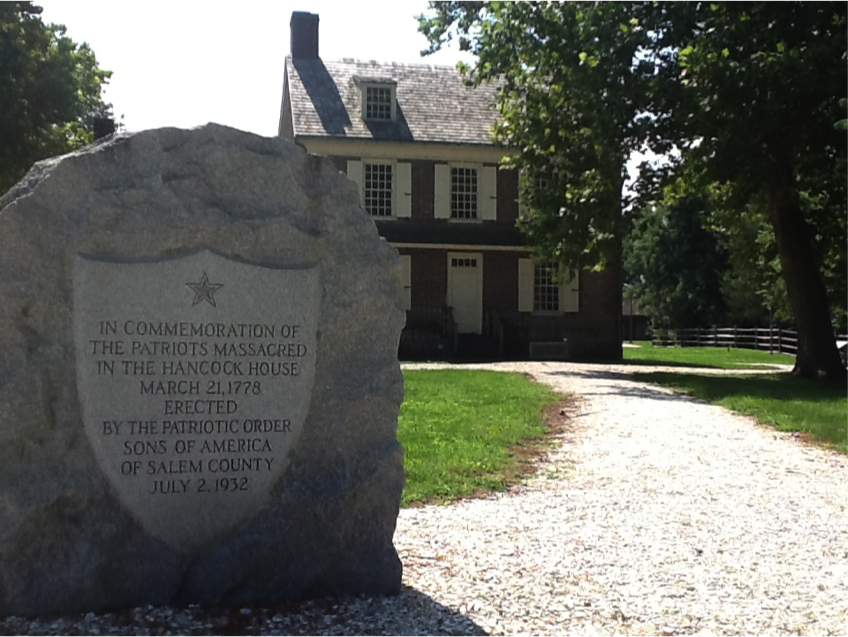
Footnotes:[1] Frank H. Stewart, Salem County in the Revolution (Salem: Salem County Historical Society, 1967) 45-47.[2] John G. Simcoe, John G. Simcoe’s Military Journal (Cranbury: The Scholar’s Bookshelf, 2005) 46.[3] Simcoe, Military Journal, 50-52.[4] Donald J. Gara, The Queen's American Rangers (Yardley: Westholme Publishing, 2015) 116-118.[5] Ibid., 141.[6] Stewart, Salem County in the Revolution, 63[7] Ibid., 61.[8] Simcoe, Military Journal, 53.[9] Stewart, Salem County in the Revolution, 65.[10] Ibid., 86.[11] Irene Y. Hancock, In the Shade of the Old Oak (Salem: Salem County Historical Society, 1964) 15.
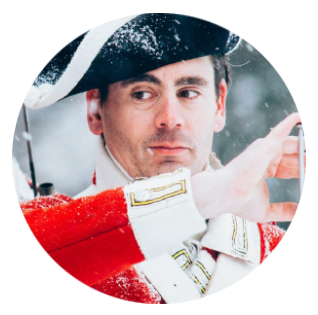 WILLIAM MICHELWilliam is a member of the 17th Regiment. He has volunteered and worked at several historic sites, including Valley Forge National Park, Graeme Park, Monmouth Battlefield State Park and is the current historian at the Hancock House State Historic Site in Salem County, NJ.
WILLIAM MICHELWilliam is a member of the 17th Regiment. He has volunteered and worked at several historic sites, including Valley Forge National Park, Graeme Park, Monmouth Battlefield State Park and is the current historian at the Hancock House State Historic Site in Salem County, NJ.
The Hancock House is located in Southern New Jersey. The historic site plans to host an event in Mid March of 2018 to commemorate the massacre. More information is coming soon.
Arms and Equipment: Cleaning the Firelock, part 2.
This installment of Arms and Equipment will be focused on surface treatments forIron, Steel and Brass.
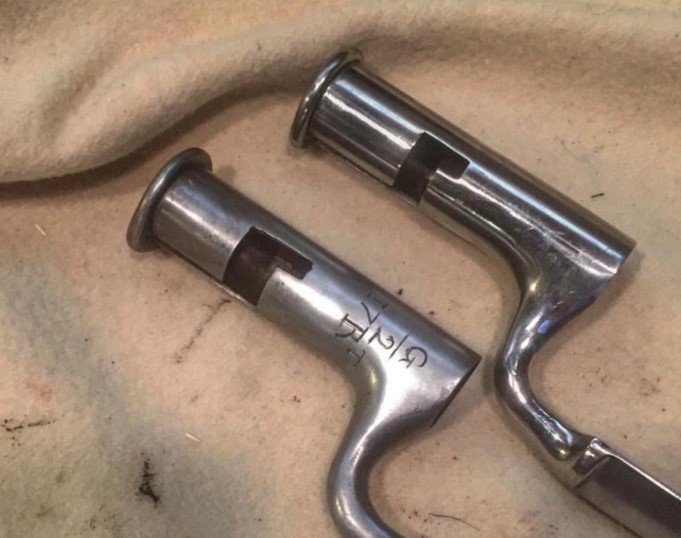
Two Reproduction Bayonets likely made in the same factory overseas. Typically, many reproduction arms are mirror polished, inconsistent with known artifacts, and tools used by soldiers of the American Revolution. Cleaning arms correctly can be a very cheap way to begin “de-farbing” your firelock.
In 1786, Oxford Militia Serjeant Major Henry Trenchard published a pamphlet entitled “The Private Soldier and Militia Man’s Friend”. The Volume is an interesting look into the ordinary, day-to-day maintenance necessary for service in the militia or the regular Army. Just over 30 pages, Trenchard devotes half of the work to maintaining cleanliness of arms, accouterments and uniforms and contains valuable recipes and techniques used by the ordinary enlisted soldier:
“First you must provide yourself with a hand-vice, screwdrivers, rubbing sticks, and leather free from grease, oil, emery, crocus martis, &c. The rubbing sticks for the arms should be made of deal wood of different sizes,, with leather glued on in the following manner: Make the rubbing sticks very smooth, and on one side of it lay down the hot glue, and on this lay your leather and press it down; then lay some glue on the leather, and on that lay some emery, and press it a little into the glue, them be well dried; with this use oil and emery, brick dust &c; if you apply them properly by rubbing the arms well, they will give your arms a smooth surface you are next to proceed to polish them; take crocus martis, and clean dry leather, rub the part which you want to polish until it is warm, when it will acquire a very fine darkgloss”
Trenchard’s above description of the rubbing sticks, serve as polishing strops, used in sharpening and polishing metal. A hint of what these may have looked like is from the Diderot’s Encylclopédie depicting tools from the cutler or Coutelier. One of those tools, described as a cuir à repasser, which was a “leather board” for polishing.

Another example of such a tool is in the French manufactured traveling case of Frederic Franck de la Roche, who served as an aide-de-camp to Marquis de Lafayette, in the collection of the Maryland Historical Society. From the original pasteboard case, it is clear that the strop was to be used with polishing razors for shaving.
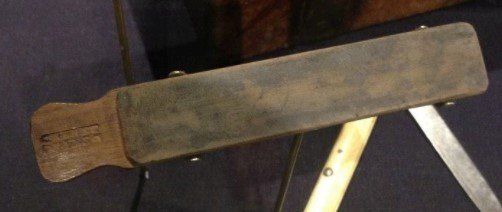
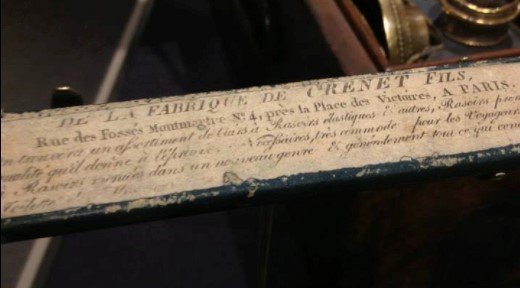
A few years ago I made this little strop, with a piece of scrap wood. Contact cement is a good adhesive if you’ve never used hide glue before. I used a piece of buff leather. I made it small to easily fit in any type of cartridge pouch, or pocket.
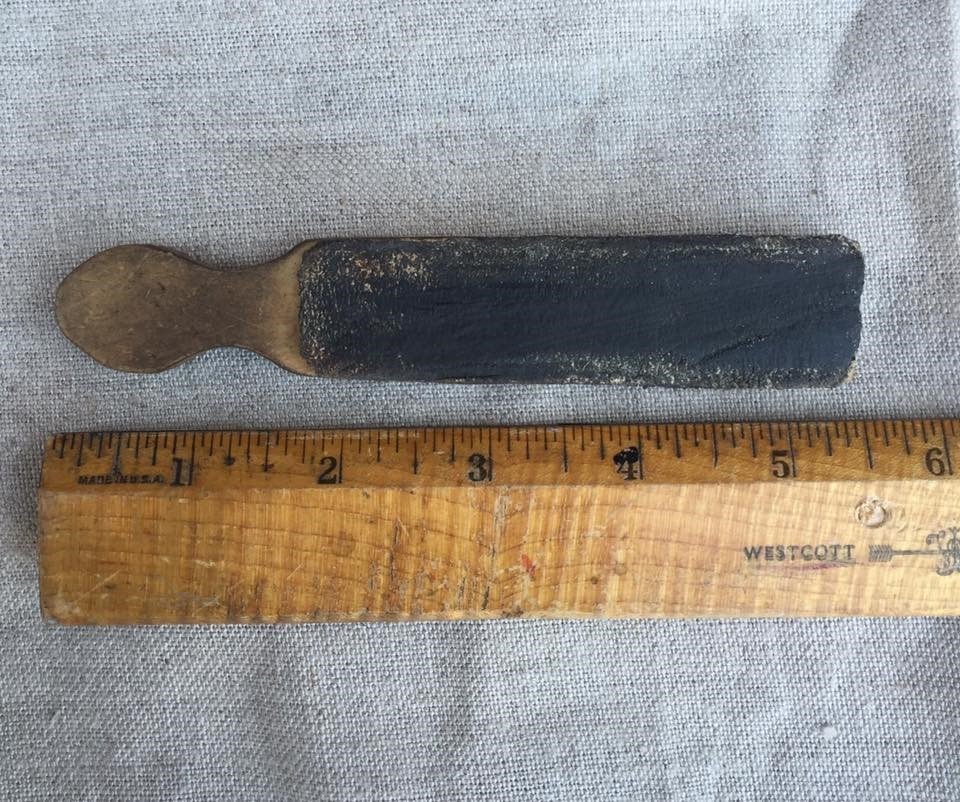
Such polishing boards/strops can be extremely useful in getting metal mirror bright. However, such a finish is unnecessary to strive for during ordinary cleaning “in the field.” All that is needed is oil, leather scraps, linen scraps or tow, and brick dust.
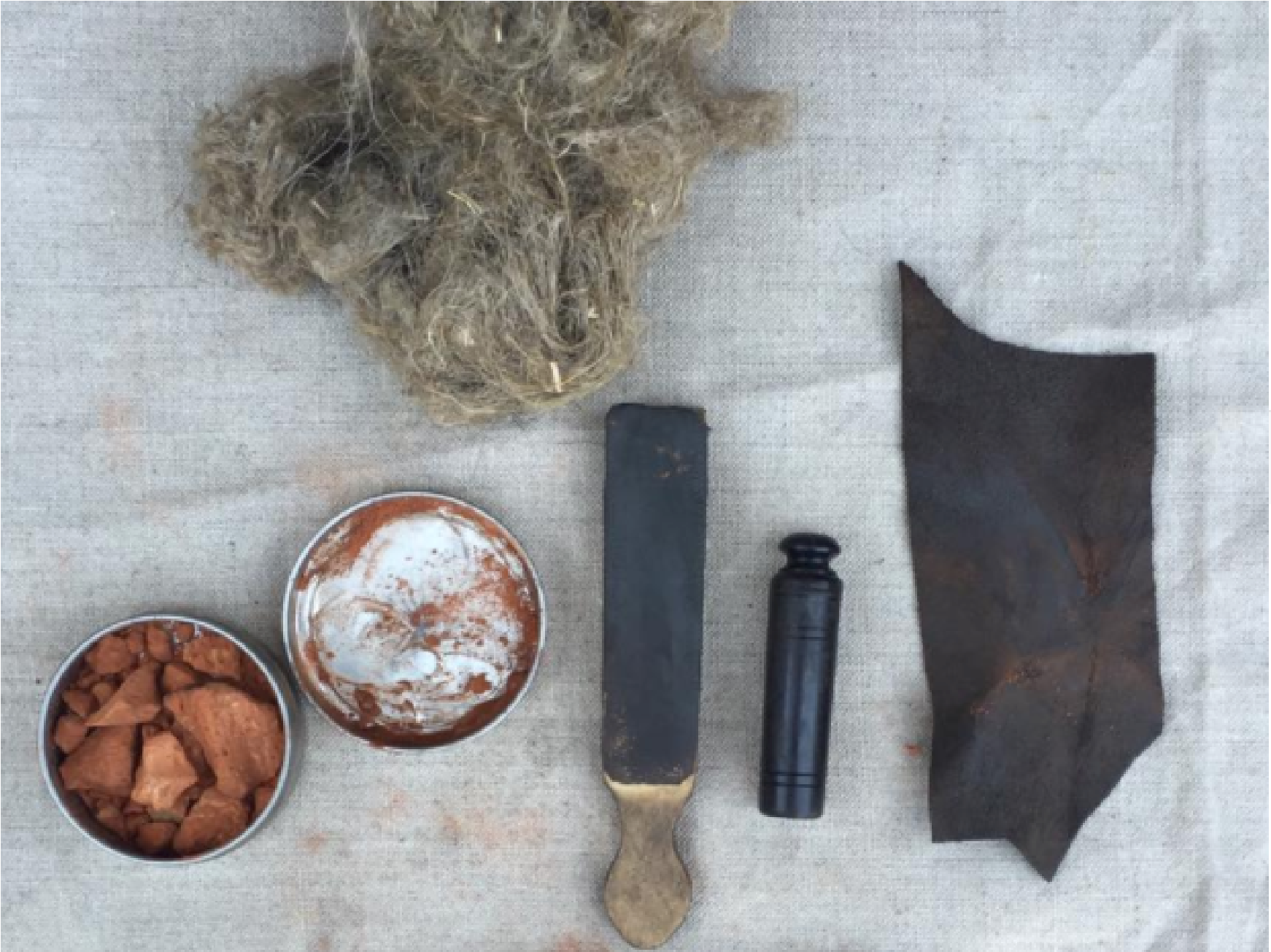
First, take two small pieces of brick and rub them together, collecting the dust in a small container. Take your Leather and/or strop and apply a little oil. Apply brick dust into leather by dipping or sprinkling; rub in a circular motion throughout the entire surface you wish to polish.
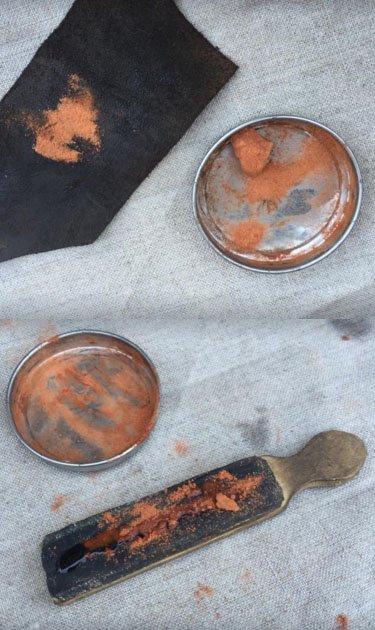
The Strop is very useful for flat surfaces, and areas of heavier rust. The leather scrap is very useful in curved and hard to reach areas. Experiment with your own techniques. For bigger polishing jobs a “paste” made from oil and brick dust can be very convenient. The more you polish the better it looks!
Sword before polishing:
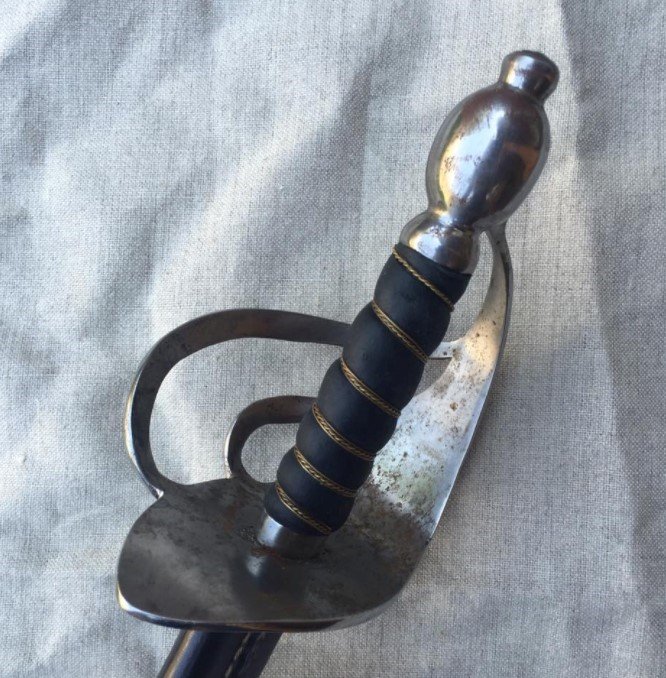
Typical light rust from carrying in the field.
Sword after polishing:
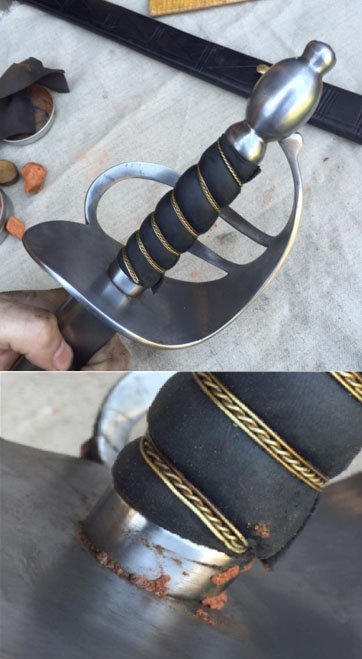
Once complete, wipe down with a piece of tow, or scrap linen, cleaning out tight spots of brick dust.
Repeat as necessary. A final polishing option is to use rotten stone (a Google search revealed many places to purchase) in a similar manner on a separate clean piece of leather for a final polish, or as Serjeant Major Trenchard put it “a very fine gloss”.
After handling, a quick wipe-down with a lightly oiled rag will help keep rust fromdeveloping.
Thanks to Google Books, Trenchard’s book is available for free online:Google Books

ANDREW KIRKhas been involved with American Revolutionary War living history since the age of 13. Taking an interest in material culture of the British Army has led to creating reproductions of artifacts for TV, Film and Museum Projects. Trained as a fine artist and educator at Maryland Institute College of Art and has been a secondary art teacher in Maryland for 7 years.
Arms and Equipment: Cleaning the Firelock, part 1.
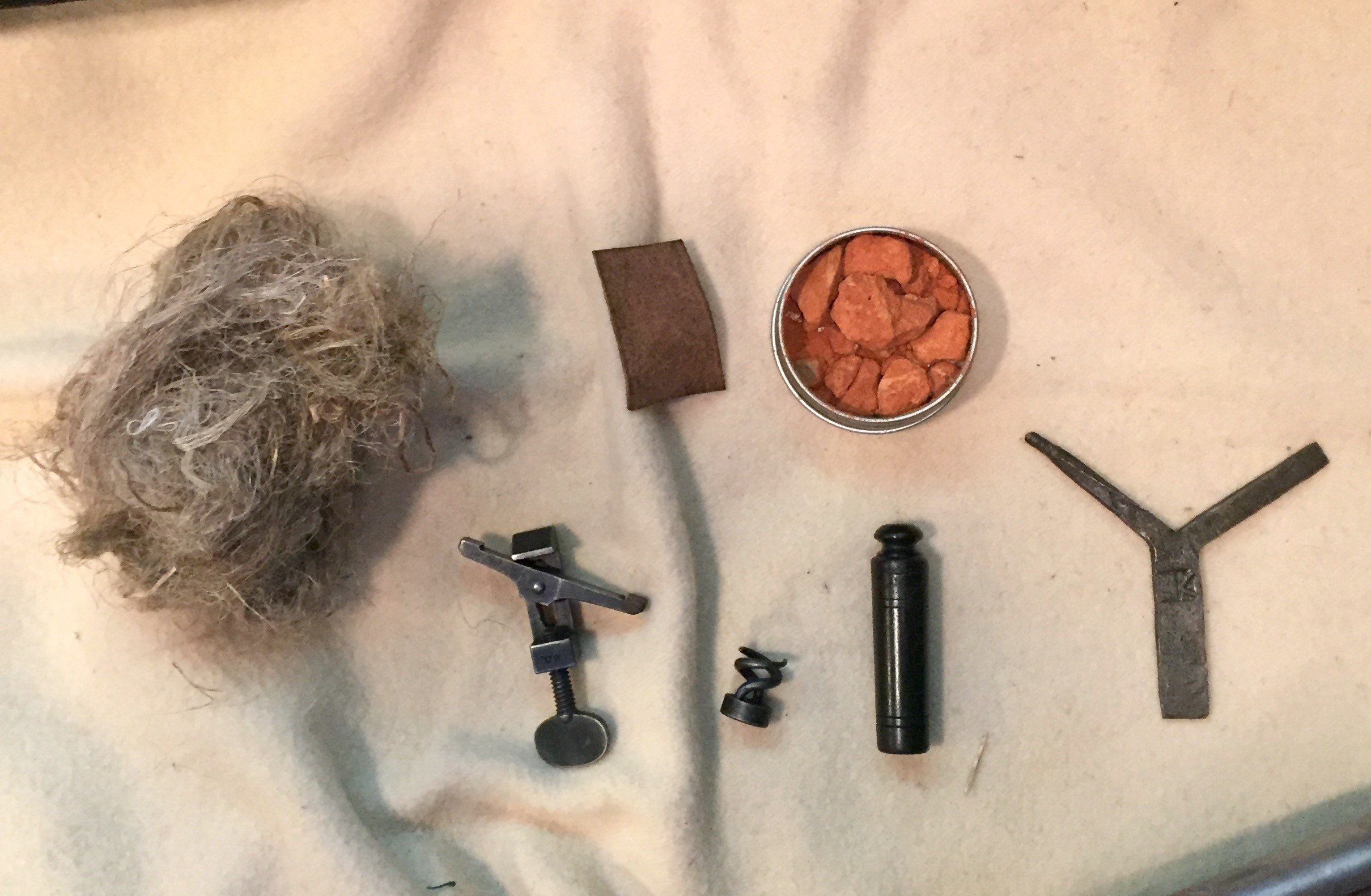
The best and in-depth treatise on cleaning arms is the works put together by John U. Rees, published here: https://www.scribd.com/document/292985859/The-Care-and-Cleaning-of-Firelocks-in-the-18th-Century-A-Discussion-of-Period-Methods-and-Their-Present-Day-Applications
This will be beginning of a series on the blog, highlighting the practical application and use of period techniques for maintaining arms and equipment. Today’s post focuses on having the essential tools you need to keep your firelock clean.
Turnscrew: of the “Y type” is the more commonly found tools, and provides two blades for different sized slots. Reproduction by Jymm Hoffman: http://www.hoffmansforge.com/
Worm: An essential tool, threaded to fit the threaded end of the ramrod, is the tool use to attach tow, or small bits of rag to clean the inside of the barrel.
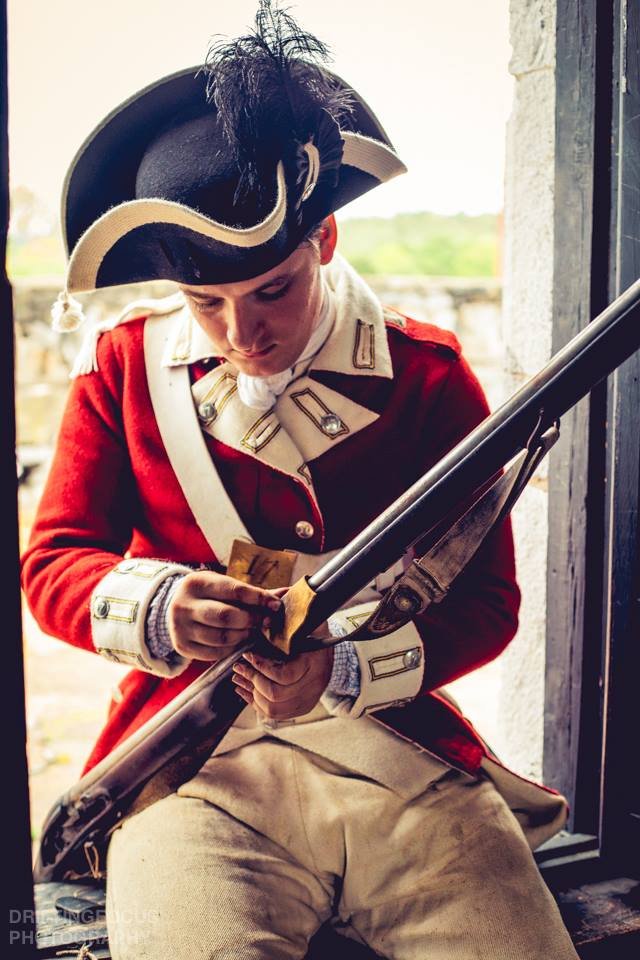
Hand-Vise, or Spring Vise: This particular example is a 19th century vise made for use various muskets and rifled muskets. Similar to others from earlier, though there may have been various types, this type is commonly reproduced. This tool is an extremely important device for “taking the lock to pieces”, an occasional, in depth cleaning of the lock. Trying to disassemble a lock without can result in cracked springs and other damaged parts.
Oil Bottle: A container turned from Horn by Erv Tschanz(http://www.gennisheyotrading.com/), for holding sweet oil for oiling parts for lubrication and rust prevention.
Tin Bottles designed from originals are also available from http://www.hotdiptin.com/
Brick Dust: Stored in a small tin, are several chunks of 18th century bricks, from demolished buildings of Salem County, NJ. The tin makes using the brick dust very convenient and easy.
Scraps of Leather: Having a leather shop, I have quite a bit of scraps of various leathers. I like to have a small scrap of 2-3oz vegetable-tanned leather in my cartridge pouch at all times. Keeping one scrap as the “applicator pad” and the other as the “final polish” is another approach. Many leather supply companies sell scrap bags.
Tow: Loose fibers before being further processed and spun into threads and woven. As simple as it gets, great for use with the worm and final wipe-down. Linen scraps/rags also work well for most purposes. https://woolery.com/flax-tow-1-lb.html
That’s it for this installment. Next time I’ll be discussing how to easily use these items to keep your firelock clean and ready for service in the field.
Andrew Kirk

The Things We Carry: On the Strength of the Army
A couple weeks ago we had a member of the 17th Regiment of Infantry, Damian Niescior, write about all the things he carried during a weekend in the 18th century as a soldier in the British Army... this week we have a follow up post brought to you by Carrie Fellows, who has been working and recreating 18th century domestic arts for more than 25 years. A year or so ago Carrie did a symposium with Kimberly Boice's: Historie Academie, which I happened to attend where she did a talk and workshop on how to pack for an event. So upon request it reminded me that she'd be the perfect fit to talk about what a follower of the army would bring with them.
Read Damian's blog post here.
- Mary S. an attached follower of the 17th Regiment of Infantry
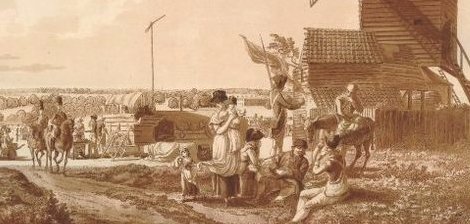
It can be difficult to explain to people what I do for fun. I combine my passion for history and the outdoors by interpreting the lives of women who, out of necessity, followed the Continental Army (and occasionally, the British army) during the American War for Independence. I have portrayed a laundress, an officer’s servant, a refugee, and a soldier’s wife, but regardless of whom I portray, the things I carry with me may vary slightly according to season, but remain essentially the same. Over the years, I have refined and limited the number of objects I carry, lightening my load for travel on foot over long distances, rough terrain, and the occasional river ford.
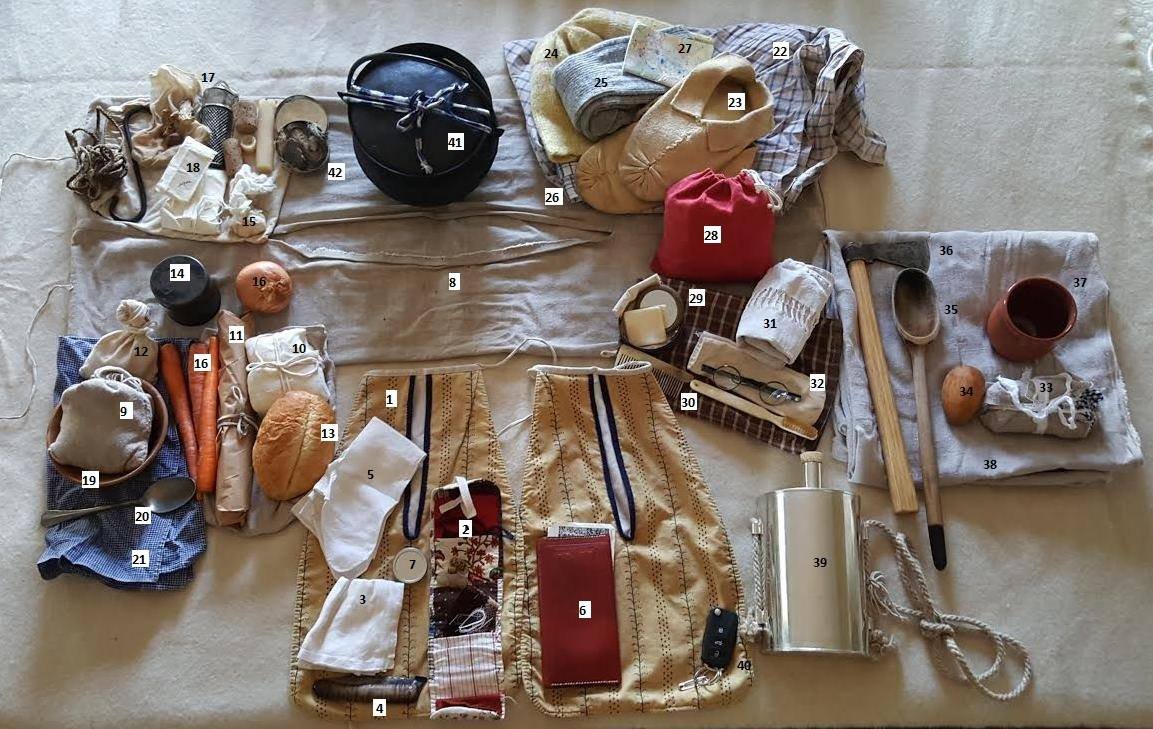
Records of what women carried are practically nonexistent, but one can find clues in runaway ads, military records, and the occasional primary source. Women attached to the army had only what they brought away with them, or acquired on the road. Women “on the strength” of the army were entitled to a half-ration of food (children received a one-quarter ration.) I am always hungry, and as rations aren’t always available, carry enough food to get by.
Tied about my middle, under my gown, a pair of pockets (1) is suspended. These contain both modern items (pocket on right) and period ones (pocket on left). I often leave my phone in the car unless I need to take photos for a talk or article, or will be in the deep backcountry.* My car keys (40) are pinned firmly to the inside bottom corner of my left pocket. In my right pocket: a sewing kit (2) or “housewife” – a roll of cloth with pockets to hold sewing supplies and tiny items like sleeve buttons, also a linen handkerchief (3), pocket knife (4), linen or woolen mitts (5), period scrip and real cash in a reproduction pocketbook (6), lip balm in a tin container (7).
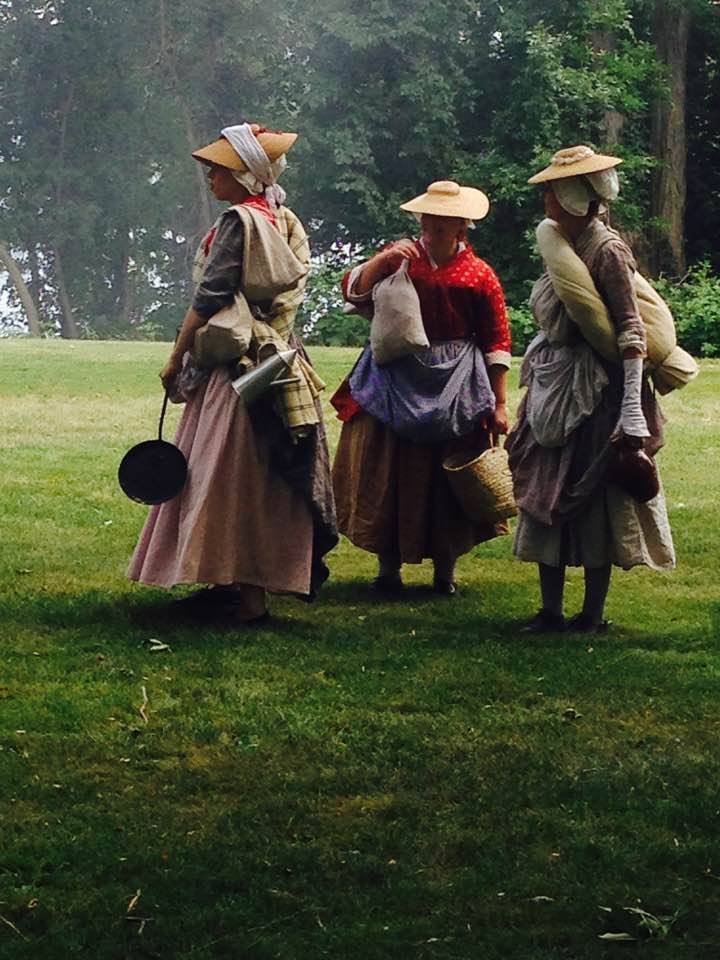
I carry most of my gear in a wallet (8) – a rectangular cloth bag with a slit opening in the center. One places items in each end, then twists the entire thing at the center, closing the slit and forming a kind of narrow strap, then slung over the shoulder. I try to segregate the two ends into food/related items and clothing/personal items. The food side holds a small bag of cornmeal or rice (9), cheese wrapped in 2 layers of linen (10 - the inner one dampened with vinegar); a cured sausage wrapped in brown paper (11), a small bag of walnuts (12), bread (13), tea (14), salt (15), seasonal vegetables (16), a spice bag, grater, candle ends and extra corks (17), paper packets of flour and pepper (18), and sometimes I even remember my fire kit: flint, steel, charcloth and tow in a tin box (42). Food-related items include a turned wooden bowl (19), which can serve as both drinking and eating vessel, an eating spoon (20), and a linen towel (21).
In the other end, I carry extra clothing items tied up together in a large kerchief (22): moccasins (23) and a man’s wool cap (24) for sleeping in, stockings (25), neck handkerchief (26), and a small paper notebook (27). Some also carry a clean shift, but I do not, as I am rarely in a situation where there is privacy sufficient change it. Also: a tiny modern first aid kit in a red linen bag (28), personal toiletry items in another small drawstring bag: a tin box with soap and mirror (29), horn comb and bone toothbrush (30), handwoven wash towel (31), spectacles (32), allergy meds &, contact lens case (not pictured). Reenactor etiquette requires one to manage any non-historic personal care out of view as much as possible. Optional items, depending on the planned activity: a small bundle of mending patches and yarn (33), and a darning egg (34) to occupy time and to trade (mending skills have value), a large wooden cooking spoon (35), and a small axe (36). If there’s room, “luxury” items include a ceramic cup (37) and a big linen wallet that doubles as a straw tick (38).
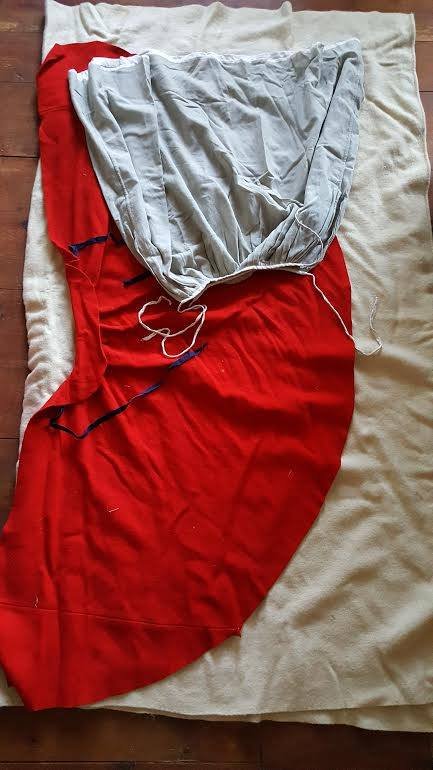
I usually carry just one blanket (with a wool petticoat and cloak inside) rolled up, tied together at the ends to form a “U”, and carried across my body. I put on the wallet first, then the canteen (39) - the wallet cushions the strap - then the rolled blanket over that. The blanket helps keep both wallet and canteen secure, close to my body, and quiet as I walk – or run.
The last thing I pick up is my small iron pot (41), with its sheet iron lid tied on so it doesn’t rattle or become lost. If I have eggs or fruit, I pack it in the pot. It goes to every event with me. I hadn’t thought about it before, but that little pot – representing security, hot food, comfort (and home?) connects me to the women I portray who carried what they most valued when they followed the army.
*Nothing ruins an accurate setting faster than when the smartphones come out and glow blue at night.
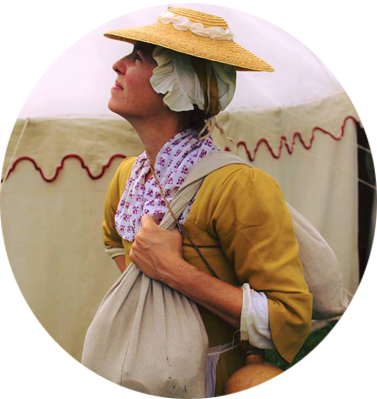 CARRIE FELLOWShas been interpreting 18th century domestic arts for more than 25 years and is the Sergeant of Women for the progressive living history group, Augusta County Militia. She has held positions in history nonprofits and museums as a curator, educator, director, and board member, and is currently the Executive Director of the Hunterdon County (NJ) Cultural & Heritage Commission. She and her husband Mark are addicted to old houses.
CARRIE FELLOWShas been interpreting 18th century domestic arts for more than 25 years and is the Sergeant of Women for the progressive living history group, Augusta County Militia. She has held positions in history nonprofits and museums as a curator, educator, director, and board member, and is currently the Executive Director of the Hunterdon County (NJ) Cultural & Heritage Commission. She and her husband Mark are addicted to old houses.
The Malicious, Morose Malady and the Vindictive, Vagrant Vixen: A 17th Regiment Story, Part 2
In this week's blog entry, we return to finish the tale of Private Thomas Mallady's post-war adventures, initially chronicled this past May by guest author Don Hagist. While the documentary trail might not give us all the information we could hope for, there are some clear messages about the nature of marital disharmony in post-war New England that should give any would-be deserter food for thought. For more soldiers' stories, check out Don's blog: British Soldiers, American Revolution.
Click here for Part I
-- Will Tatum
Part II
The next week's issue of the Western Star, on 18 September, carried Thomas Mellalew's response, this time datelined from Pittsfield:
"To the Publick.Whenever the character of an individual is notoriously attacked, it is incumbent on him, if he has any regard for his reputation, or respect for the opinion of the world, to come forward in his own defence. The writer is sensible that a private controversy between a man and woman, is not a very pleasing subject for the attention of the community: His only excuse is, that he write in his own defence.
"In the Star of last week, was published a piece under the signature of Hannah Mellalew - a performance in which my character is represented as black as the pen wielded by the hand of falhood [sic] could possibly describe. A publication, signed by a woman, the blackness of whose character my modesty will not permit me to lay naked to the view of the world - a woman with whom had it have been possible for any man to have lived, would not have been under the necessity of strolling about after a second gulled companion, while the first was still living. Let any ingenuous mind read the performance to which I allude, and then say, if any but an abandoned prostitute could ever have come forward with such a publication in the face of the world. No, not a woman on earth, who is not totally devoid of every species of virtue, could have assumed the impudence to publish such brothel ideas of a man, whom she claims as her companion.
"The charges alledged against me in that piece, it is in my power, at any time to confute. But I do not conceive that a Newspaper is a proper place to produce affidavits to establish the character of any man.”
"Neither do I believe that the publick are so strongly inclined to believe any man a villain, as, without proof, without witnesses, or even the appearance of truth, to give credit to the aspersions of a malicious, vindictive, vagrant vixen. Thomas Mallady.Pittsfield, Sept. 1792."
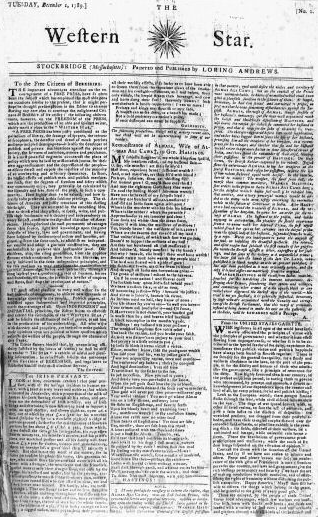
It didn't end there. The next week's issue of the Wester Star, dated 25 September, contained Hannah's next volley, this one a barrage including statements from other individuals:
"To the Publick.Thomas Mallady (or Mellalew) having asserted in the paper of last week, that the charges I have exhibited against him are not true, the following are submitted to the inspection of the publick. Hannah Mellalew.
"Middletown, February 18, 1778."These may certify that Thomas Mellalew and Hannah Andrews were married on the day of the date above, according to the form in the office for the solemnization of marriage, in the book of common prayer, by me, Abraham Jarvis, Minister of the Church of England.
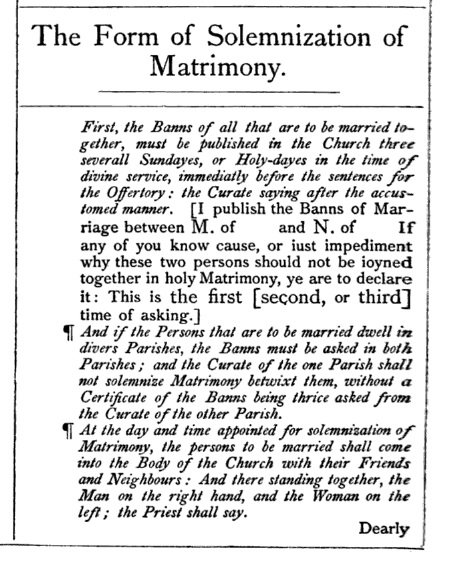
"These may certify whom it may concern, that Thomas Mellalew (or Mallady, as many persons called him) some years since lived in this town with his wife; and, while he lived in this town, he advertised his wife in the Springfield Newspaper, lest she should run him in debt when he was absent; and afterwards put in another advertisement, wherein he manifested his sorrow for the first, and said he had no foundation or just cause for publishing the first.
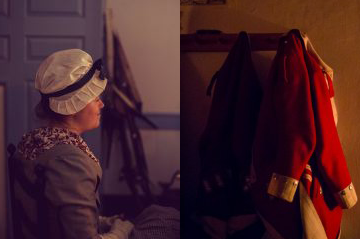
Furthermore, while he lived in this town, he made an appointment to meet a Negro's wife, at a certain place in the night time, in a certain barn; and the Negro's wife informed Mrs. Mellalew of the appointment, who procured sundry persons, one of whom was dressed in a woman's clothes, to meet at the time and place appointed, when and where Mellalew attended in the dark, and his conduct was such, as caused them to lead him home to his wife; and he did not deny his intent in going to the barn, and in the barn called the Negro's wife by name several times, before the persons lying in wait discovered themselves. The substance of the above was sworn to before me, as nearly as I can recollect, by two of the persons who were in the barn, and one of them who was dressed in women's apparel.
P. S. Mrs. Mellalew's character in this town is good, for any thing that I know.
Samuel Mather, Justice of the Peace.Westfield, August 17, 1792."
The story certainly didn't end there, but unfortunately our documentary trail does. Further research might reveal what became of this former soldier of the 17th and his estranged wife, and help us decide whether he was "malicious and morose," or she was a "vindictive, vagrant vixen."
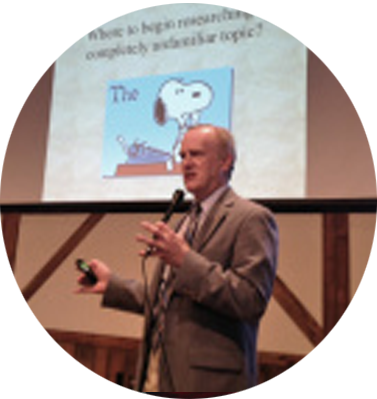 DON HAGISTis a life-long British Army researcher and founding member of the 22nd Regiment of Foot (recreated). His scholarly career includes preparing and publishing numerous editions of period primary sources and analytical articles for the living history community. Most recently, Hagist has written two major books.
DON HAGISTis a life-long British Army researcher and founding member of the 22nd Regiment of Foot (recreated). His scholarly career includes preparing and publishing numerous editions of period primary sources and analytical articles for the living history community. Most recently, Hagist has written two major books.
The first, British Soldiers, American War examines the Revolutionary conflict through the eyes of British soldiers’ narratives. The second and more recent is The Revolution’s Last Men, an exploration of the last veterans of the War for Independence who were captured through early photography. Hagist runs his own blog and is a regular contributor at the Journal of the American Revolution
British Army Muster Rolls: A Readers Guide
In our last installment of the 'Research Story' series, we opened the door to the great cavalcade of eighteenth-century British Army demographic information known as the muster roll (found in the WO12 series in the British National Archives). Of course, even more demographic information is contained in the general review returns (WO27), but that is a story for a different time. For now, I’ll focus on how one “reads” a British muster roll, because they aren’t necessarily straightforward to people who haven’t internalized British military procedure as I have. Or so my friends keep telling me.
Here is a photograph (taken in 2011, pardon the quality) of the muster roll for Captain Robert Clayton’s Company of the 17th Regiment of Infantry, covering the period from December 1775-June 1776. As you can see, it is a multi-part document, following a standard format that you will find with any other regiment’s muster roll (with a tiny few exceptions). So even if you aren’t in love with the 17th, the following instruction is transferrable to other corps.
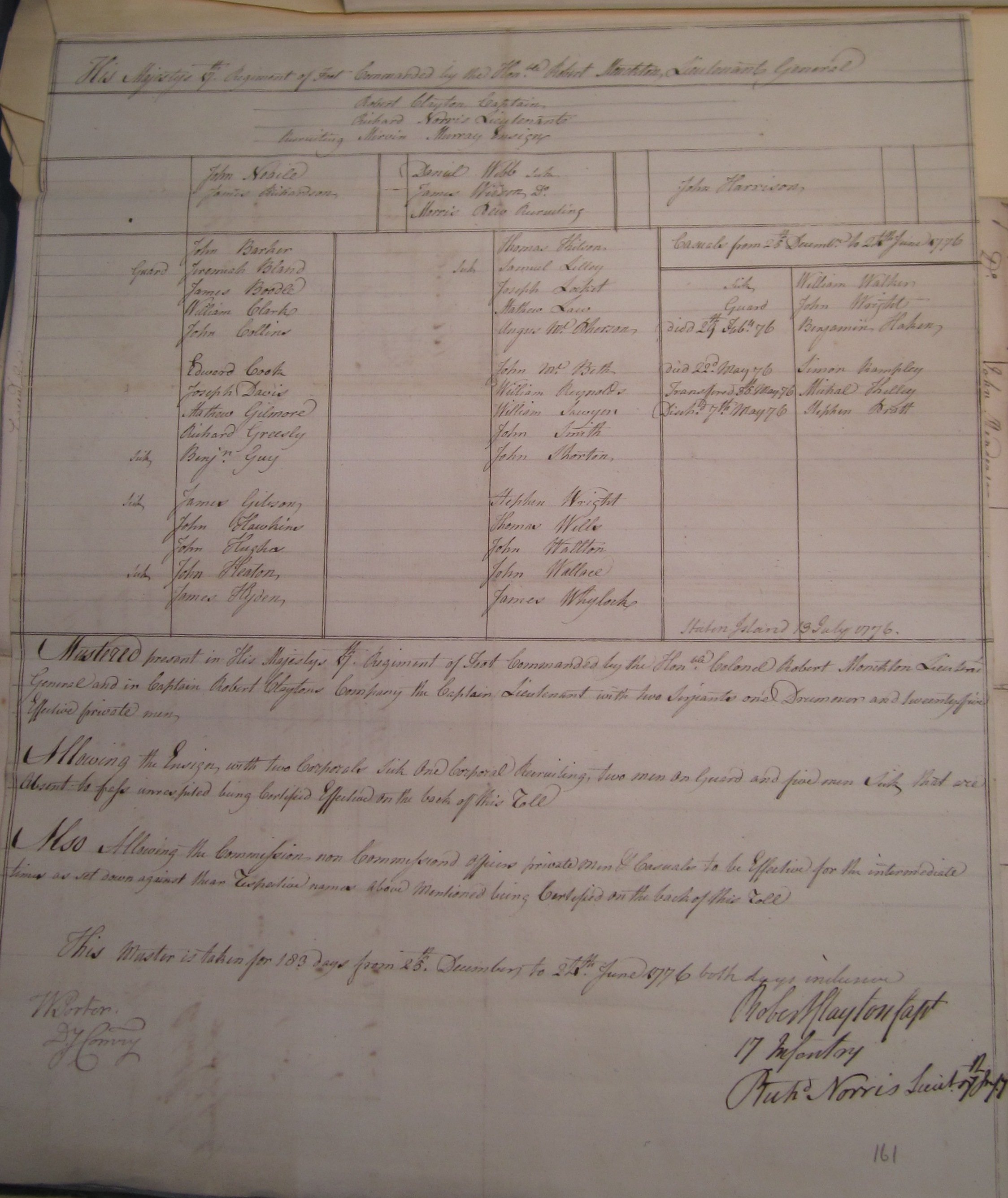 Most folks raised in the western tradition will want to read these from the top-down rather than the bottom-up, despite the fact that your most important information for understanding when and where is down near the bottom. So we’re going to look at the bottom first, for the most important material. Then we’ll move back to the top. And then deal with the center portion, where everyone inevitably ends up.
Most folks raised in the western tradition will want to read these from the top-down rather than the bottom-up, despite the fact that your most important information for understanding when and where is down near the bottom. So we’re going to look at the bottom first, for the most important material. Then we’ll move back to the top. And then deal with the center portion, where everyone inevitably ends up.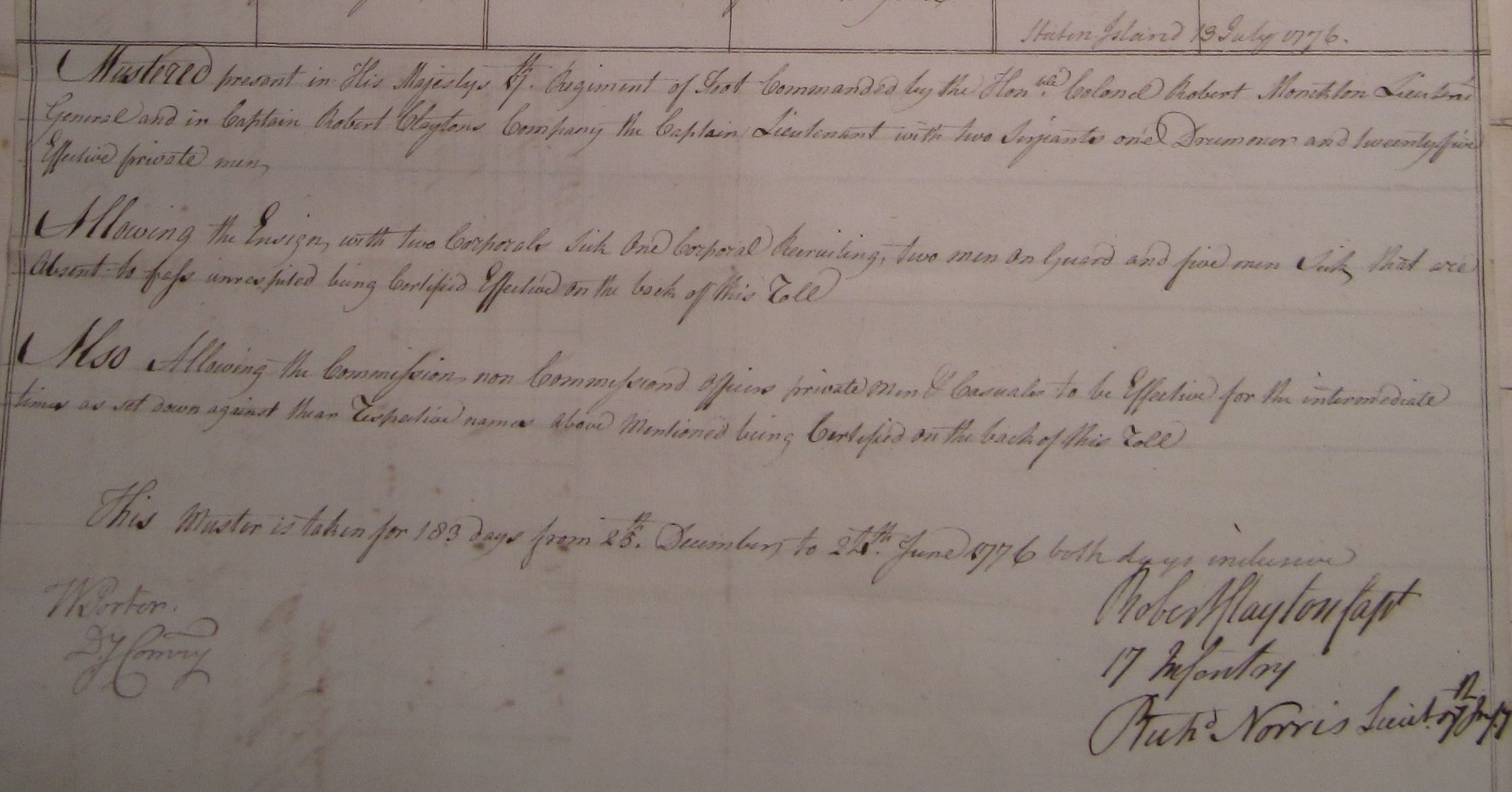
In this view of the document’s bottom half, we see several important pieces of information. First, there’s the location and date when the muster was taken—in this case, on Staten Island, July 13, 1776. Beneath that, you have a written synopsis of the information rendered above, which I’ll transcribe since the photo is blurry:
“Mustered present in His Majesty’s 17th Regiment of Foot Commanded by the Honble Colonel Robert Monckton Lieutenant General and in Captain Robert Claytons Company the Captain, Lieutenant with two Serjeants and Drummer and twenty five Effective private men.
Allowing the Ensign, with two Corporals Sick One Corporal recruiting, two men on Guard and five men Sick that are Absent to pass unrespited being Certified Effective on the back of this roll
Also allowing the Commission, non Commissiond Officers private Men & Casuals to be Effective for the intermediate times as set down against their Respective names above Mentioned being Certified on the back of this roll
This Muster is taken for 183 days from 25th December to 24th June 1776 both days inclusive”
This eighteenth-century military legalese is concerned with the prickly question of paying the army. Parliament passed an annual bill to fund the army, which was always subject to intense debate and scrutiny. From that point on, essentially every penny expending for military support had to be accounted for, since a scandal on misappropriation of funds or embezzlement could have dramatic negative effects on the army’s funding for the subsequent year. While plenty of period sources suggest that mustering was often accompany by significant bouts of corruption, with officer’s servants mustered to bring up the numbers of soldiers in a company to establishment strength, in general this process seems to have been taken fairly seriously by the Revolutionary War era. It is always important to note the date and location where the muster was taken and the dates the muster covers: in many regiments, several muster periods would be accounted for at one time, covering lengthy periods (sometimes extending to years) wherein the regiment could not be gathered and formally counted. A British regiment was expected to be mustered at six month intervals, so twice every year. Even if those musters couldn’t be made at the established intervals, the paperwork needed to be filled out at some juncture to satisfy officials in the Treasury Office.
Heading back to the top, we see the first of the detailed name information contained in this return:

Beneath the unit identification and the colonel’s name, you see a list of the company’s officers: Captain Robert Clayton, Lieutenant Richard Norris, and Ensign Mervin Murray. Murray is listed on the recruiting service, meaning he is back in the British Isles with a serjeant and detachment of men attempting to drum up new recruit. Clayton and Norris were present with the company on the day of the muster--- when you see notes on the return that explain a man’s absence, that is only the excuse given for him being absent that day. So Clayton could have been on command at headquarters, far away from his company, the preceding day. That was one way officers could, theoretically, cheat the system: by being absent every day save for the muster and hiring local men to stand in for soldiers for the muster. Not as easy to pull off in America, however.
Below the officers, you have the list of non-commissioned officers. These are the serjeants, corporals, and drummers. In most returns, they will be labeled as such, though not here. Looking at the information from the bottom of the return, we would expect to see two serjeants, three corporals, and one drummer listed, and so they are. As in that synopsis, Serjeants John Neaile and James Richardson are present, along with Drummer John Harrison. Corporal Daniel Webb and Corporal James Wilson were ill on the day of the muster, while Corporal Morris Rew was off on the recruiting service, probably with Ensign Murray.
Now moving to the center portion of the return, we see two primary sections. The two columns to the left list all of the men who were expected to be with the company on muster day, including the excuses for those men who were not physically present. The right-hand section lists all of the causalities for the period of the muster: that includes men who left for any significant reason.
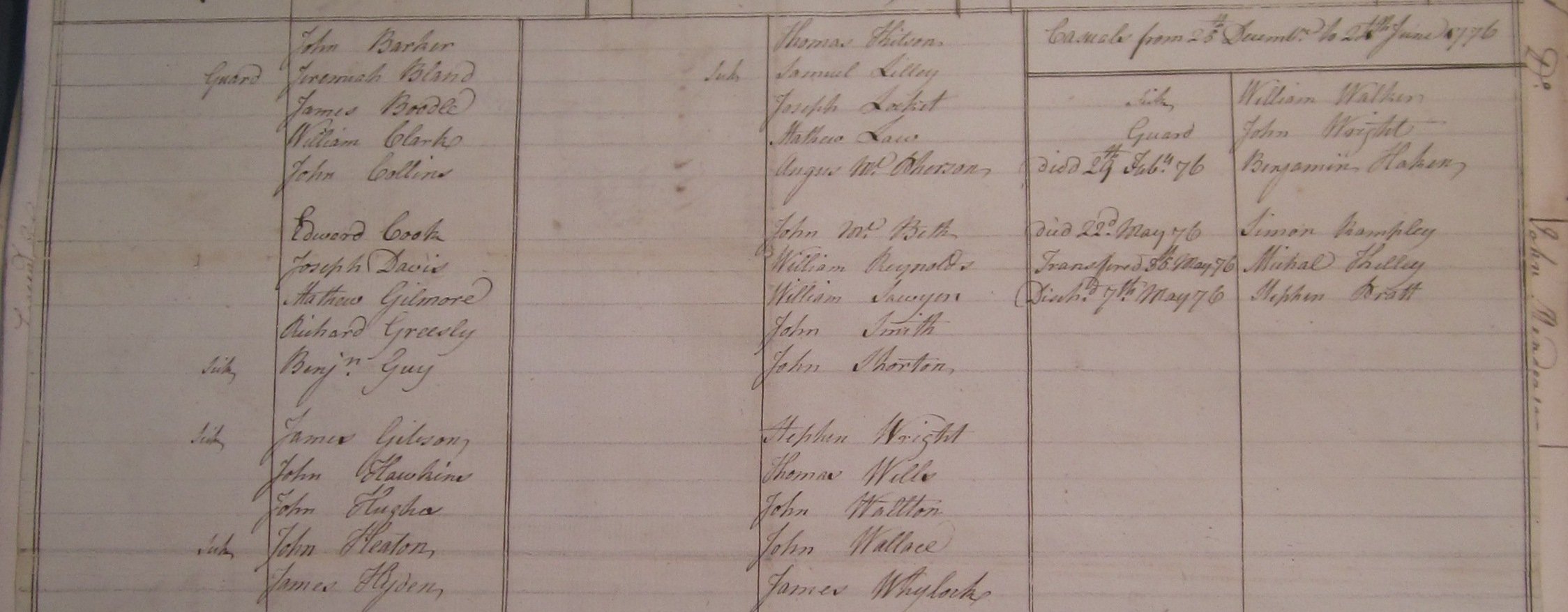
Focusing in on the casualty list, we see that it covers the same period as the rest of the muster and provides some interesting casualties beyond the men who died.
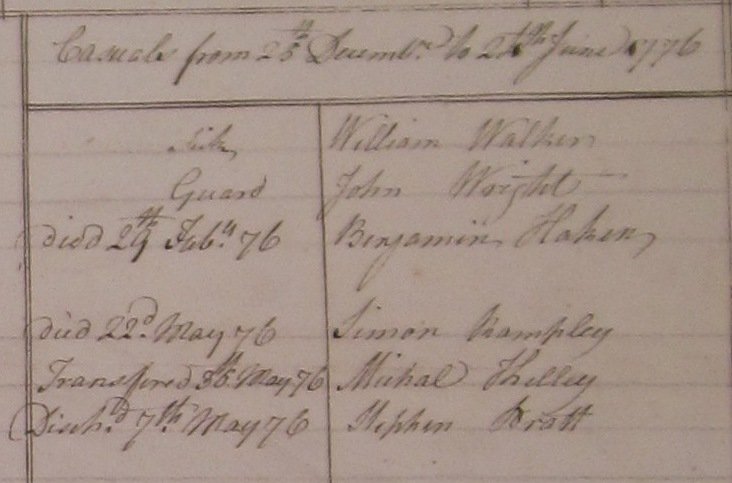 Here’s another transcript for you: “Sick William WalkerGuard John WrightDied 29th Feby 76 Benjamin HakenDied 22d May 76 Simon RampleyTransfered 35th May 76 Michal KelleyDischd 7th May 76 Stephen Bratt”
Here’s another transcript for you: “Sick William WalkerGuard John WrightDied 29th Feby 76 Benjamin HakenDied 22d May 76 Simon RampleyTransfered 35th May 76 Michal KelleyDischd 7th May 76 Stephen Bratt”
Walker and Wright both stand out as outliers—plenty of the soldiers listed to the left were either sick or on guard. Perhaps the muster master forgot to list them and thus stuck them under the Casualties? Maybe Walker was seriously ill and Wright had been sent to a long-term guard detachment? The return doesn’t indicate answers, hence we call these leads for further research.
Beneath Walker and Wright, one sees the standard list of men who died. It was highly unusual for a six month period to pass without deaths in the regiment. You’ll see both the soldiers killed in battle as well as those who succumbed to disease, wounds, or accidents listed in this area, usually without any further explanation other than their official date of death. We also have Private Kelley, who transferred out of this company, probably into another company of the 17th. Often, when a regiment is drafted, you’ll see notations made adjacent to soldiers’ names about when they left and which corps they joined. Similarly, when men are drafted into a regiment, you’ll see that noted, usually with the comment “Enter’d” followed by the date. The same style is used for new recruits, so sometimes things can be a bit confusing when you know that men are being drafted and recruited in, but the muster master didn’t make a note. That’s why we use a range of sources together to correct for the weaknesses in individual sources. This particular sheet is fairly routine, only have a mix of sick and guard duty listed.
So there you have your basic guide to reading a British regimental muster roll sheet: while they can be tiresome one at a time, taken collectively they open up grand new vistas on the busy internal life of the British Army. We are reliably informed that Don Hagist is working on a massive muster roll project, recording all of the surviving data on British regiments that served in America into an interactive digital spreadsheet. Can’t wait to see those results! For more 17th Regiment-specific data, keep your eyes out for future posts here.
 WILL TATUMreceived his BA in History from the College of William & Mary in Virginia in 2003, and his MA and PhD from Brown University in Rhode Island in 2004 and 2016. His exploits in Revolutionary War Living History began with a chance encounter at Colonial Williamsburg’s Under the Redcoat event in 2000.
WILL TATUMreceived his BA in History from the College of William & Mary in Virginia in 2003, and his MA and PhD from Brown University in Rhode Island in 2004 and 2016. His exploits in Revolutionary War Living History began with a chance encounter at Colonial Williamsburg’s Under the Redcoat event in 2000.
Over the subsequent years, he has traveled throughout the United States and Great Britain researching the eighteenth-century British Army and used the results of those labor to improve living history interpretations. The beginning of this journey in 2001 marked the start of the current recreated 17th Infantry.
The Things We Carry
First of all happy Wednesday! Before we get into today's blog post I wanted to mention that we have a news letter that will be starting to send out every Monday in June! So if you haven't yet signed up for the newsletter please feel free to do so. No spam, just 17th updates and a few short history lessons.
Now this week on the blog we have a Damian Niescior, most of you may know Damian from his work experience at Fort Ticonderoga in upstate New York, but now he serves as a Gallery Educator at the new Museum of the American Revolution in Old City, Philadelphia, PA, continuing to chat history to visitors. This blog post has been requested by some readers and is very informative in everything that Damian carries on his person to events has a purpose, can be easily stowed away in pockets, haversacks, and knapsacks, and nothing is there "just for looks". Enjoy the read!
Mary Sherlock - A follower attached to the 17th Regiment of Infantry
“They carried the sky. The whole atmosphere, they carried it, the humidity, the monsoons, the stink of fungus and decay, all of it, they carried gravity.”― Tim O'Brien, The Things They Carried

Throughout my time as a historical interpreter, both amateur and professional, I have been asked a fair amount on what I carry and why I carry it. I find it’s important to represent the soldiers as best we can as individuals, which includes minute details that may not even have a chance to see. These items also allow me to be self-sufficient while at events, keeping myself from needing to return to a vehicle. These items are both small and large, but all carry some significance to the interpretation of soldier life on campaign.
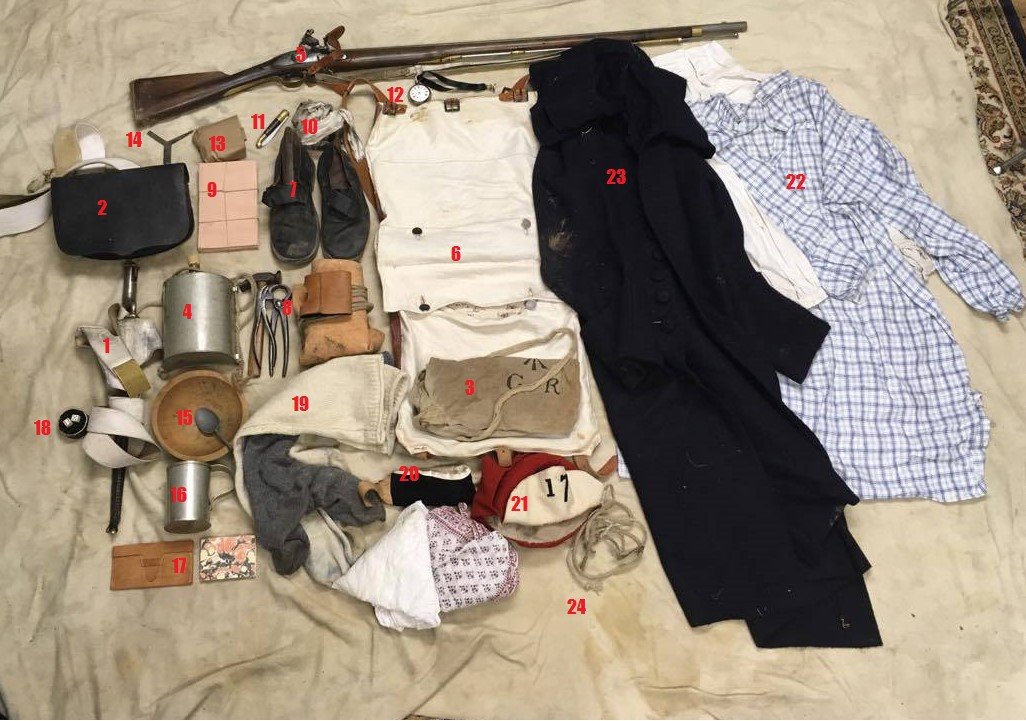
- The very first thing put on is the bayonet belt. It carries the sidearm, the bayonet, a triangular shaped blade of about 18 inches long. It is supported by the scabbard which sits in the belt itself. The buff leather belt is based off of several surviving originals, and although it is a waist belt, it is worn across the shoulder as a field modification to improve comfort.
- The next item we put on is the cartridge pouch. This pouch is a soft leather bag sewn with a hard leather flap to protect the cartridges inside. The cartridges sit in a wooden block, nailed into place by a series of small iron tacks, and can hold 21 cartridges. The white shoulder strap is, like the bayonet belt, made from buff leather. This pouch is of an older style, originally designed and used during the 7 years’ war, but then with a wider strap and extra square buckle. The pouch was modified to conform to the Royal Clothing Warrant of 1768. The 17th, months before the start of the war in 1775, ordered new cartridge pouches in an effort to replace the older outdated ones they were still carrying. Through the orderly books, although they had ordered the new pouches, they did not arrive in time for the 17th’s voyage to America in mid-1775.
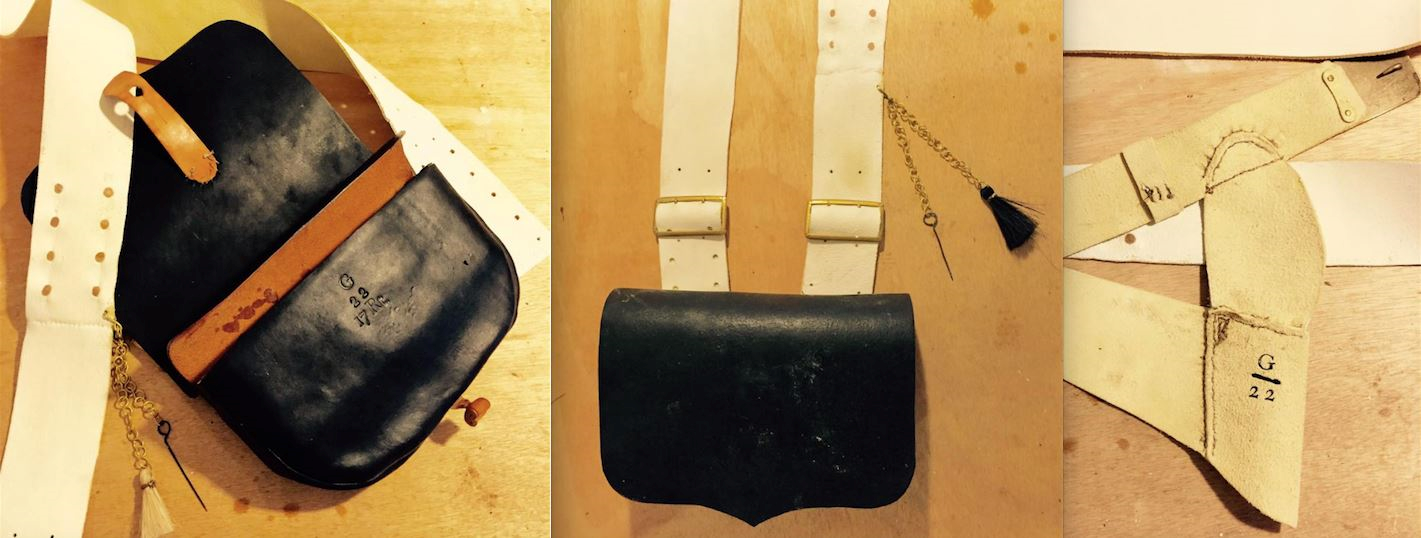
- Over the buff accoutrements, camp equipment is then placed, starting with the haversack. The haversack is a coarse linen bag, closed with two buttons on the side and suspended by a strap made from the same cloth. Its job is to hold the rations of each individual soldier. These rations were issued out once per every three days, which could include daily rations of one pound of flour or bread, one pound of beef or one half pound of pork, one quarter pint of peas, and one ounce of rice.
- Next is the canteen. The canteen is made from tinned iron, and suspended with a thin hemp rope. To help prevent rusting, beeswax is melted inside the canteen and shaken around to coat the interior. The canteen itself is made after an original, which had a tin cap for the spout as well. I, however, lost that cap a long time ago, and have since been replaced with a cork.
- The musket is the Short Land pattern, or second model, and also known as the Brown Bess. This musket is made from walnut, iron, steel, and brass. It features a 42 inch long barrel and its total weight is eight pounds. Completed with a buff leather sling to finish the look and assist with the carrying of the gun itself.
We have now reached the knapsack itself, which has many items inside it, each one I have carefully chosen to represent what a British soldier might carry in their pack.
- The knapsack itself is of a simple construction. It is primarily a hemp linen pack with two large pockets on each half. Each pocket is closed with two buttons made of pewter. The exterior of the knapsack is painted to repel rain and other weather. The knapsack is closed by three leather straps with conjoining buckles, and the pack itself is worn on the back with two shoulder straps made of leather as well. In the bottom half of the pack I keep tools and utensils, and clothing in the top half of the pack.
- An extra pair of shoes. At the height of the war, Britain was shipping nearly 40,000 pairs of shoes to supply its army with 2 pairs of shoes per man, per year. As I wear one pair of shoes on my feet, the others sit in my knapsack. There does seem to be some great relief when putting on dry shoes after walking in wet shoes all day.
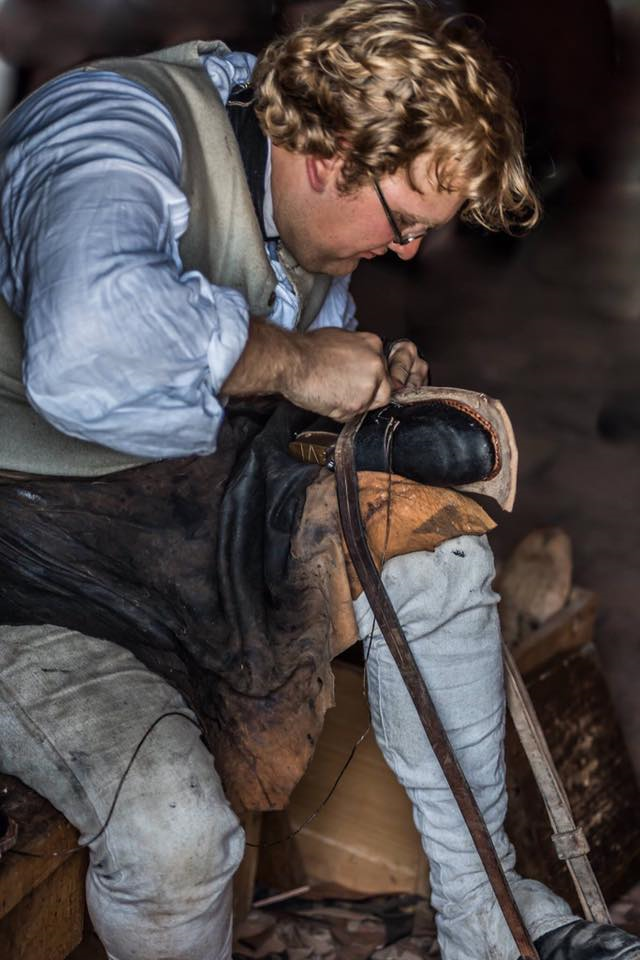
- Shoe tools; a hammer, lasting pliers, a set of pincers, leather palm, and awls wrapped up in a leather apron. While I was an interpreter at Fort Ticonderoga, I was an apprentice shoemaker studying under Mr. Pekar. Under his tutelage I developed some skills as a shoemaker, including the ability to repair shoes that had needed new soles and heels. The British army of the 18th Century contained a great deal of tradesmen, and many of them were shoemakers. These shoemakers, although soldiers first, facilitated the repair of shoes in the army.
- Donation soles. These soles, bound together with a simple tie, were issued to each man for each pair of shoes. It is typical for the average soldier to wear through soles in 3 months, but with two pairs of shoes per year means that the average soldier will wear each pair for six months. In order to bridge this gap, the British Army provides enough replacement leather for new soles and new heels for each pair. This is not in the assumption that each man has the skills required to repair his own shoes, but in the assumption that, due to the prolific nature of the shoemaking trade, each man will know a shoemaker in their own mess group or company willing to do the work.
- In order to keep the shoes I carry both presentable and healthy, a black polishing agent known as blackball is kept with my other tools. Blackball is a combination of charcoal, tallow and beeswax. The substance itself, when properly applied, returns a black finish to shoes while also keeping the leather from becoming too dry. Each soldier was issued an amount of blackball to maintain the shoes and black leather pouch.
- A small folding knife. This small folding knife has assisted me in more ways than I can mention. It has been a tool in cutting leather, a cooking utensil, a screwdriver and several other useful applications throughout the years.
- A pocket watch. Watches are especially useful to the life of a soldier. Although 18th century watches are impossibly complicated and expensive today, in the 18th century they were commonplace.
- Extra cartridges carried in a small brown package. In order to keep myself self-sufficient as the British Army could be, in addition to the 21 cartridges I carry in my pouch, I also carry additional ammunition in my knapsack.
- Musket tool. This reproduction of a musket tool is based off an original, and is used to maintain the musket. The tool itself is the only device needed when disassembling a great majority of the gun itself.
- A wooden bowl and pewter spoon. For my own comfort, I carry my own eating utensils. Although individual soldiers did carry their own bowls, soldiers would also eat out of the same kettle, removing the need to carry a bowl while on campaign.
- A tin cup. This reproduction of a cup, found at a British army encampment in North America, is a useful item to have when in the field. It can serve as both a drinking vessel and as a small cooking utensil as well. While I’ll admit that some of the worst coffee I have ever had, has been made in that cup, it is also the best coffee I have ever had.
- Wallet and notebook. Two items I have found to help remove myself from the 21st century when I am in the field. The wallet holds any cash I might use to purchase goods while at events, and the notebook allows me to jot down any thoughts or any notes I can review later.
- A pair of dice and snuff tin. We can’t have a good soldier impression without some vices thrown in! The dice I carry allows me to partake in a very old game known as Hazard. This game was very popular with soldiers; it required only a pair of dice and an understanding of the game itself. The snuff tin carries a small measure of snuff tobacco. Snuff is powdered tobacco taken through the nasal passage in very small quantities. Due to its unique method of inhalation, often the public use of snuff can come with strange looks from visitors.
- Two pairs of stockings. Each British soldier, in order to keep feet dry and healthy, would carry a number of extra stockings. I carry two extra on top of the pair I would be wearing, in total three pairs. There is something to be said of the quality of dry socks.
- Neckstock, one linen kerchief, and one cotton kerchief. A British soldier of the period would have a few items of neckwear. The one worn while on parade or battle, would be the neckstock. This garment is made of black velvet and finished with a false white shirt collar. This garment provides the soldier with a clean, military look. When the neckstock was not worn, softer kerchiefs and rollers could be worn.
- Fatigue cap. In order to preserve and protect the cocked hat from unnecessary damage, a cap is worn instead. This cap is based off of description and a few pictorial representations in paintings of the period. It is kept in my knapsack when not in use.
- Two shirts. These two shirts, I carry based on orders issued to the 17th at various points during the war, consist of one white and one made of check cloth. Like the extra shoes and stockings, it allows me to change into dry undergarments. This is especially useful during the hot days which can leave a shirt drenched with sweat.
- Watchcoats are heavy wool overcoats which assist a soldier while posted on sentry or picket duty. The British army issued these to regiments as about one watchcoat per 6 men. These garments were shared, and made to fit most sizes. I can tell you from personal experience, that extra layer of wool is a boon when enduring difficult weather.
- Last but not least is the blanket. It is rolled up and attached with ties to the top of the pack. This allows the weight to be more manageable, and to keep the pack from becoming too bloated.
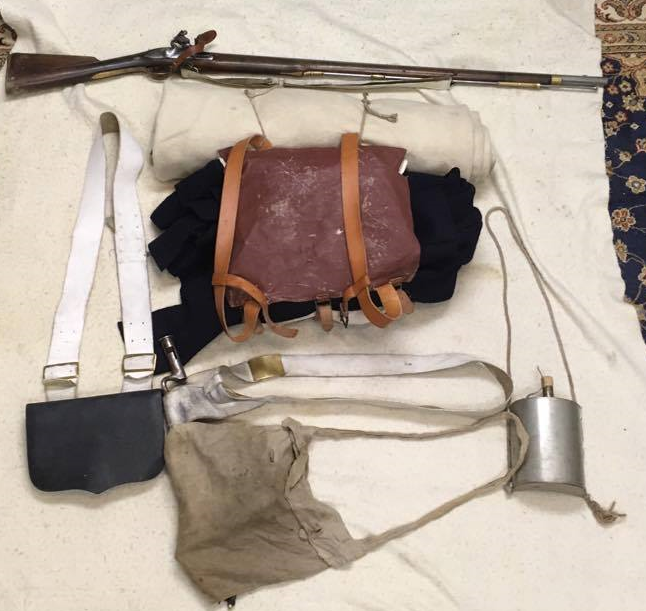
Each item is packed away carefully into the knapsack. Shirts are rolled up and pressed into the pack as efficiently as possible. The ending result is a tight, but efficient pack which weighs 20 pounds when fully loaded up. While these items all serve a purpose, each one a carefully chosen representative of items British soldiers of the period would have carried, this is as close I can come to understanding of what those soldiers would have endured. Those soldiers, serving thousands of miles away from home, would have carried a lot more than just items throughout the cities and wilderness of North America.
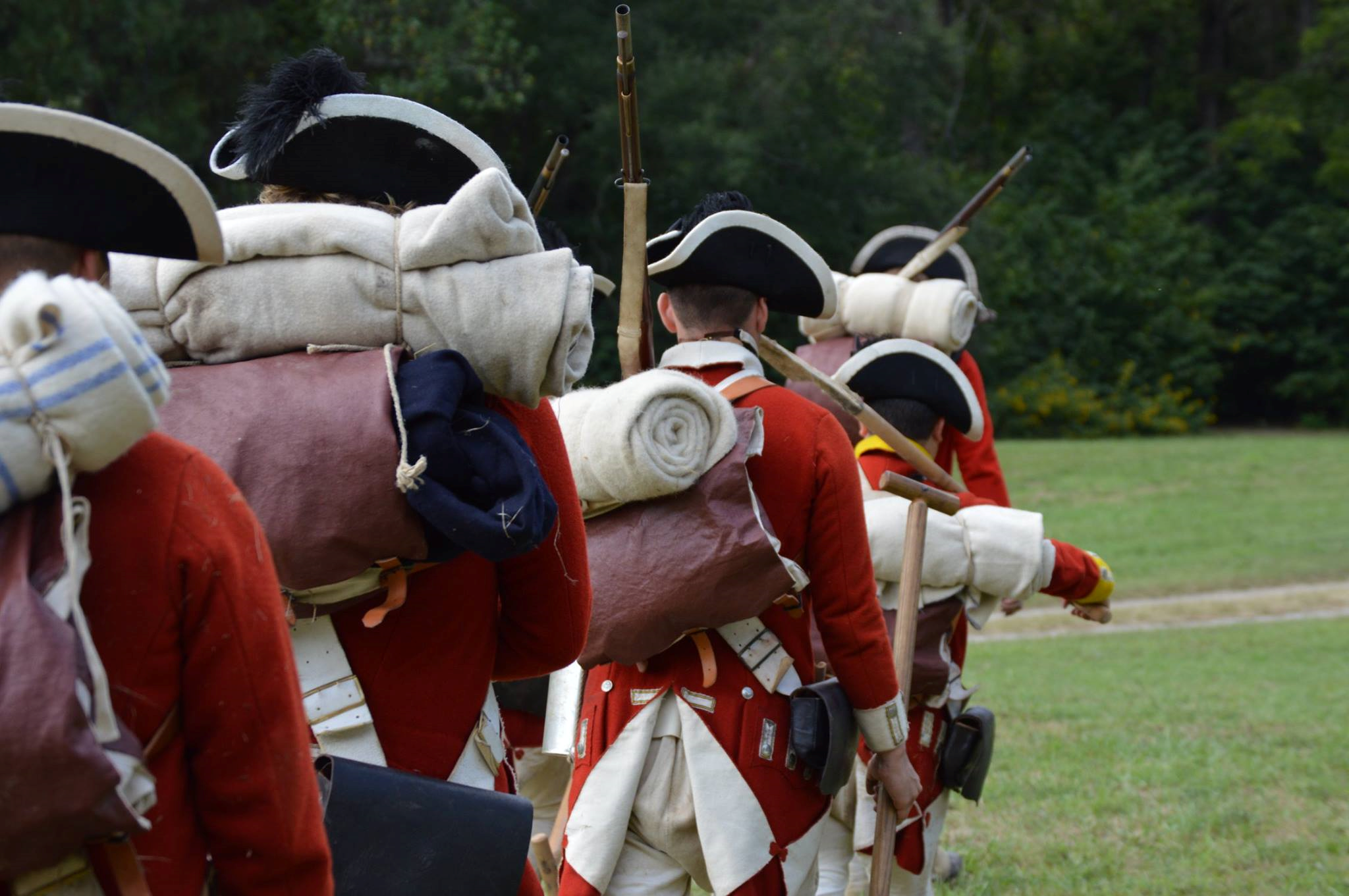
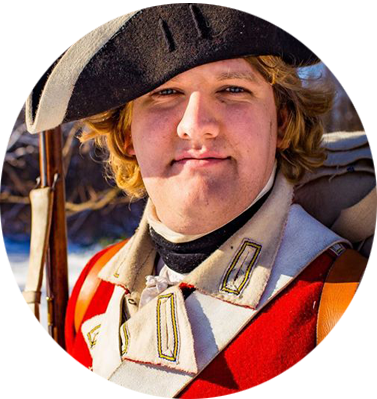
DAMIAN NIESCIORCurrently serves as Gallery Educator at the Museum of the American Revolution in Old City, Philadelphia, PA after serving as an interpreter at Fort Ticonderoga in Ticonderoga, New York. He has been reenacting and interpreting British soldier’s life since 2009.
Captain William Brereton and the Grenadier Company: Officers of the 17th, Part 2
In this second installment of the series, Mark Odintz, Ph.D., returns with a look at the officers who served in the 17th's Grenadier Company during the war. As always, we are grateful to Mark both for choosing the 17th Regiment for his studies and for sharing the fruits of his labor with our readers. If you enjoy these and Mark's other entries, please post in the comments: we're encouraging him to transform his dissertation into a book!
- Will Tatum
In this post I will provide sketches of the three officers who served in the grenadier company of the 17th during most of the American Revolution, with the addition of two others who joined it in 1781. For most of the period of the war the regiment contained twelve companies: eight companies of the line; two specialist companies, grenadiers and light infantry, known as the “flank” companies; and two “additional” companies that remained in the British Isles recruiting and forwarding men overseas to the regiment. Flank companies were usually detached from the regiment during the war and served in separate battalions of grenadiers and light infantry. Their officer compliment consisted of a captain and two lieutenants, in contrast to the average line company, which contained a captain (or field officer or captain lieutenant), a lieutenant and an ensign. Enlisted grenadiers were chosen in part for their height and physique, though this probably became less important on wartime service, when qualities of steadiness, toughness and endurance were paramount. For officers, service in the flank companies was prized as a vehicle for furthering one’s reputation, career and professional expertise. Eleven officers served in the light company of the 17th during the war, reflecting its almost constant active service and high level of casualties. The grenadier company, in contrast, though it saw hard service in the field, was officered almost entirely by three men, William Brereton, Gideon Shairp (or Sharp) and Lawford Miles, with two others, Alexander Saunderson and James Forrest, serving for the final two years of the war. Of the five three were Irish, one Scots, and one American, thus highlighting the national diversity of the officer corps during the American War.
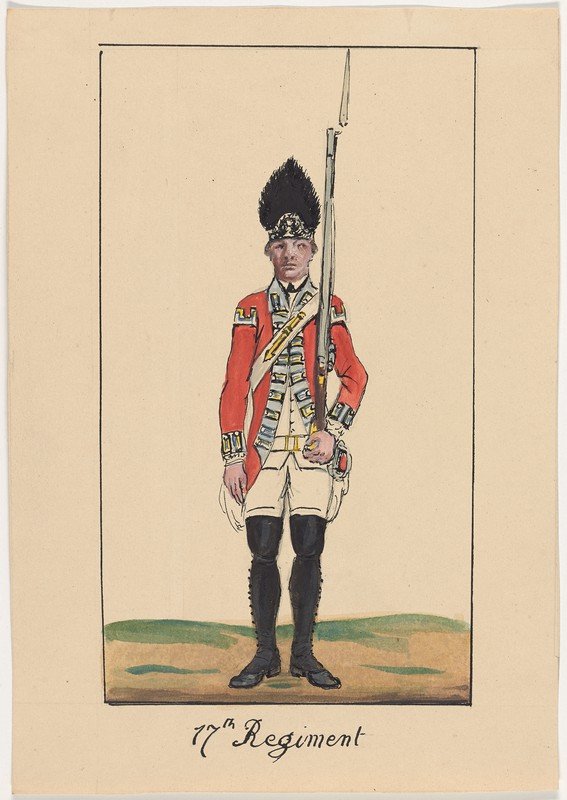
William Brereton, captain of the grenadier company of the 17th for much of the Revolution, is a classic example of the commitment of the Protestant Ascendancy of Ireland to military service. He came from a family of Anglo-Irish gentry that had come over to Ireland from Cheshire in the 16th century. His grandfather, William Brereton of Carrigslaney, County Carlow and Lohart Castle, county Cork, had served as High Sherriff of County Carlow in 1737. Our William’s father, Percival, was the third son, and died a captain in the 48th Foot with Braddock in 1755. Four of William’s uncles also served in the army, and his mother, Mary Lee, was the daughter of a general. A letter from William’s uncle Edward to Lord Amherst, soliciting a company for himself during the American Revolution, demonstrates the family ties to the military and how the connection had carried over into the next generation. He laid out his service and went on to state he “had 4 brothers officers, one of whom was killed with Braddock, and now 3 nephews in the Service.” (Burkes Family Records, Brereton Family; WO34:154, f. 147 Edward Brereton to Amherst).
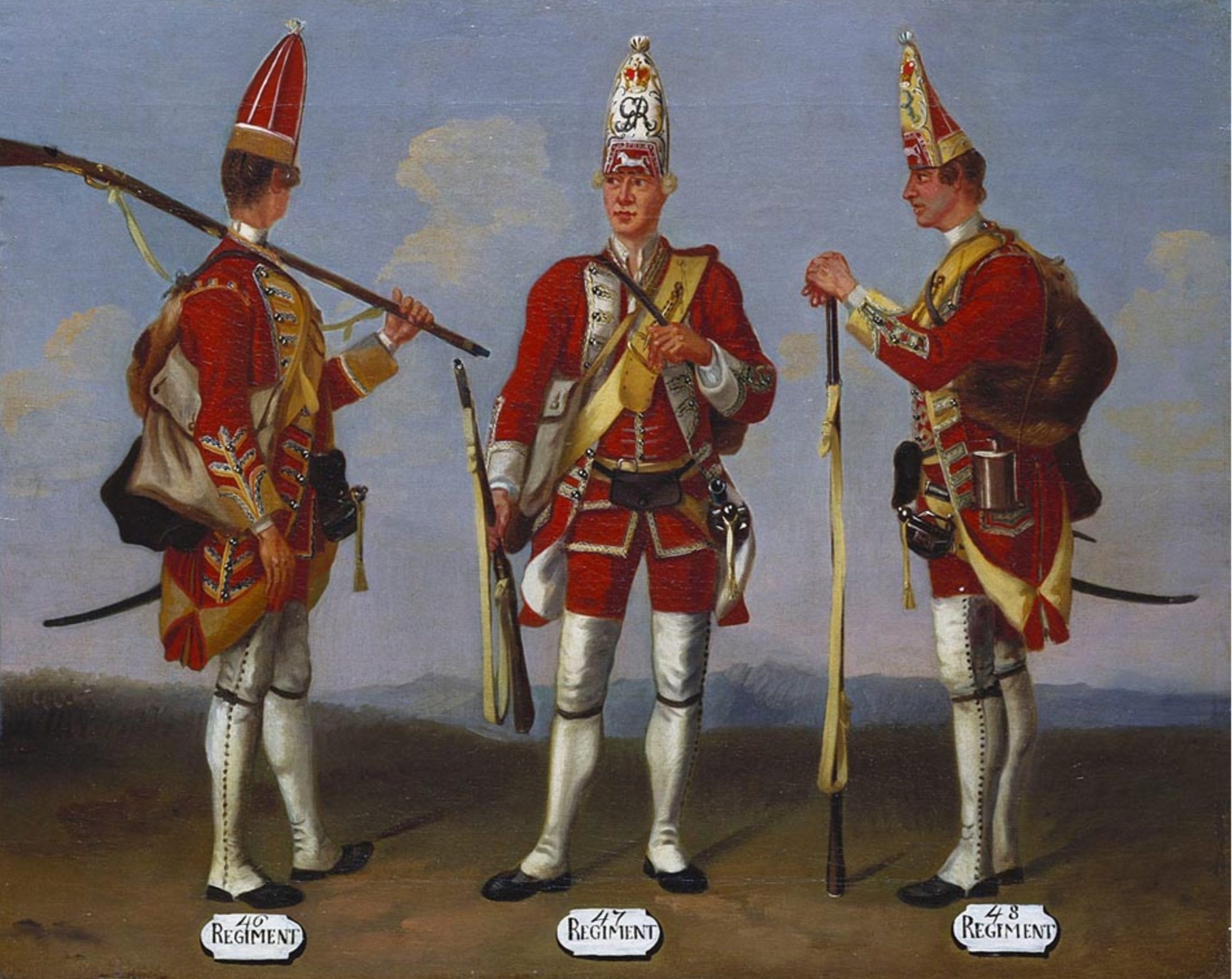
William was born in 1752 and purchased an ensigncy in the 17th on August 2, 1769. When Captain Edward Hope died in 1771, the succession went without purchase and Brereton became a lieutenant on Nov. 14, 1771. He became adjutant by purchase of the 17th in February, 1775 and continued to serve as adjutant until April of 1777. He purchased the captain lieutenantcy of the 17th on May 24, 1775 and purchased his captaincy later that year. He was commanding the grenadier company of the 17th by July of 1776 and, with the exception of a brief interval in July of 1780, continued to lead the grenadiers until he was promoted out of the regiment in April of 1781. (Record of service in WO25:751, f.217; dates of service in grenadier company from the rolls in WO12).
He was clearly an outstanding combat soldier, and distinguished himself during his six years as commander of the grenadier company. In 1779 his former commander, Earl Cornwallis, recommended him for promotion by summing up his service in the 17th- “He did his duty with the greatest spirit & zeal during the three campaigns in which I commanded the Grenadiers, but he more than once stepp’d forth when not particularly called upon, and without the too common apprehension of taking responsibility upon himself by his courage and good sense render’d essential service…” (WO1:1056, f. 317). One of his bolder exploits involved the capture of an American frigate, the Delaware, during the Philadelphia Campaign. On September 27, 1777, the thirty-four gun ship was attempting to deny the Delaware River to British shipping when it ran aground. A mixed force of British marines, sailors and Brereton’s grenadiers captured the ship, refloated it, and incorporated it into the Royal Navy. (Webb, Services of the 17th Regiment, pp. 73-73; Taafe, The Philadelphia Campaign, pp. 112-113).
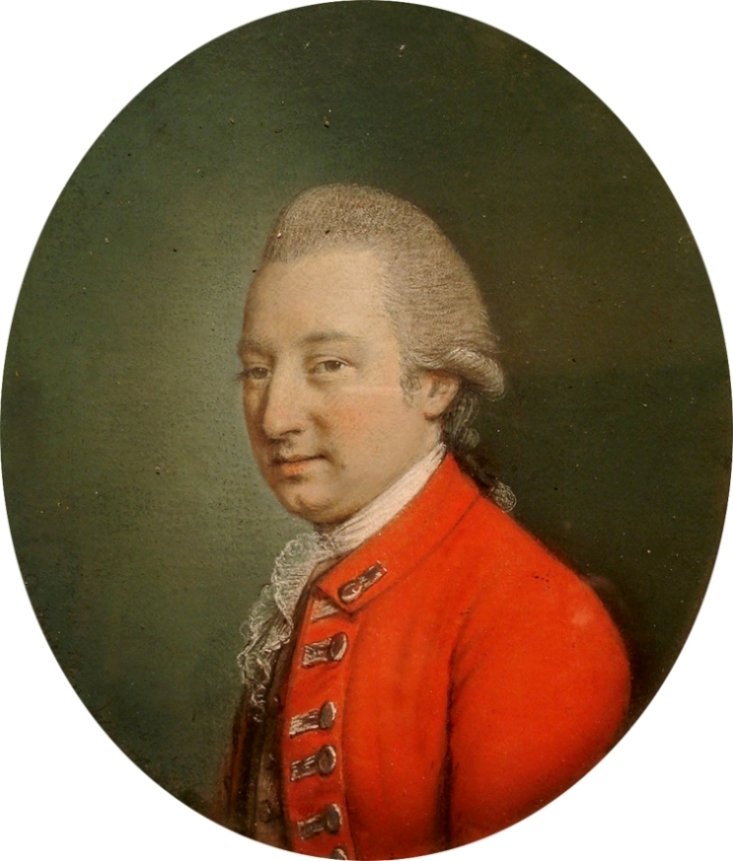
Perhaps the high point of his service as a grenadier came a few weeks later on the morning of October 11, 1777. An outpost on an island near Philadelphia under the command of Major Vatass of the 10th was surprised by a rebel force. Acting quickly and without orders, Brereton and Captain Wills, a grenadier officer of the 23d, put together a scratch force of grenadiers and Hessians, crossed over to the island, recaptured the post and rescued the garrison as it was being brought off by the rebels (WO71:84, Court-martial of John Vatass, 16 Oct 1777; and Court-martial of Richard Blackmore 21 October 1777). Continuing at the head of the grenadier company, Brereton was wounded at the battle of Monmouth in 1778.
After twelve years in the 17th Brereton purchased his majority in the 64th Foot in April of 1781. Late in the war Brereton commanded at one of the last successful British skirmishes of the war at the Battle of the Combahee River, outside Beaufort, South Carolina. On August 27, 1782, he was leading a foraging detachment (including a company from the 17th) from the garrison at Charleston when they were intercepted by an American force under Mordechai Gist and John Laurens (now of Hamilton the musical fame). Brereton ambushed the rebels, killing Laurens, capturing a howitzer and, after further skirmishes, returned to Charleston. He became a lieutenant colonel by purchase in the 58th Foot in 1789, and retired in 1792. Like many other retired officers he made himself useful during the lengthy crisis of the French Revolutionary and Napoleonic Wars by holding a number of other military appointments; serving as paymaster for a recruiting district, as an officer in the Wiltshire Militia, and as inspecting field officer of yeomanry for the Western District.
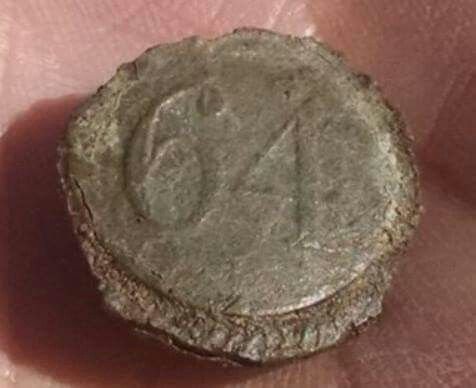
In 1784 William Brereton married Mary Lill, daughter of Godfrey Lill, Judge of Common Pleas for Ireland. Of his three sons who survived into adulthood, one entered the army and two served in the Royal Navy, continuing the tradition of military service. He lived at Chichester in England during his final years and died in November of 1830.
Gideon Shairp served as lieutenant of the company for the entire war. He came from a family of lowland Scottish landed gentry, the Shairps of Houston, co. Linlithgow (modern West Lothian). Born in 1756, he was the second son of Thomas Shairp, of Houston, whose children followed the classic pattern of gentry with strong ties to the services. Thomas, the eldest, inherited the estate, married and produced heirs; our Gideon entered the army, the third son went into the Royal Navy and the two youngest went into the army as well (family info from Burkes Landed Gentry, 1853, p. 1222 Shairp of Houston). Gideon purchased an ensigncy in the 17th on August 31, 1774, and was assigned to the grenadier company in August or September of 1775. As part of the augmentation of the army he was promoted to lieutenant without purchase on August 23, 1775 and served as the senior lieutenant of the grenadier company from 1775 through 1783. He purchased his captain lieutenantcy on Sept 14, 1787, became captain a month later and after twenty-one years in the 17th was promoted out as major to a new corps in May of 1795. He shifted to a more stable berth as major to the 22nd Foot in September of the same year and became lieutenant colonel to the 9th Foot in August of 1799. Gideon was serving as quartermaster general of Ireland at the time of his death in 1806. As far as I can tell, he never married. In his will he leaves his estate to his brother Walter, his baggage to his servant, and a ceremonial sword presented to him by the officers of the 9th to his friend, Major General Browning. (PCC Will proved 1806).
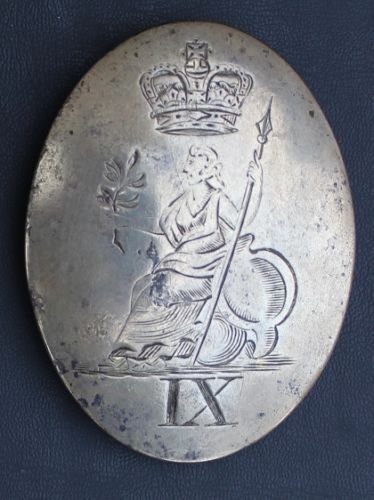
The third grenadier officer is another Irishman, Lawford Miles. His family was minor gentry in County Tipperary. His father, Edward Miles, gent, of Ballyloughan, died in 1778, leaving six daughters and five sons. At some point our Lawford inherited the estate of his uncle in Rochestown, and the family also owned land at Clonmel and Clogheen, all in Tipperary (Irish Wills, p.349; online list of Tipperary freeholders 1775-6) He entered the 17th as an ensign without purchase on May 1, 1775, and became a lieutenant, also without purchase, on September 8, 1775. He was serving as the junior lieutenant of the grenadier company by July of 1776 and served in the company at least until February of 1781. Miles purchased his company in the 17th on April 29, 1781 and was serving with the main body of the regiment at the surrender of Yorktown. He was the only captain chosen to accompany the regiment into captivity, and found his time as a prisoner had its dangers as well. He “was also one of the capts for whom the Americans drew lotts when Capt Asgill of the Guards was the unfortunate person” (WO1:1024 f. 775, Lawford Miles to Young, 7 Aug. 1784). This refers to the Asgill affair of 1782. In retaliation for the hanging of a rebel captain by American loyalists, George Washington responded by having British POWs of the same rank draw lots for hanging. Charles Asgill was chosen, but in the end the American Congress set him free. (see Digital Encyclopedia of George Washington, Asgill Affair). Miles retired from the 17th and the army in November of 1789. He died without heirs in 1809. Family sources style him as Colonel Miles at the time of his death, but I have found no evidence of further service in the regular forces. (BLG 1862, Barton of Rochestown).

Two other officers, Alexander Saunderson and James Forrest, joined Gideon Shairp in 1781 and served until the end in 1783. Saunderson was yet another member of the Irish gentry. The Saundersons of Castle Saunderson, County Cavan, came over from Scotland in the early 17th century. Alexander’s father, Alexander senior, was head of the estate and served as High Sherriff of Cavan in 1758. Our Alexander was the second son (see BLG of Ireland 1904, Saunderson of Castle Saunderson). Unfortunately for him, his father, at least according to family lore, fit the stereotype of the wastrel Irish gentleman. He was a spendthrift and a gambler and spent much of his time racing horses at Curragh and elsewhere. Rumored to have been a member of the Hell Fire Club in the Wicklow Hills, he became a wanderer after Castle Saunderson was damaged by fire. (Henry Saunderson, “Saundersons of Castle Saunderson”, 1936). Our Alexander was born circa 1756. He entered the army as an ensign in the 37th Foot on September 30, 1775 and became a lieutenant in the same regiment on May 20, 1778. He came to the 17th as a captain on April 29, 1781, and was Captain of the grenadier company by July of 1781. In 1783 the regiment was reduced from twelve companies to ten as the British army returned to the peacetime establishment, and Saunderson, as one of the two junior captains, was put onto the half pay. With the coming of a new crisis in 1792 he found his way onto active service by trading his half pay for a captaincy in the 69th Foot on June 30th. Saunderson remained in the 69th for the remainder of his career, becoming a brevet major on March 1, 1794, a major on July 1, 1796, and a lieutenant colonel on March 30, 1797. He left the service in 1800, and died childless in 1803, leaving his estate to his wife Aurelia. (PCC Will proved 1803)
Finally, we have an American, James Forrest, one of possibly eight or more in the 17th during the period of the revolution. He was born in 1761, the year that James senior, his father, moved the family from Ireland to Boston, so our James may have been born in Ireland. His father was a prosperous merchant before the war and lost his fortune as a result of his loyalist support of the British cause (E. Alfred Jones, “The Loyalists of Massachusetts”, 1930). James senior raised the Loyal Irish Volunteers in Boston in 1775, and contributed two sons to the British forces. Our James joined the 38th Foot as a volunteer in 1777. Gentlemen without the money to purchase or the influence to find their way into the service often joined serving regiments as “volunteers”, hoping to be appointed to vacant commissions after proving themselves in the field. James was wounded while serving with the 38th at the battle of Germantown and was appointed ensign in the regiment in October of 1777. A letter James wrote in March of 1780 seeking a company in a loyalist corps expresses the frustration of those trying to get ahead without financial means: “I have not the most distant prospect of promotion in the 38th, the repeated misfortunes my Father has met with since the commencement of the Rebellion put it out of his power to purchase for me.” (Clinton Papers, Forrest to William Crosbie, March 3, 1780). Instead of transferring to the loyalist units he was appointed lieutenant without purchase to the 17th Foot on February 19, 1781 and seems to have joined the grenadier company about the same time as Saunderson. James Forrest retired as a lieutenant in September of 1788.

Dr. Mark Odintz
conducted his graduate work in history at the University of Michigan back in the 1980s and wrote his dissertation on “The British Officer Corps 1754-1783”. He became a public historian with the Texas State Historical Association in 1988, spending over twenty years as a writer, editor and finally managing editor of the New Handbook of Texas, an online encyclopedia of Texas history. Since retiring from the association he has been working on turning his dissertation into a book. He lives in Austin.
Founding the Recreated 17th: A Research Story, Part 1
This week we have on the blog we have a guest writer who knows the ins and outs of the 17th Regiment of Infantry after establishing the Regiment back in 2002. When the 17th was recreated and established again in 2015 Dr. Will Tatum was the person that the newly formed 17th organization reached out to. Over the next couple weeks there will be a series of articles about the research and the hard work put into creating an organization. Hopefully, our readers will find the writing of Dr. Will Tatum insightful.
Mary Sherlock- An attached Follower of the Recreated 17th Regiment
Founding the Recreated 17th: A Research Story, Part 1
By Will Tatum
Every living history group has a history apart from the subject or topic it represents, an origin story all its own. Most of these stories begin in someone’s basement or garage, in a bar, or result from dissatisfaction with an existing unit. The recreated 17th’s story began with my research at the British National Archives (TNA) over the academic year of 2001-2002. In the summer of 2001 I completed my first year in the hobby and was just beginning to struggle with the process of turning research into a living history interpretation. Other members of the unit to which I belonged at that time suggested that, to avoid hobby politics, it would be best to select a corps around which I could develop my own impression as a sideline project. I reviewed a list of British regiments that had served in America during most or all of the war and had a short list of candidates in mind as I shipped out to Britain that September. Little did I suspect the ah-ha moment that awaited me in the greater London area.
After spending the autumn conducting research in Exeter, where I was studying abroad, I traveled to the TNA for the first time at the end of February 2002. One of my assignments from my then-unit was to track down records relating to soldiers who had served in America, in an attempt to flesh out data from muster rolls. British Army Historian Extraordinaire Don Hagist had suggested examining records from the Royal Hospital Chelsea, which King Charles II established in 1682 to care for deserving army veterans. Only a small set of soldiers were ever selected to receive pensions and even fewer were permitted to reside at the facility, which still exists today. Nevertheless, the surviving records of these “deserving” men provide important insights into the trials and tribulations of the eighteenth-century British soldier. Each of these men had earned referral to the Royal Hospital admission board through exemplary service, which left them physically battered and worn out, no longer capable of fending for themselves.
The specific records in question were contained in WO (War Office) 121, one of several series pertaining to the Royal Hospital’s operations. The documents contained therein mostly date from the mid-1780s onward, with the earlier ones covering men who had served during the American Revolution. While looking through these records, I repeatedly came across discharge documents for soldiers of the 17th Infantry, which I took to be a sign of the regiment that I ought to pursue. If for no other reason, there certainly seemed to be a great deal of surviving documentation on these men. Most of the would-be pensioners I encountered (these documents related to their applications for pensions and did not contain any signification of their success) were simply “worn out in service.” For example, William Dick, a common laborer from Auchtermuckly in Fife, Scotland, played the fife for 17 years before Lieutenant-Colonel Henry Johnson (who took over command of the 17th in 1778) recommended him for a pension in 1787. Joshua Waddington, another 17-year veteran discharged the same year, came from the parish of Litchcliff in Halifax, Yorkshire. At forty-two years of age, with no trade background other than unskilled labor, Waddington was disabled through “having sore legs & being Worn out in the Service.” Private Archibald McDonald of Fort William, Inverness, Scotland, had served 16 years during which he was “twice wounded” and listed as “under Size” at the time of his discharge in 1787.
These men, and many others, had served in the regiment during its service in America, though their discharges made no direct comment on that war. Others, however, contained much more pointed statements that testified to the 17th’s extreme service during the Revolution. On December 4, 1790, then-Major T. Pitcairn of the 17th (not a Rev War veteran) signed Private William Clarke’s discharge. On it, Pitcairn noted that 44 year-old Clarke, a 23-year veteran and native of Castle Carey in Somerset, by trade a cordwainer (shoemaker) was “entire worn out in the Service thro’ hardships & Fatigues sustained when in the Lyht [sic] Infantry during the late War.”
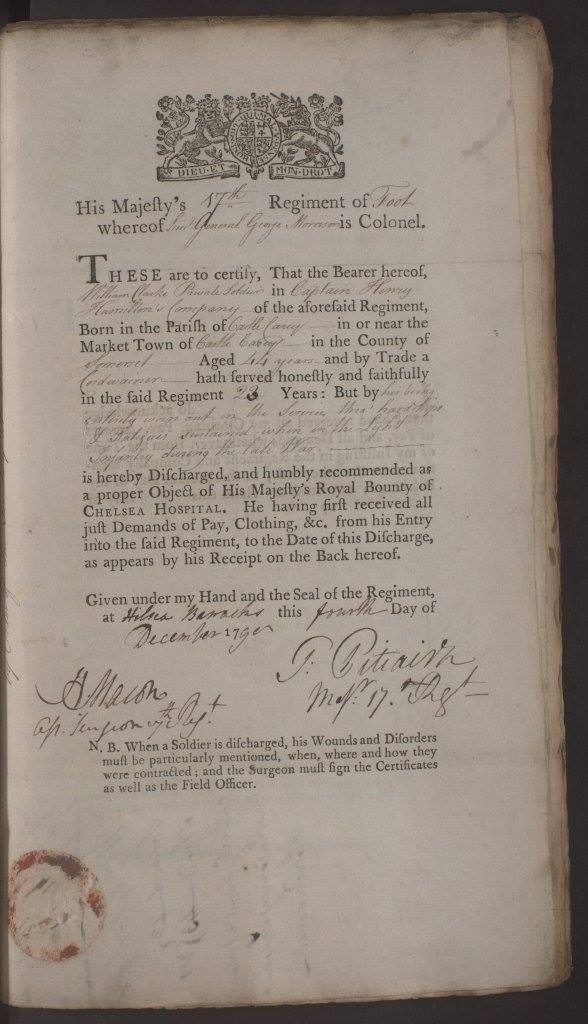
Discharge of Private William Clarke, WO121/9/352; Crown Copyright, Image reproduced by courtesy of The National Archives, London, England
Private John Clarke, a 47 year-old laborer from the town of Hereford in England, a 22 year veteran of the regiment, was discharged the next day, due to “his being Worn out in the Service thro’ hardships sustained during the late War.” Private William Boyd, a 13-year veteran of the regiment and by trade a breeches maker, received his discharge on December 11, 1790, at the age of 42. His paperwork noted that he was “Dropsical through hardships sustained when a Prisoner with the Enemy during the last War in America.” What does “dropsy” mean? Essentially, Private Boyd suffered from uncontrolled water retention between his skin and various body cavities, resulting in painful swellings.
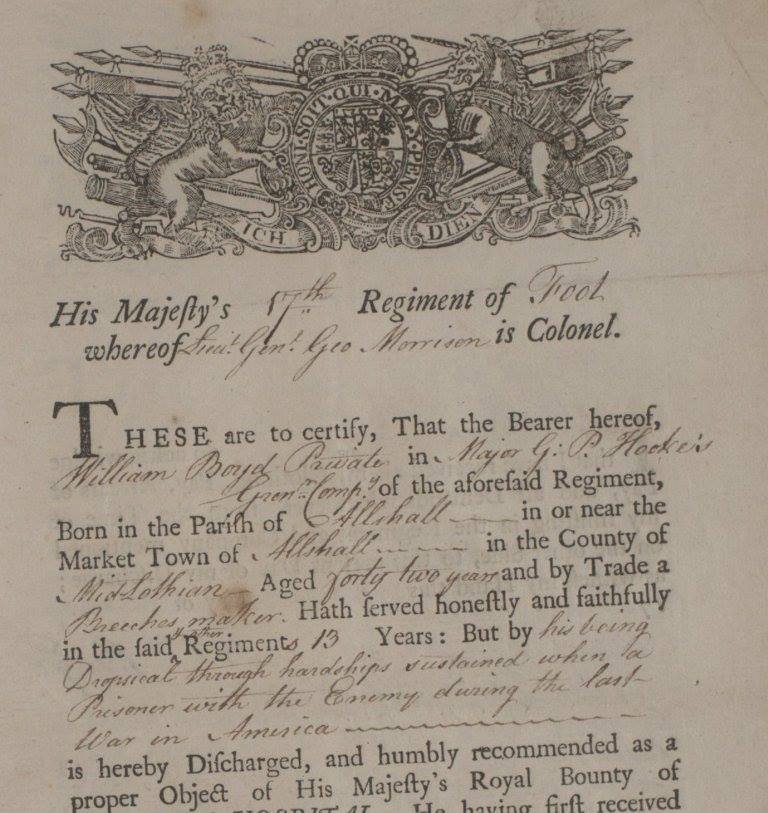
Discharge of Private William Boyd, WO121/9/350; Crown Copyright, Image reproduced by courtesy of The National Archives, London, England
If you think that is bad, I refer you to Serjeant Robert Saunders, a 25-year veteran of the 17th Regiment and a native of Amersham, Buckingham, by trade a baker, discharged on May 10, 1787, at age 42. Saunders had sustained wounds from “long & Severe Service & [was] Severely afflicted with a Fistula, rendred [sic] Incapable of Further Service.” I’ll let you look up what a fistula is on your own. For more tales like these (only with expanded details), check out Don Hagist’s blog British Soldiers, American Revolution.
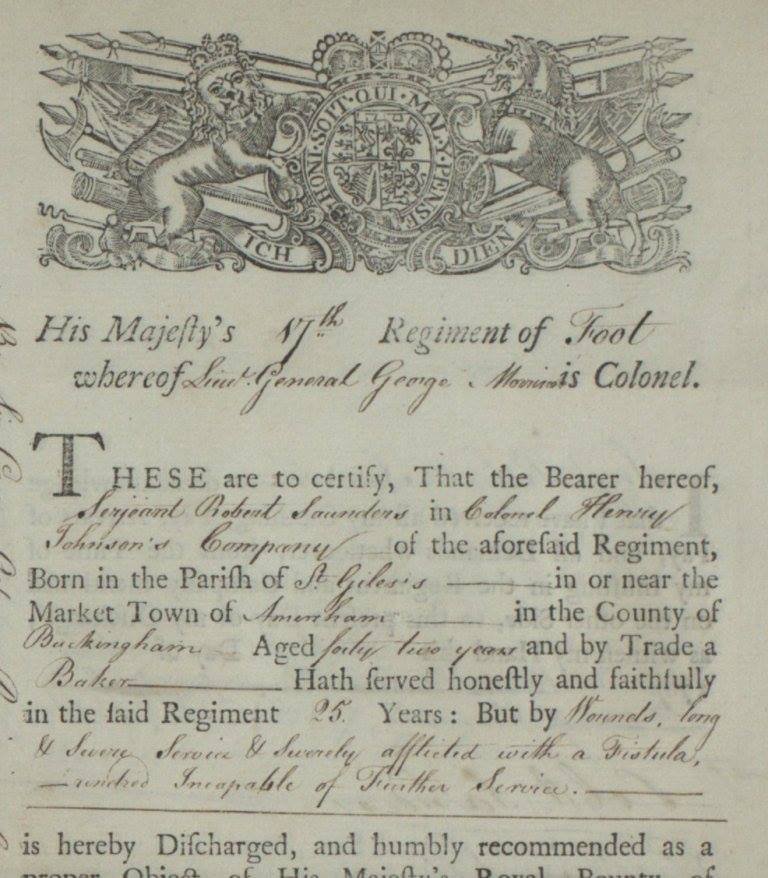
Discharge of Serjeant Robert Saunder, WO121/2/35; Crown Copyright, Image reproduced by courtesy of The National Archives, London, England
Seeing these documents and considering what they represented on a human scale decided me on exploring the 17th. In subsequent posts, I will explain how the other document series I examined accumulated to form the critical mass for creating a new style of living history group. In this respect, the recreated 17th stood apart from most other units existing at the time and since, in being a response to a research agenda rather than a hobby need. In essence, the horse came before the cart (the history came before the hobby politics) from the beginning.
 Will Tatumreceived his BA in History from the College of William & Mary in Virginia in 2003, and his MA and PhD from Brown University in Rhode Island in 2004 and 2016. His exploits in Revolutionary War Living History began with a chance encounter at Colonial Williamsburg’s Under the Redcoat event in 2000.
Will Tatumreceived his BA in History from the College of William & Mary in Virginia in 2003, and his MA and PhD from Brown University in Rhode Island in 2004 and 2016. His exploits in Revolutionary War Living History began with a chance encounter at Colonial Williamsburg’s Under the Redcoat event in 2000.
Over the subsequent years, he has traveled throughout the United States and Great Britain researching the eighteenth-century British Army and used the results of those labor to improve living history interpretations. The beginning of this journey in 2001 marked the start of the current recreated 17th Infantry.

